
Lovely story from [The Guardian](https://www.theguardian.com/lifeandstyle/article/2024/jun/28/experience-a-leech-lived-up-my-nose-for-a-month) >It was September 2014. I’d just started working front of house in a fancy hotel in Edinburgh. I spent most of my shifts with a paper napkin pressed to my nostril, as I had been getting lots of nosebleeds. I would soon find out why. > >A few weeks earlier, I’d been travelling in Vietnam. I had rented a moped and had the time of my life driving around. I soon crashed but luckily was wearing a helmet, so only got a small bump on my head. > >A few days afterwards, I started to intermittently spot blood from my right nostril. I assumed it was from the crash and didn’t think too much of it. I was 24 and too busy partying to take anything like that seriously. I danced the nights away while ignoring the persistent blockage in my nose. > >Reality came flooding back after returning to cold Glasgow. Nothing had changed with my nose, so I went to the GP. The doctor told me that it didn’t sound like anything to worry about. I was advised to use Vaseline on the area to keep the nostril lubricated and was sent on my way. > >A week later, I moved to Edinburgh for my job. That’s when I started to feel frustrated with my constantly stuffy nose. I wasn’t in pain, but sleeping was difficult. I would blow my nose to try to clear the blockage, but it would only lead to nosebleeds. Things started to get particularly weird when I was having showers. Through all the humidity, I could feel a thick, slimy thing moving down my nose. > >I had a day off work; it had been a month since I returned from abroad. My friend Jenny was coming from Glasgow to meet me for dinner. I was in the shower when I felt the all-too-familiar feeling, but this time I glimpsed something hanging out of my nostril. I jumped out and raced to the mirror, frantically wiping off the steam. I saw a clot hanging out – then recoiled in horror when I saw ridges running along a thick black body. > >I rushed out of the house to see my friend, screaming, “It’s a full-on worm!” Jenny knew about the problems I’d been having with my nose, but she didn’t believe me at first. I stuck my nose in the air so that she could see for herself. Her mouth hung wide as she gaped and said: “Yep, there really is a worm in there.” > >At first, it was the most hysterical thing that had ever happened to us. We couldn’t stop laughing. Because it had been in there for so long, I felt very blase about the whole thing. We rang the NHS helpline. The call adviser was crying tears of laughter over the phone, as it was the most bizarre thing she’d heard. > >We went to A&E. Doctors were bewildered and didn’t take me too seriously at first. But once the nurse looked up my nose, she gasped. I was placed on a gurney as they stretched my nostril open with forceps. The doctors spent 30 minutes using different tools to try to prise the leech away. Leeches release an anaesthetic when they bite so they can stay on a body for longer, which is why I couldn’t feel the pain before – but it was agony when the doctors tried to pull it out. When they finally succeeded, I felt a wave of cold air shooting through the blocked nostril. It was like being in a nightmare, seeing the leech held up high, squirming. It was longer than my finger. > >I’d swum a lot on holiday, so we guessed that it most likely came from there rather than having anything to do with the motorcycle accident. The leech was put in a jar and sent to a specialist hospital in London for further testing – they were worried that it may have passed on further diseases to me. Suddenly, something that was so funny seemed much more serious. > >Luckily, all of my tests came back clear, and I had no side-effects. I was given the leech back in a pot and told to dispose of it. The leech was rock hard because it had so much of my blood inside. It made me squirm just looking at it. > >Now, a decade later, the story of the leech and me has become a go-to anecdote whenever I meet someone new. I even had someone message me on LinkedIn recently asking about it. So while the leech was attached to me in a very physical sense, I guess we’re still attached metaphorically. But I’m very glad it’s out.
 quinacridone
3 months ago
•
100%
quinacridone
3 months ago
•
100%
Link to an earlier post about shrimp jockeys....
https://mander.xyz/post/11798834
....and a rather spiffy pic!

photo by Ludovic
 quinacridone
4 months ago
•
100%
quinacridone
4 months ago
•
100%
I like how you're thinking.... also a shrimp jockey jauntily attached to the head at the side (like a head broach)
 quinacridone
4 months ago
•
100%
quinacridone
4 months ago
•
100%
Fuch yeah! That is amazing!
So many possibilities..... Something frilly or sleak? Maybe neon/pearlescent? Spots, stripes? An Aeolid with a garnish of cerata, or a Dorid with a branchial plume? And don't forget a pair of magnificent rhinophores and optional Emperor shrimp jockey!
Holy shit I'm really excited for you! And I'm not the one making the costume or going to the party!
In fact as an autistic person I'd just spend hours of fun making a costume, and then not go to the party.... just wear it at home
You'll have to post your outfit when it's done 😀

Main image, Glossodoris Sedna by [Cajo Producciones](https://www.flickr.com/photos/cajjo/7078457083/in/photolist-7vShqR-ahGuci-7vW745-akpptg-g37Vif-bnCugN-bMuWFv-7CLA7-21jn7Yw-qHfsKZ-cEnq7y-2nfXPXj-2ng5rLZ-2ng6Mkc-2ng6M3J-2efvkxi-5dKBd5-c4nbXA-8x2KVy-yg2Hnw-hCww2d-hCvR1i-iT3zA-6kGgbM-7ND4Fb-H6zyv-5kdFRx-67caoE-8uzrZ3-gYyQ4m-5kgMn5-huhJAr-dGcCK1-hugP6S-7e3LcV)  Above Glossodoris stellatus by [digidiverdeb](https://www.flickr.com/photos/39623502@N02/3896520349/) 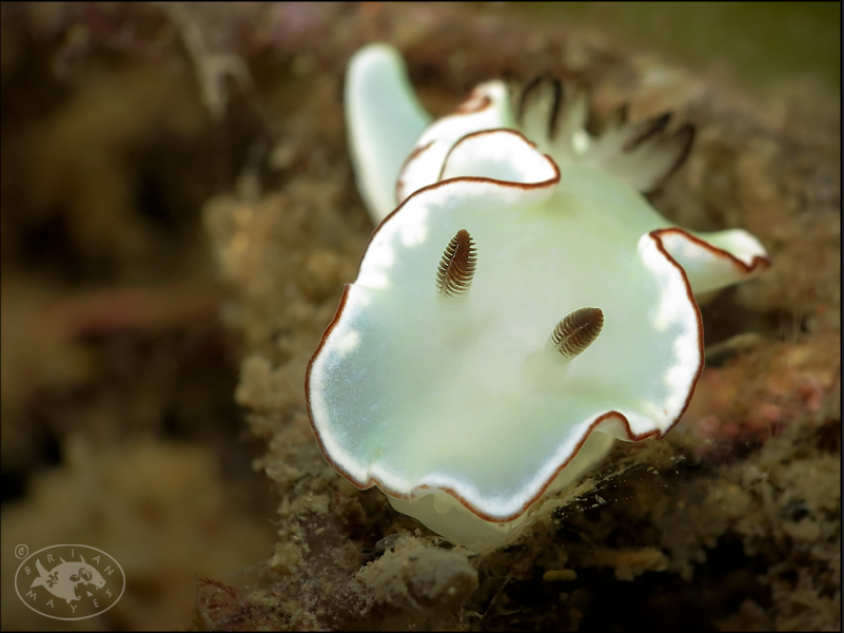 Above Glossodoris angasi by [Brian Mayes](https://www.flickr.com/photos/brianmayes/19303050476/) 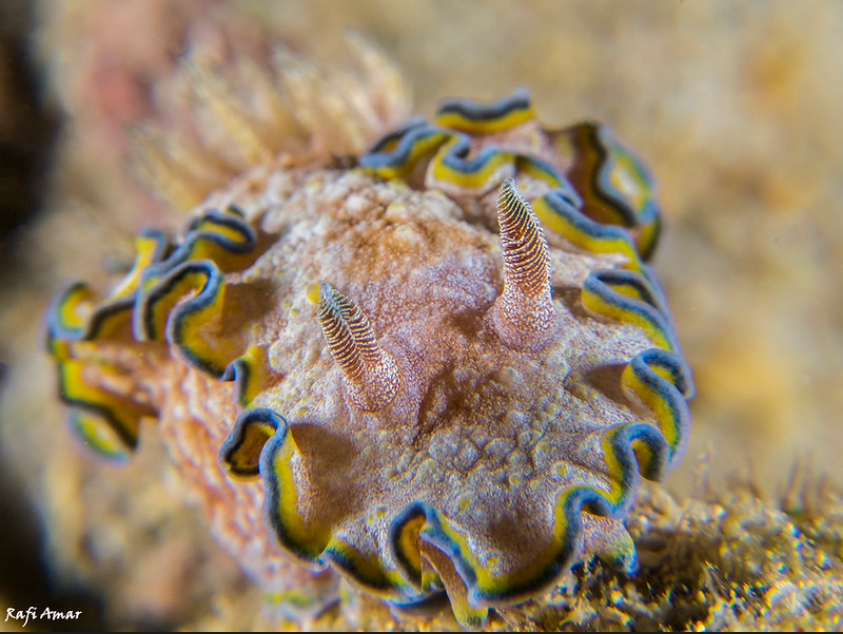 Above Glossodoris acosti by [Rafi Amar](https://www.flickr.com/photos/100123353@N08/49936819893/) 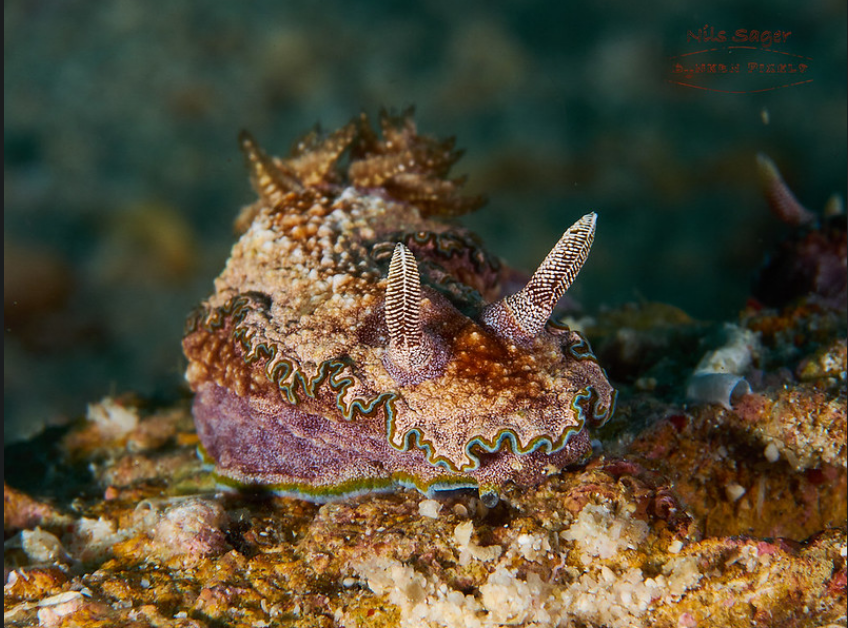 Above Glossodoris hikuerensis by [@halimeda](https://www.flickr.com/photos/nils_sager/49862758811/) 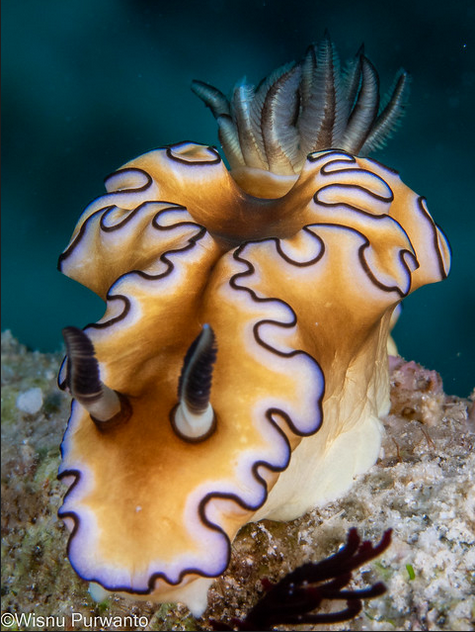 Above Glossodoris atromarginata by [Wisnu Purwanto](https://www.flickr.com/photos/wisnupurwanto/51683534019/)  Above Glossodoris sedna by [Guillem Mas](https://www.flickr.com/photos/guillem_mas/4276129857/)  Above Colemans Glossodoris by [Steve Gillespie](https://www.flickr.com/photos/theseaflea/31703996104/) 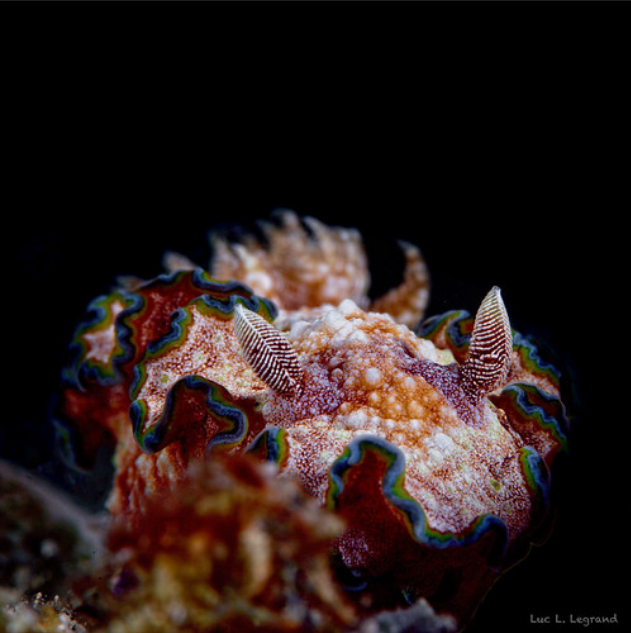 Above Glossodoris cincta by [Luc L. Legrand (thanks for 7 M views)](https://www.flickr.com/photos/capepaperu/50034488547/)  Above Glossodoris rufomarginata by [divemecressi](https://www.flickr.com/photos/berndhoppe/43190649191/) 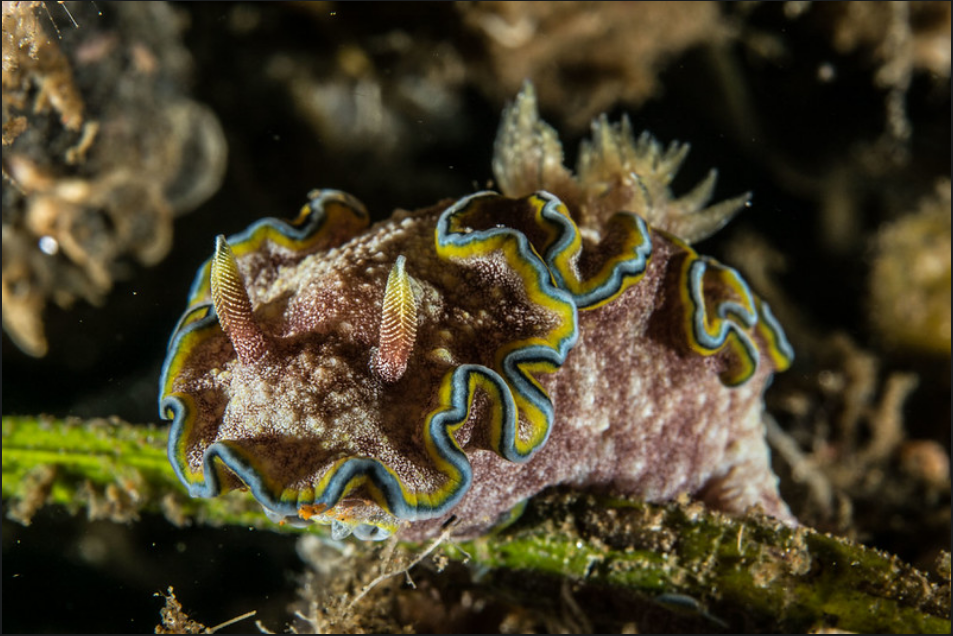 Above Gossodoris cincta by [jack pokoj](https://www.flickr.com/photos/152140870@N04/36976132641/) 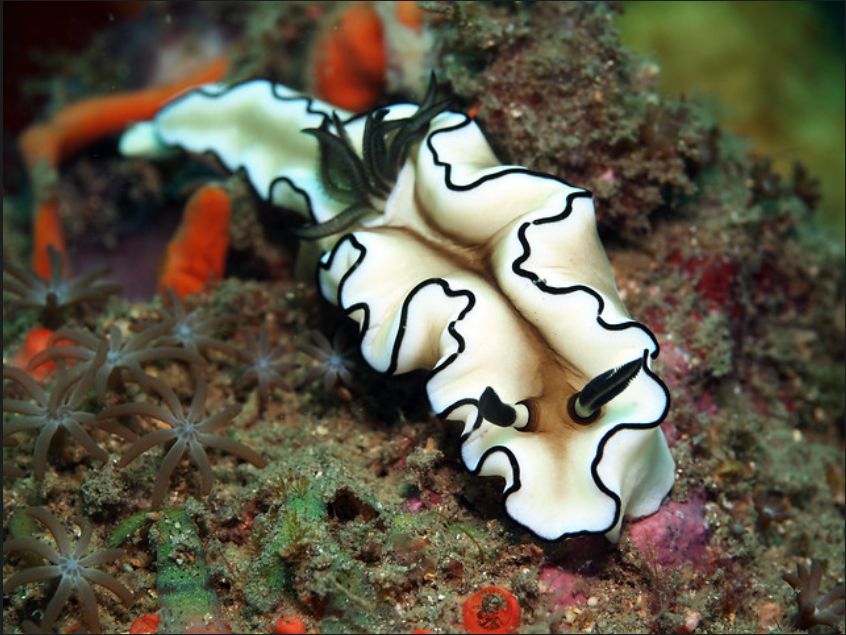 Above Glossodoris atromarginata by [divemecressi](https://www.flickr.com/photos/berndhoppe/11900340834/) 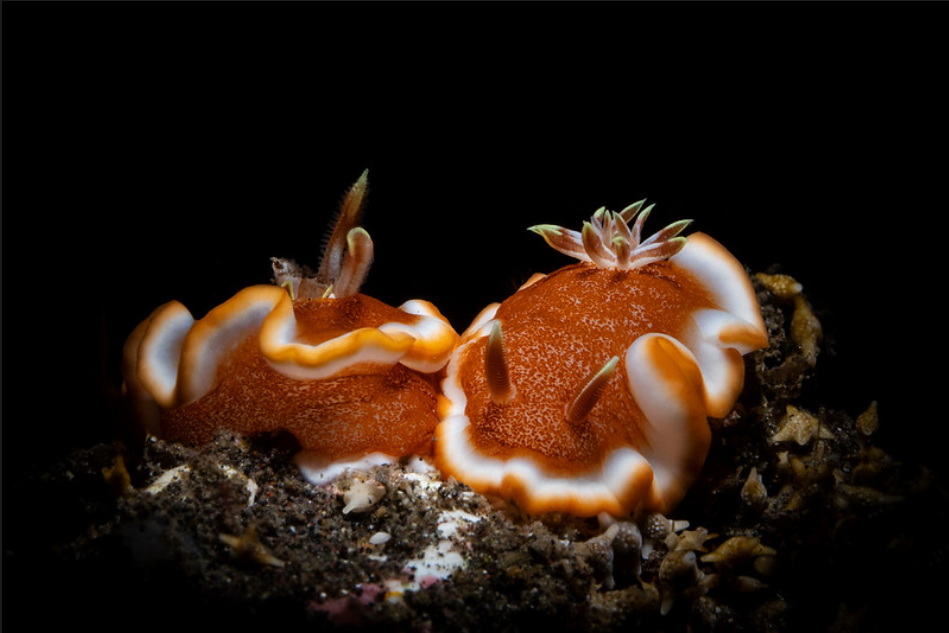 Above Glossodoris rufomarginata mating by [Ludovic](https://www.flickr.com/photos/luko/52892130945/) 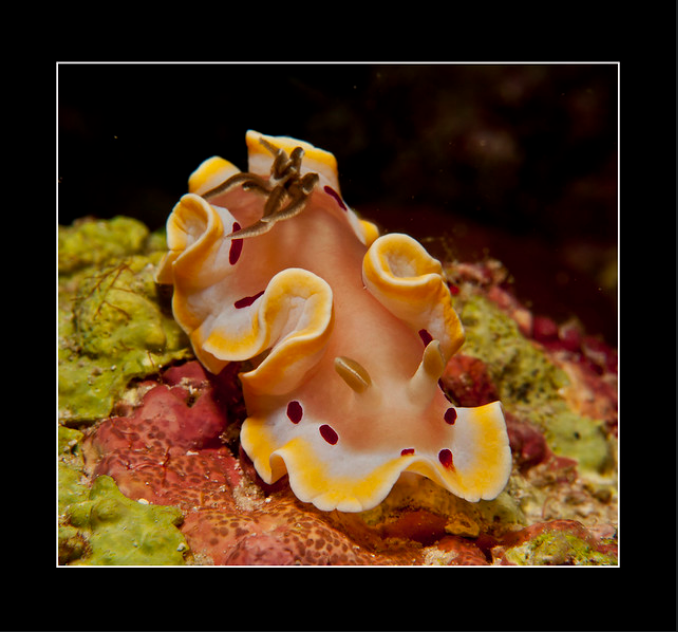 Above Glossodoris cruenta by [Tavistock](https://www.flickr.com/photos/69440424@N04/10104313525/) 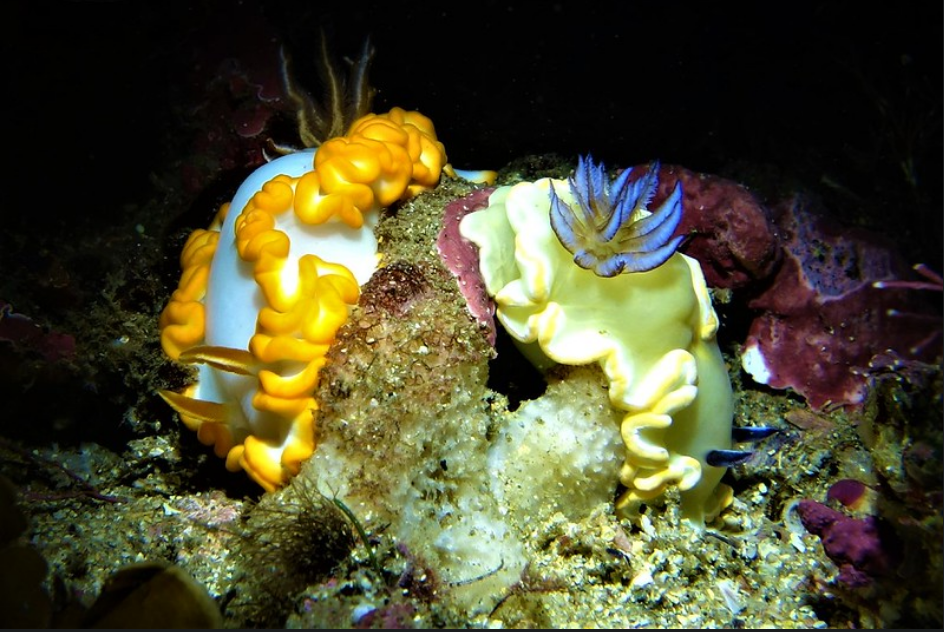 Above Averns Glossodoris with a Colemans Glossodoris by [Steve Gillespie](https://www.flickr.com/photos/theseaflea/33742888265/) 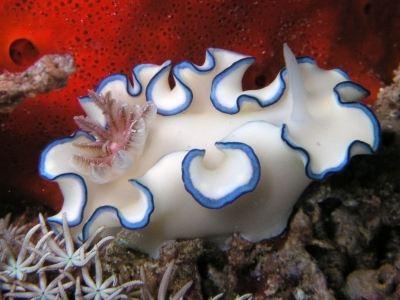 Above [Glossodoris sp. 16](http://www.seaslugforum.net/find/glossp16) 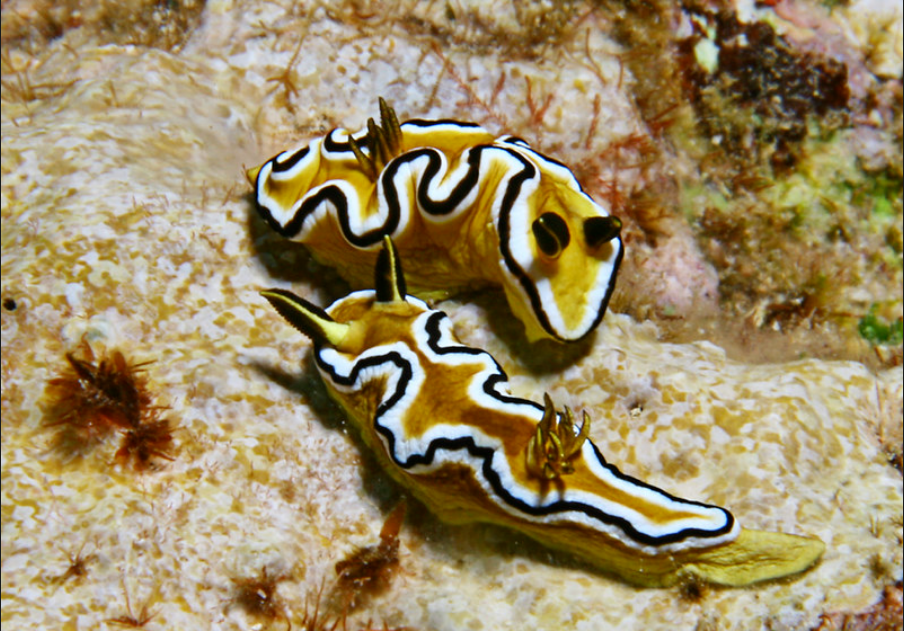 Above Glossodoris sibogae by [Thomas Vignaud](https://www.flickr.com/photos/thomasvignaud/2218123568/) 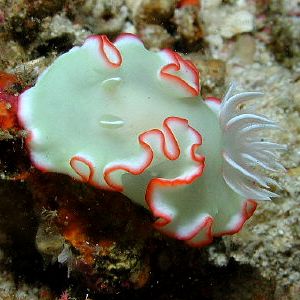 Above [Glossodoris sp. 10](http://www.seaslugforum.net/find/glossp10) 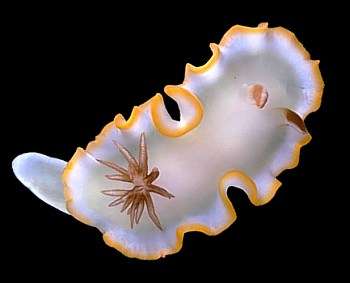 Above [Glossodoris electra](http://www.seaslugforum.net/find/gloselec)  Above [Glossodoris rubroannulata](http://www.seaslugforum.net/find/glosrubr)  Above Glossodoris buko by [Bernard Picton](https://en.wikipedia.org/wiki/File:Glossodoris_buko,_Sangeang,_Indonesia.jpg)
 quinacridone
4 months ago
•
100%
quinacridone
4 months ago
•
100%
Dammit! That's a much better title....why didn't I come up with that?

Main photo by [ilan Lubitz](https://www.flickr.com/photos/128664509@N04/27404312651/) Elysia marginata are Sacoglassons (a type of sea slug) and are found in the Indo-Pacific ocean at depths of 0-10 metres 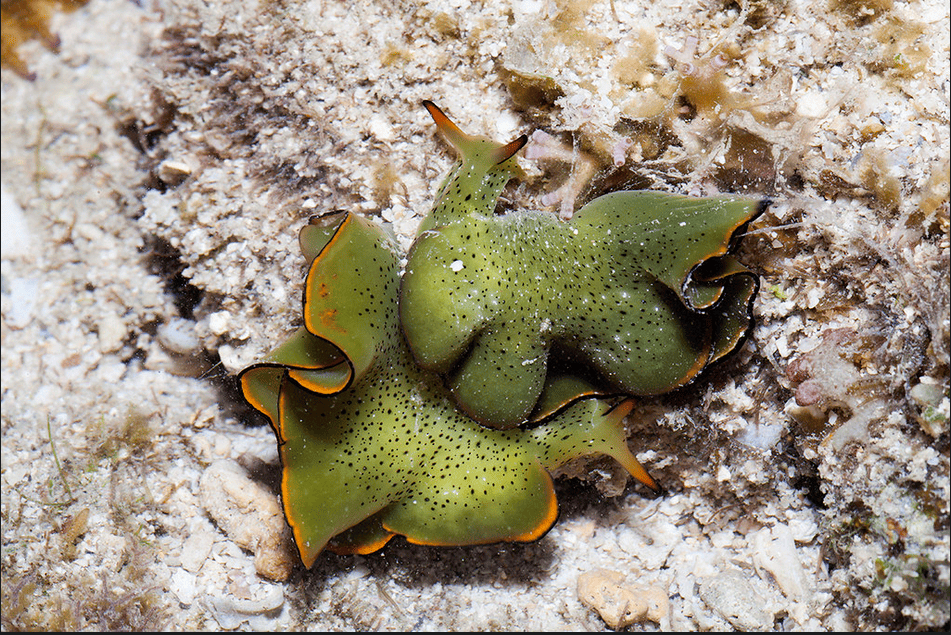 Above photo by [budak](https://www.flickr.com/photos/budak/17110702477/) They eat algae and store the chloroplasts in its body. The chloroplasts continue to photosynthesize and provide its host with a source of food!  Above 'Pair of leaf slugs on algae. They feed on green algae and can grow from 3 to 8cm long. Photo by Wesley Oosthuizen.' [source](https://xray-mag.com/content/leaf-slug-elysia-cf-marginata) They have the ability to regenerate a completely new body (including a new heart) from their head, after it detaches itself from its old body! (A process called [autotomy](https://en.wikipedia.org/wiki/Autotomy)- self amputation) 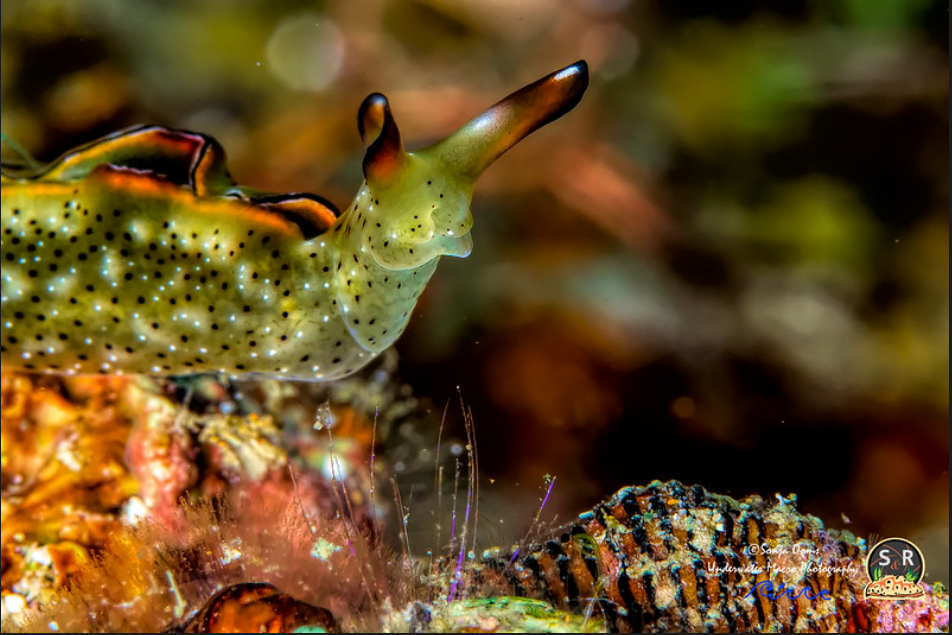 Above photo by [Sonja Ooms](https://www.flickr.com/photos/sonjaooms/51670756457/) Their ability was discovered by Sayaka Mitoh, a doctoral student at Nara Women's University in Japan, who spotted the decapitated head of E. marginata circling its separated body in one of the tanks in the lab 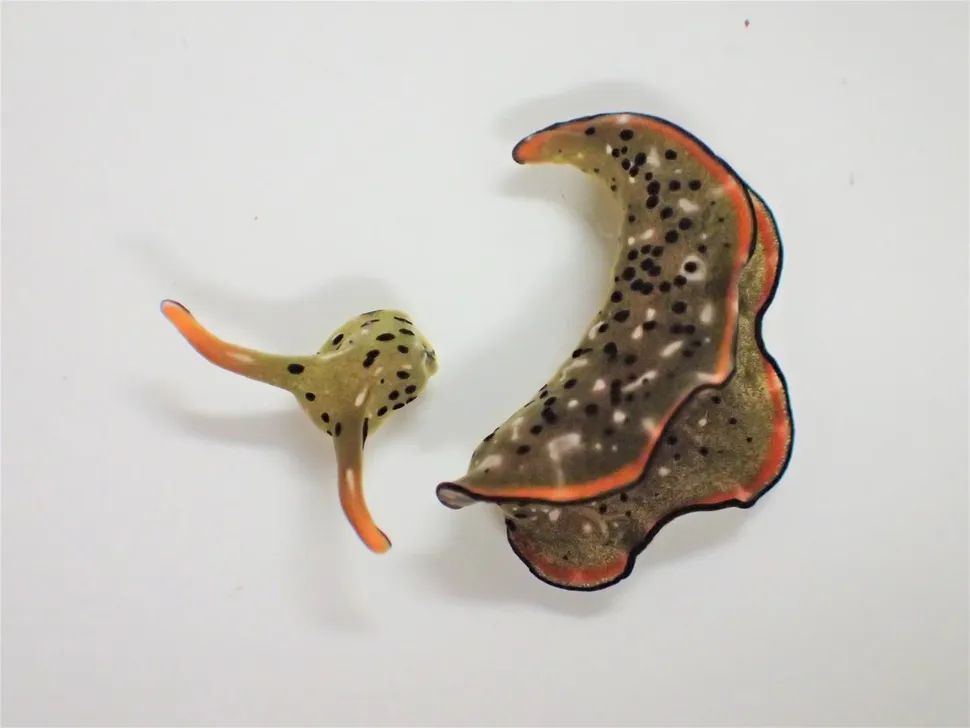 Above 'This image shows the head and the body of Elysia cf. marginata, a day after autotomy.' (Image credit: Sayaka Mitoh) [source](https://www.livescience.com/decapitated-sea-slugs-regrow-entire-body.html) Quite naturally she thought the slug would soon die, however.. >"After a few days, the head started regenerating the body and I could see [the] beating of the heart. It was unbelievable," Mitoh told Live Science. "I was really happy and relieved when I found it could regenerate the body." [source](https://www.livescience.com/decapitated-sea-slugs-regrow-entire-body.html)  [](https://mander.xyz/pictrs/image/8e5bbdb4-7381-47f1-8ccc-64416d7fd0f2.png) - A, Head and body of Elysia cf. marginata, just after autotomy (day 0), with the pericardium (heart) remaining in body section (arrow) - B, day 7 - C, day 14 - D, day 22, showing whole-body regeneration. - E, Head and body of Elysia atroviridis (individual no. 1) just after autotomy (day 0). Above text and photo [source](https://www.cell.com/action/showPdf?pii=S0960-9822%2821%2900047-6) The head continued to grow its new body over the next 3 weeks, including all vital organs, reaching about 80% of its original size! 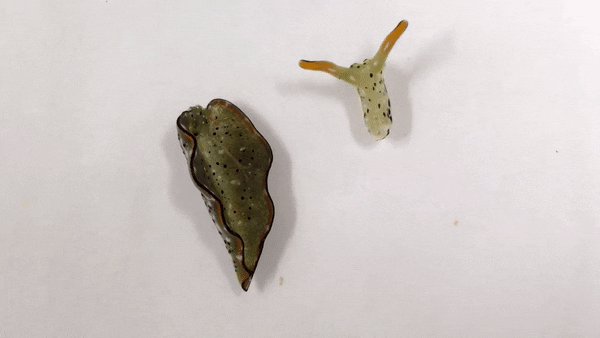 Above gif [source](https://www.scientificamerican.com/article/this-sea-slug-can-chop-off-its-head-and-grow-an-entire-new-body-twice1/) >"The [original] body continues to move and live for days to months," Mitoh said. "You can see the heart beating" inside them, she added. However, the decapitated bodies did not appear to be capable of growing new heads themselves. [source](https://www.livescience.com/decapitated-sea-slugs-regrow-entire-body.html) The old bodies remained active for several days to months, until they started to shrink, turn pale due to the chloroplast loss, and eventually died. The beating heart remained visible until the body had fully decomposed! So, why such an extreme behaviour? In other animals self amputation usually occurs when escaping a predator, however this may not be the case here.... 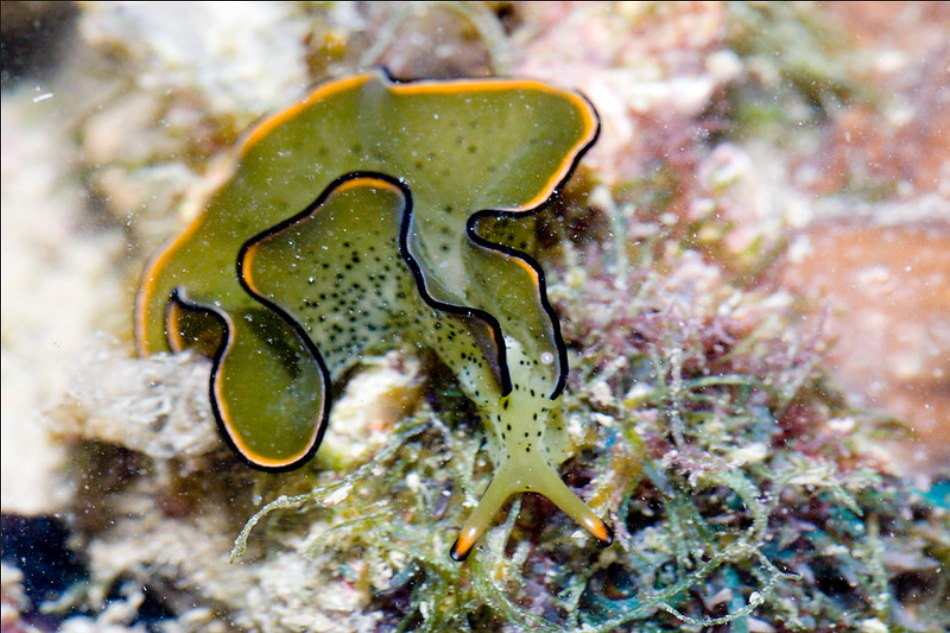 Above photo by [budak](https://www.flickr.com/photos/budak/6910393574/) The head can take several hours to detach from the body, so not exactly a quick get away from a predator Instead it is suspected that it is a means of ridding itself of parasites. There is a slight groove towards the end of the head which acts as a breakage plane, and the similar head severing species Elysia atroviridis all had internal parasites when they detached from their bodies.... However, no parasites were detected in Elysia marginata that did the same..... 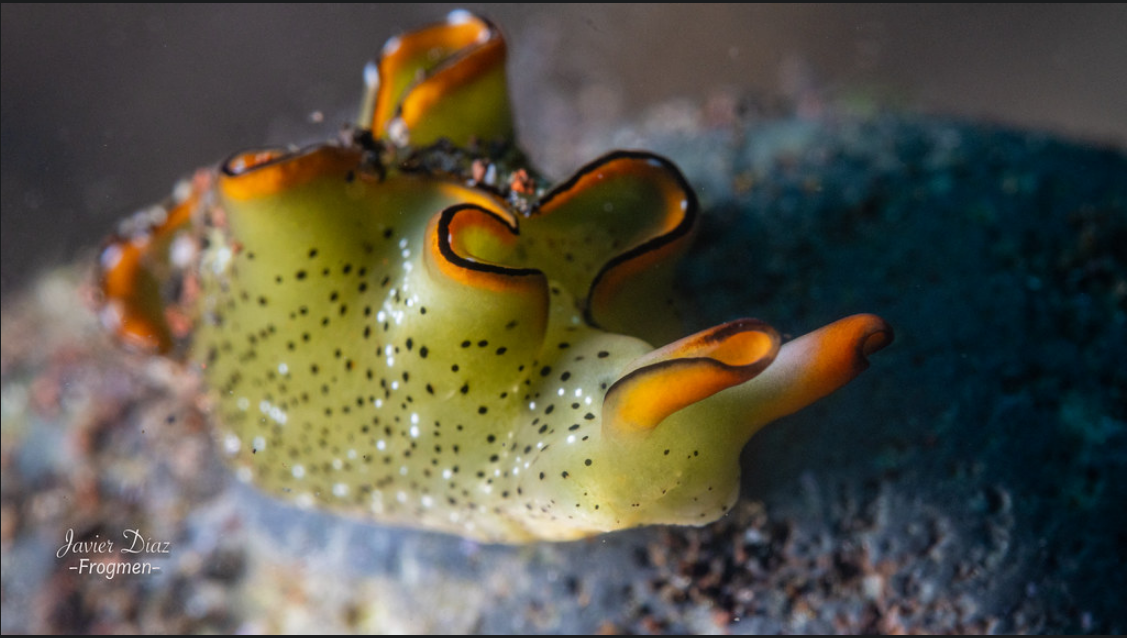 Above photo by [Javier Diaz Frogmen](https://www.flickr.com/photos/170438718@N08/53264901765/) The ingested chloroplasts are thought to help in the regeneration of the new body and keep the head alive in the absence of the digestive system organs (which remain with the body). One individual that was studied underwent autonomy and regeneration twice, which researches think is the limit...(which probably means it didn't survive the third time scientists went to work with a scalpel) Interestingly this behaviour was only exhibited by young Elysia marginata. When older animals were decapitated their heads survived up to 10 days, and didn't regenerate before dying  Above photo by [Antonio Venturelli](https://www.flickr.com/photos/189537291@N05/53395314875/) All information from [wikipedia](https://en.wikipedia.org/wiki/Elysia_marginata), [here](https://www.cell.com/action/showPdf?pii=S0960-9822%2821%2900047-6), [here](https://www.livescience.com/decapitated-sea-slugs-regrow-entire-body.html), [here](https://xray-mag.com/content/leaf-slug-elysia-cf-marginata), [here](https://www.scientificamerican.com/article/this-sea-slug-can-chop-off-its-head-and-grow-an-entire-new-body-twice1/), [here](https://www.sciencenews.org/article/sea-slug-detached-head-crawl-regenerate-grow-new-body) and [here](https://www.nytimes.com/2021/03/08/science/decapitated-sea-slugs.html) As always I'm not an expert, any errors let me know in the comments and I'll edit And I shall leave you all with a reprise of my current favourite gif.... 
 quinacridone
4 months ago
•
100%
quinacridone
4 months ago
•
100%
You're welcome!
I had no idea they existed, coming across them by accident while looking for something else.... I was particularly delighted by their crab jockeys
 quinacridone
4 months ago
•
100%
quinacridone
4 months ago
•
100%
A valuable skill!

Main photo by [Ocean Networks Canada](https://www.flickr.com/photos/oceannetworkscanada/9678458149/) 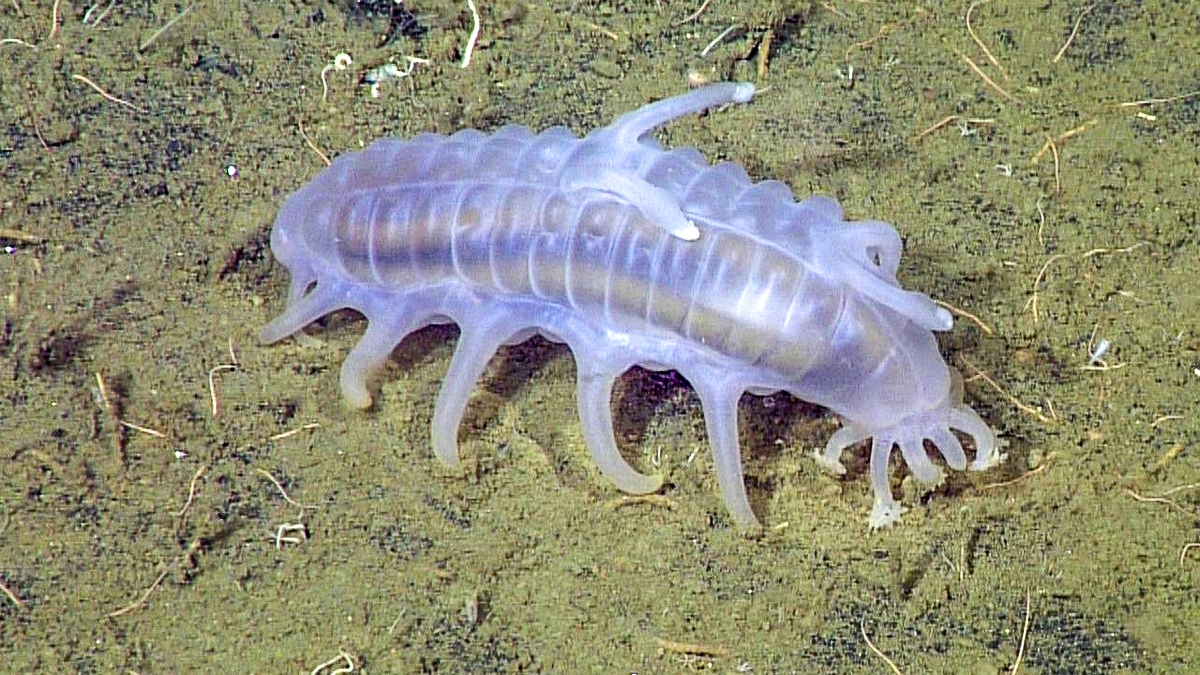 Above photo via [MBARI](https://www.mbari.org/animal/sea-pig/) Sea Pigs (Scotoplanes) are a type of Sea Cucumber They live in the deep sea, specifically on the abyssal plain up to depths of 5000m They can grow up to 4-6 inches They have 6 pairs of enlarged tubal 'feet', and use water cavities in their bodies to inflate and deflate them in order to move around, as well as ten buccal tentacles lining their oral cavity 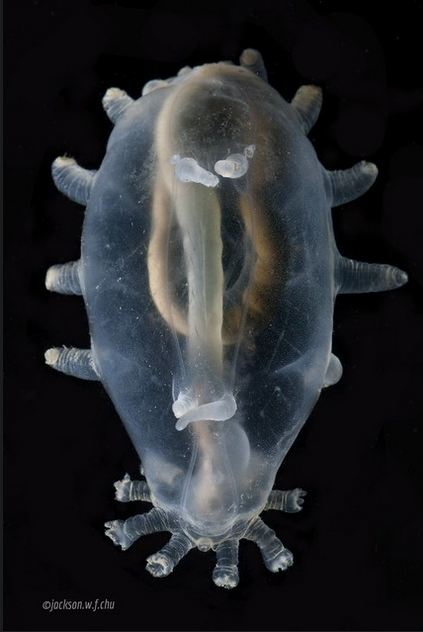 Above photo via [Ocean Networks Canada](https://www.flickr.com/photos/oceannetworkscanada/9775853991/in/album-72157635258422453/) They live on the sea floor feeding on delicious foods such as decaying animals, poo and mucus! If they are disturbed they can swim! In fact some Sea Pigs spend most of their lives swimming around in the water column using their frontal and anal lobes to propel themselves around! They will gather in large numbers around whale corpses to feed and perhaps find a mate  Above, a congregation of Sea Pigs feeding on a whale carcass via [MBARI](https://www.mbari.org/animal/sea-pig/) Their reproductive system is unique, the males only have one testis, and the females one ovary! Also their skin contains a toxin called holothurin which is poisonous to predators... They have a poorly defined respiratory system, and have to breathe through their anus! 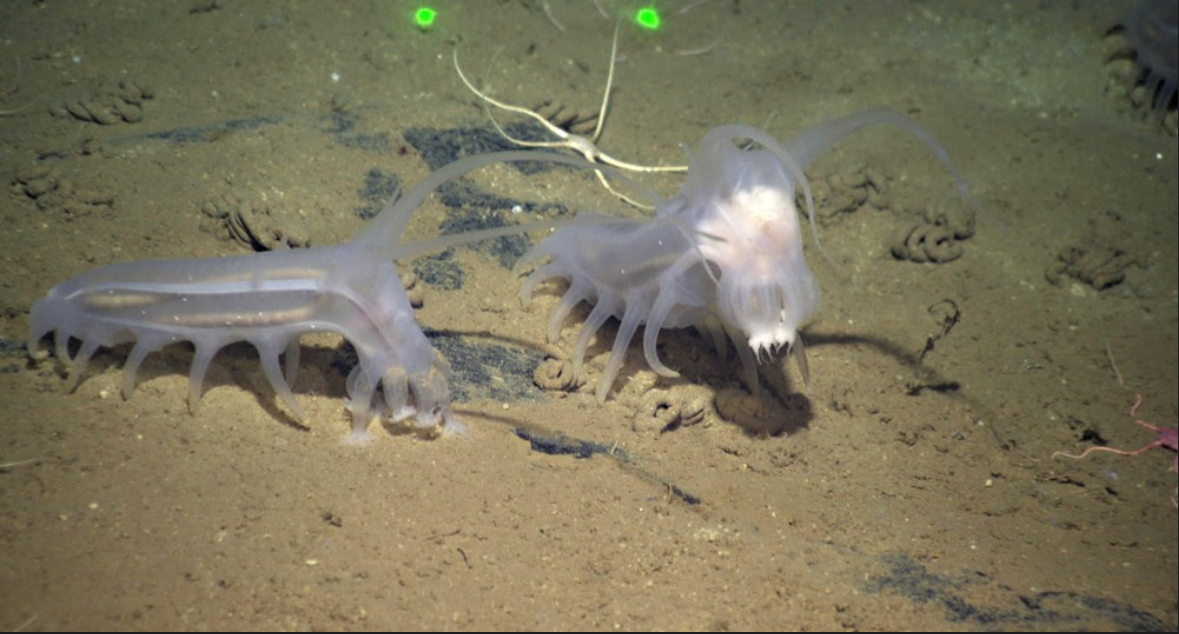 Above photo by Oceans Network Canada via [Treehugger](https://www.treehugger.com/sea-pigs-facts-4864441) As they have evolved at deep sea depths they would swell and burst if brought to the surface They are hosts to several parasitic invertebrates, including snails and small crustaceans But wait! What's this...? 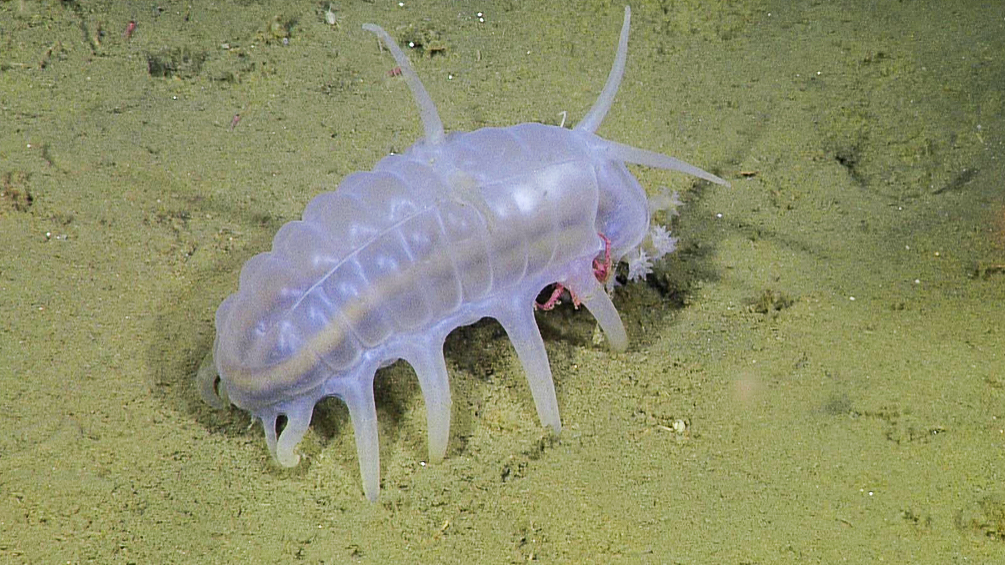 Above Above photo via [MBARI](https://www.mbari.org/animal/sea-pig/) What's that red thing hiding under the Sea Pig? 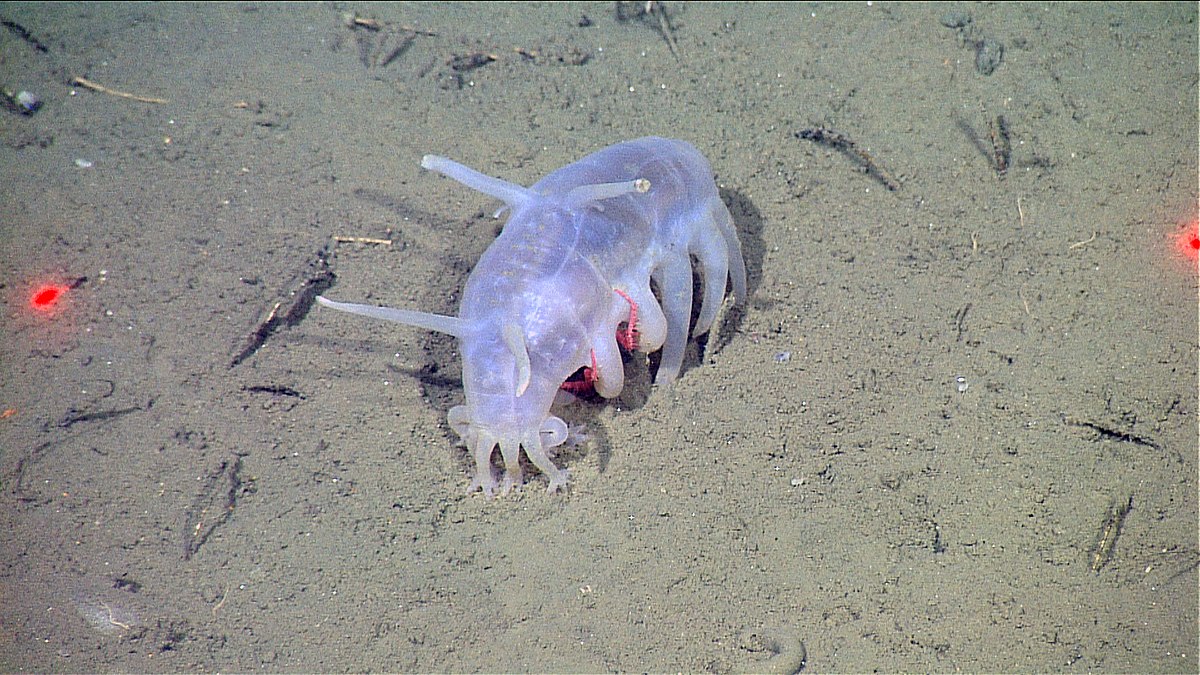 Above photo via [wikipedia](https://en.wikipedia.org/wiki/File:Scotoplanes_globosa_and_crab.jpg) It's a King Crab!  Above photo via [MBARI](https://www.mbari.org/animal/sea-pig/) Peek-a-boo! 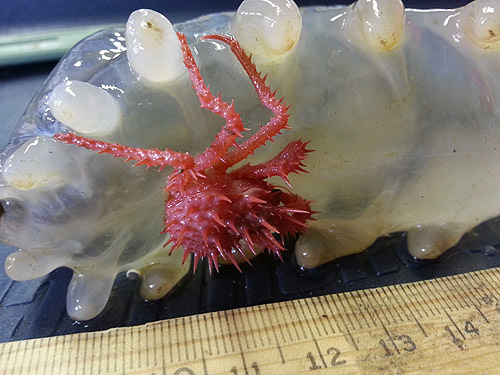 Above photo by Josi Taylor via [MBARI](https://www.mbari.org/news/young-king-crabs-found-hitchhiking-on-sea-pigs/) Why do King Crabs ride on Sea Pigs? Usually King Crabs like to hide in rocks and seaweed from predators, but it is thought that these King Crabs were carried by the ocean current while they were small larvae and ended up in the deep sea....an area devoid of such hiding places! >“It’s like looking for a port in the storm,” said James Barry, ecologist and lead author of the study at the Monterey Bay Aquarium Research Institute (MBARI) in Moss landing. Sea cucumbers are the ports or the biggest buildings to hide next to in an otherwise empty area.” [Scientific American](https://www.scientificamerican.com/blog/guest-blog/why-are-juvenile-crabs-hitching-rides-on-sea-pigs/) 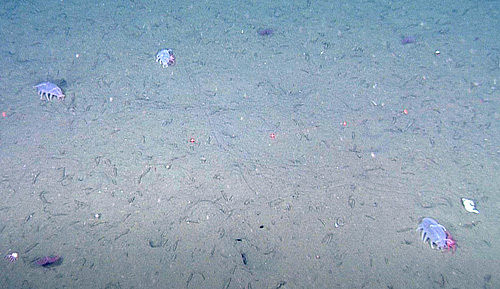 Above, ' This photograph of the muddy seafloor offshore of Monterey Bay shows three Scotoplanes sea cucumbers, at least two of which are host to juvenile king crabs.' [MBARI](https://www.mbari.org/news/young-king-crabs-found-hitchhiking-on-sea-pigs/) >Barry and his team found a total of 600 juvenile crabs, 96 percent of which were either clinging onto sea cucumbers or hanging around right next to them. Sometimes the crabs were upside down holding onto the belly of the sea pig and other times they were crawling on its side. In some cases, the researchers found more than one crab on a sea cucumber. Of the nearly 2,600 sea cucumbers videotaped, 22 percent had at least one juvenile crab clinging to them Goodbye Sea Pig, and your King Crab jockey! 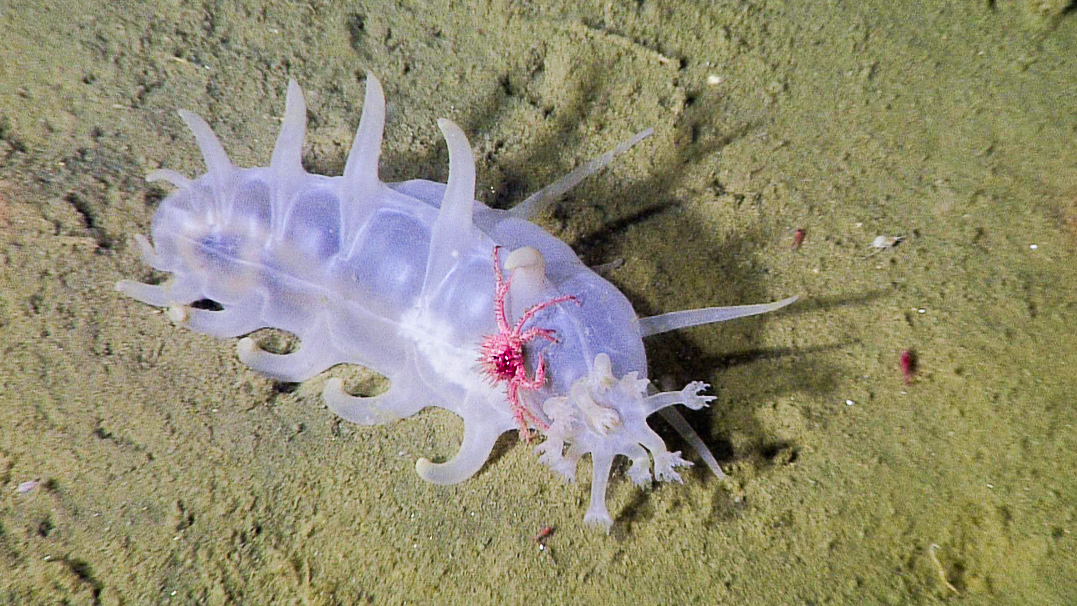 Above photo via [MBARI](https://www.mbari.org/animal/sea-pig/) edit- I completely forgot to add my sources.....[wikipedia](https://en.wikipedia.org/wiki/Scotoplanes) and [MBARI](https://www.mbari.org/news/young-king-crabs-found-hitchhiking-on-sea-pigs/), unless specified
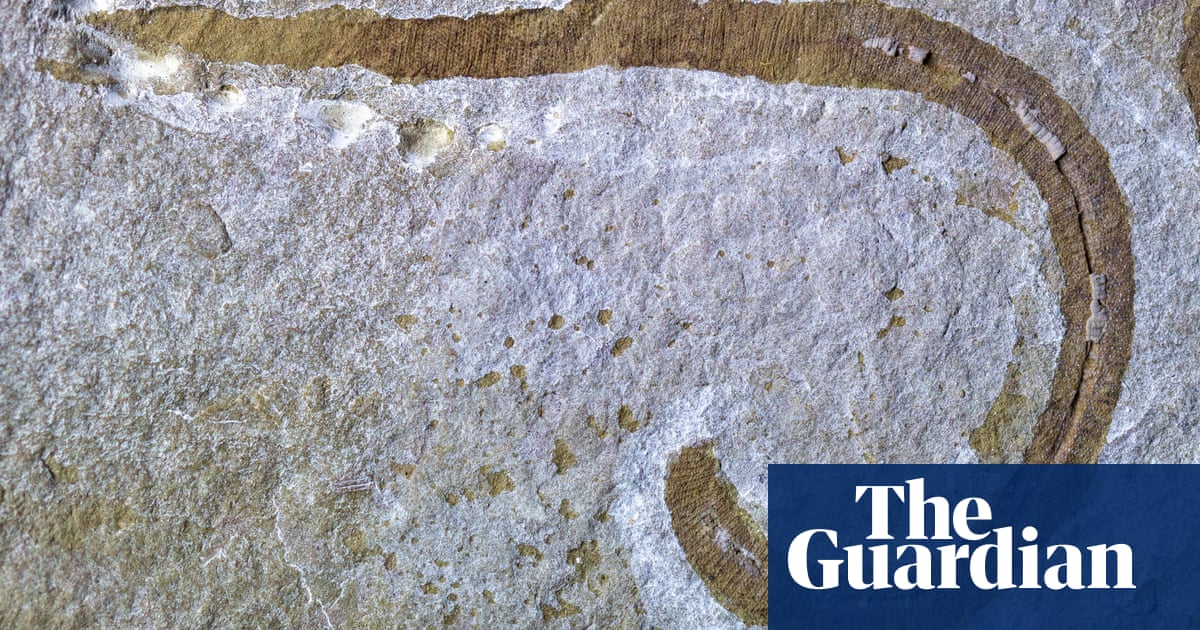 www.theguardian.com
www.theguardian.com
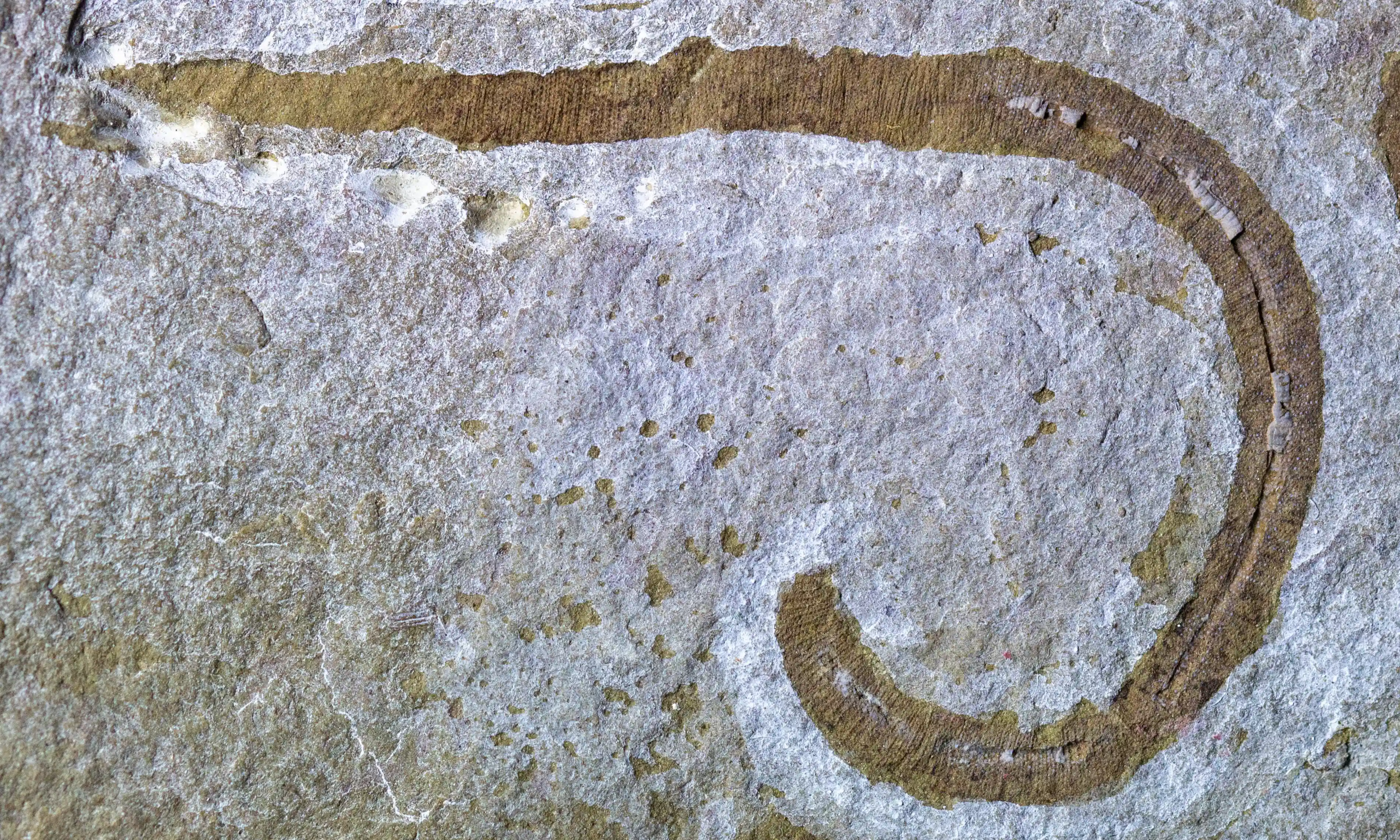 >Remnants of prehistoric worm Radnorscolex latus, unearthed in Herefordshire. Photograph: Richie Howard/Luke Parry/National History Museum/PA > > >An ancient worm unearthed in Herefordshire was a carnivorous predator that shoved its throat out to catch and eat prey, according to scientists. > >The creature, named Radnorscolex latus, was found at a disused Victorian quarry site in the village of Leintwardine, near the Welsh border. > >This marine worm is believed to have lived on the ocean floor about 425m years ago, when the region was under water. Analysis suggests it had a retractable throat that could extend out on to the seabed to capture prey hidden within the sediment. > >According to Dr Richie Howard, curator of fossil arthropods at the [Natural History Museum,](https://www.theguardian.com/culture/natural-history-museum) Radnorscolex is reminiscent of giant worms in the Hollywood blockbuster Dune. > >Howard said: “We think they weren’t too picky when it came to feeding and likely just shoved their throat out into the mud and grabbed anything they could find. > >“They certainly make you think of the sandworms in Dune in that respect.” > >Although fossil remains of Radnorscolex were first discovered a century ago, the technology was not advanced enough to allow palaeontologists to examine these in great detail. > >Experts from the Natural History Museum in London used state-of-the-art imaging techniques to analyse the remnants. > >Findings showed Radnorscolex had rows of sharp teeth and hooks on its head, which it would have used to anchor itself to the ground and drag its body forward to move. > >Despite being a predator, analysis suggests the creature only grew to be about 8cm long. > >The researchers said Radnorscolex belongs to a group of extinct worm-like animals known as Palaeoscolecids, which were wiped out completely about 400m years ago due to rapid climate and sea level change. > >The findings are published in the journal Papers in [Palaeontology.](https://www.theguardian.com/science/palaeontology) Image and text from the original article in [The Guardian](https://www.theguardian.com/science/article/2024/may/23/remnants-of-prehistoric-marine-worm-unearthed-in-herefordshire)

Main photo, Halgerda batangas by [Gerhard Batz](https://www.flickr.com/photos/tzab/53645290225/in/pool-nudibranch/) Firstly, the vast majority of photos are taken at depth so it's probably a good idea to be able to scuba dive.....and also most nudibranchs tend to look like this without the use of special lighting set ups 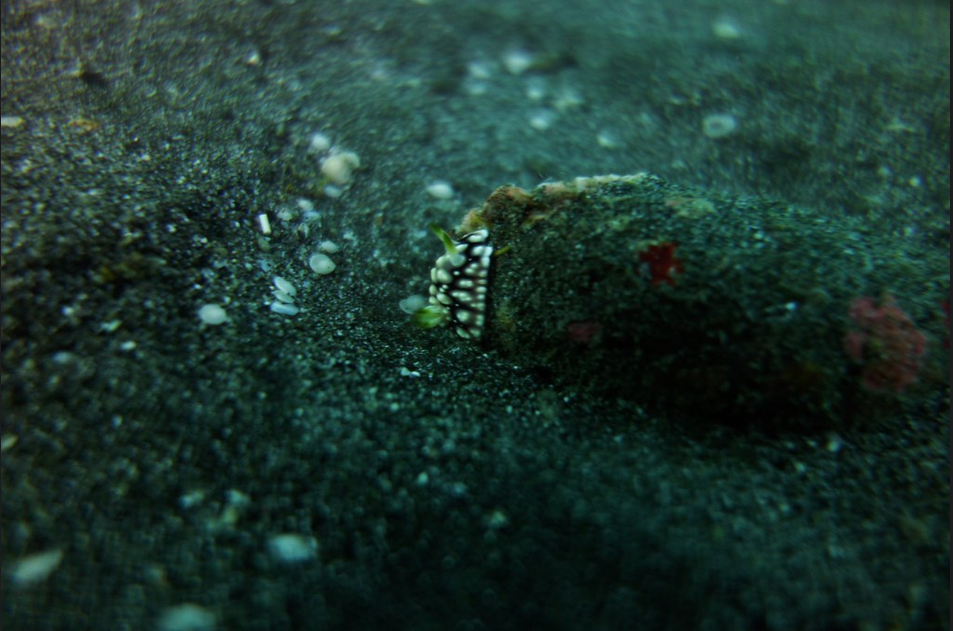 Above, by [McChuckerson](https://www.flickr.com/photos/chuckneerg/10528816773/) 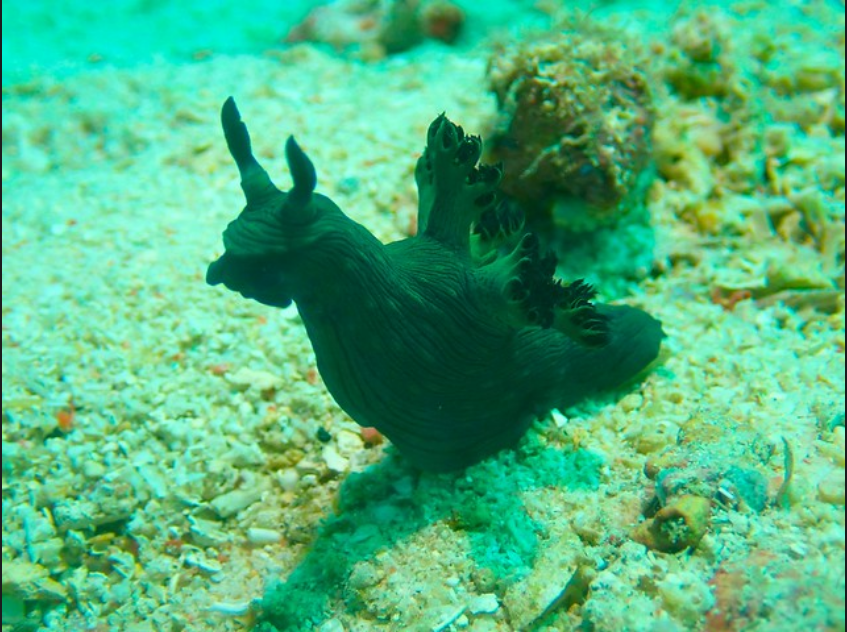 Above by [Go Zilla](https://www.flickr.com/photos/154290520@N02/53617585332/in/pool-nudibranch/) (Please note, I'm not criticizing or taking the piss out of these photos or the photographers, I just want to show how nudis look under normal lighting) A lot of nudi photos have black backgrounds which are created by using a strobe lighting set up configured like this... 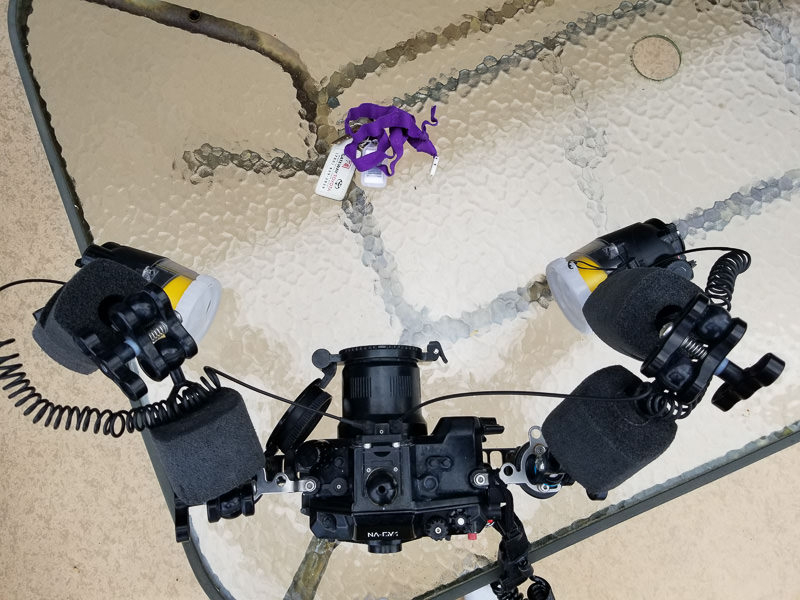 [Above](https://www.uwphotographyguide.com/black-background-strobe-positioning), 'This is how... (Bryan Chus) setup looks to get a successful test shot on land, using my 60mm macro lens (120 mm full frame equivalent).' 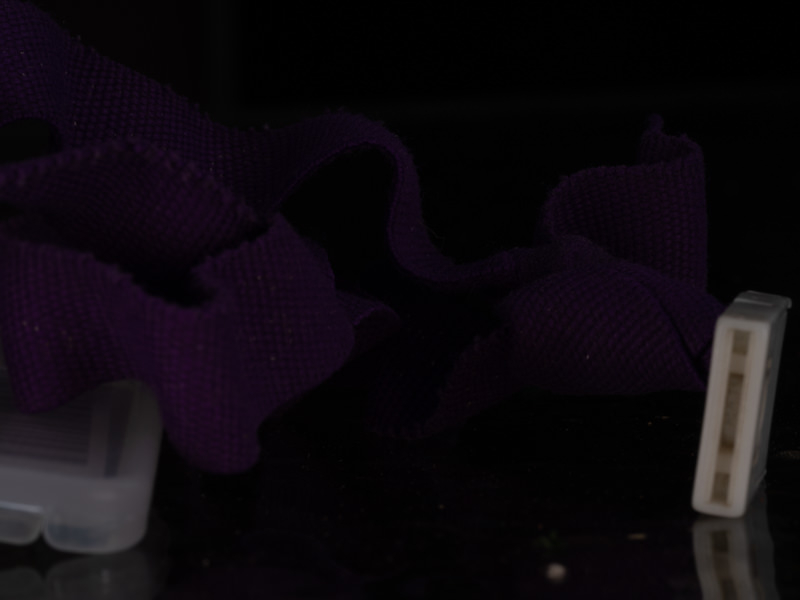 [Above](https://www.uwphotographyguide.com/black-background-strobe-positioning), 'Non-lit test subject using black background settings (1/320 sec, f/14, ISO 100).'  [Above](https://www.uwphotographyguide.com/black-background-strobe-positioning), 'Properly lit test subject with inward facing strobes.' The photos give results like these... 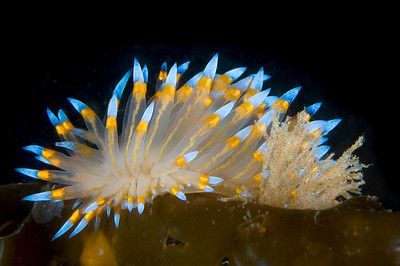 Above, [Janolus nudibranch](https://www.uwphotographyguide.com/black-backgrounds) 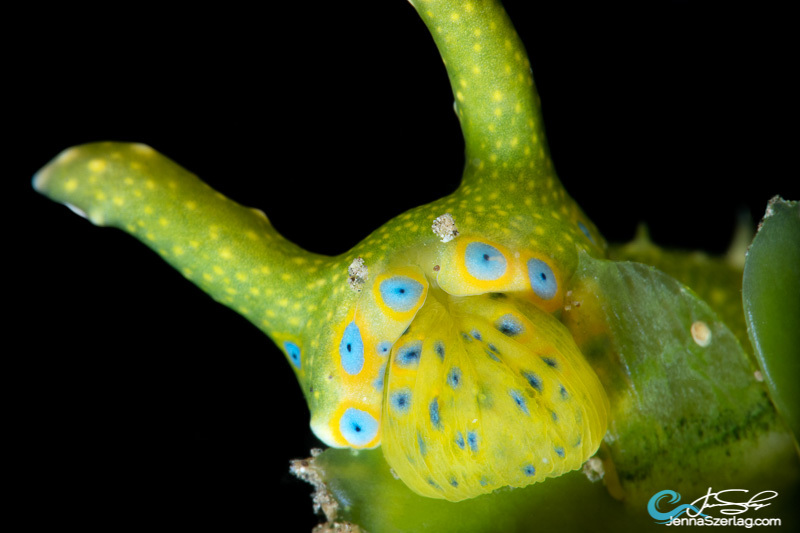 Above, 'Oxynoe jordani feeds on Caulerpa taxilfolia Canon 5DSr 100mm Lens ISO100 1/250 f/25' by [Jenna Szerlag](https://www.uwphotographyguide.com/nudibranchs#Tips)  Above by [Andrey torchuck](https://www.flickr.com/photos/157623318@N06/27714219759/) Of course there's slightly more to getting an amazing photograph than just having the right set up.... Composition, highlighting natural features, symmetry, depth of field, background contrast, animal behaviour all play their role  [Above](https://www.uwphotographyguide.com/essential-tips-nudibranch-photography), 'Showing nudibranch symmetry works well, like with this shot of a Nebrotha kuberyani. [Mike Bartick] particularly like[s] to shoot these guys because of their interesting facial features, texture and vibrant colors.' 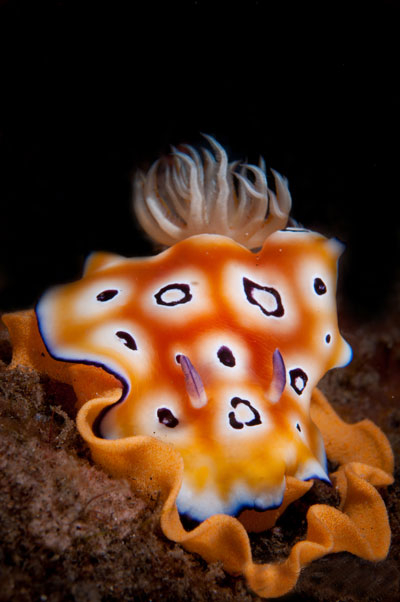 [Above](https://www.uwphotographyguide.com/essential-tips-nudibranch-photography), 'Chromodoris leopardis. Laying eggs is always a very interesting behavior to capture. The eggs are often brightly colored and textured. If eggs are found alone, inspect them, as other nudibranchs often feed on them.' 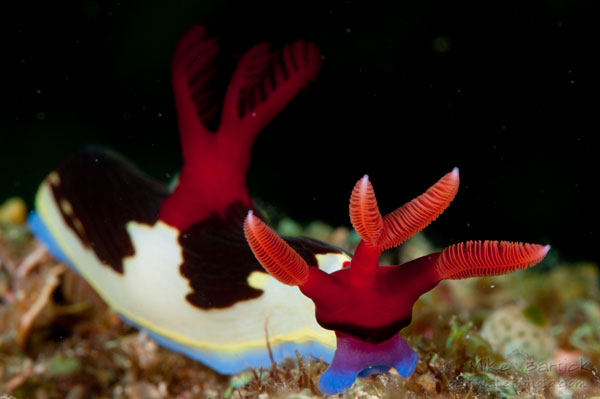 [Above](https://www.uwphotographyguide.com/essential-tips-nudibranch-photography), 'Nembrotha chamberlaini. If there is an anomaly of some sorts that sets your subject apart for the norm be sure that this anomaly is the center of the viewers’ attention.' 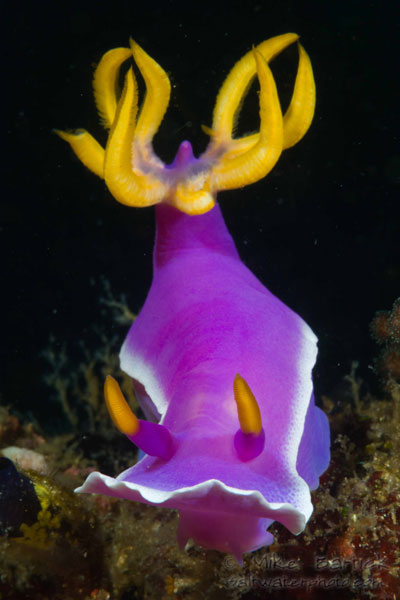 [Above](https://www.uwphotographyguide.com/essential-tips-nudibranch-photography), 'Extreme depth of field isn’t always necessary, but on a larger subject its hard to resist, especially when one is as colorful as this Hypseledoris. Backing away from your subject is an easy way to slightly increase your DOF when working with nudibranchs.' 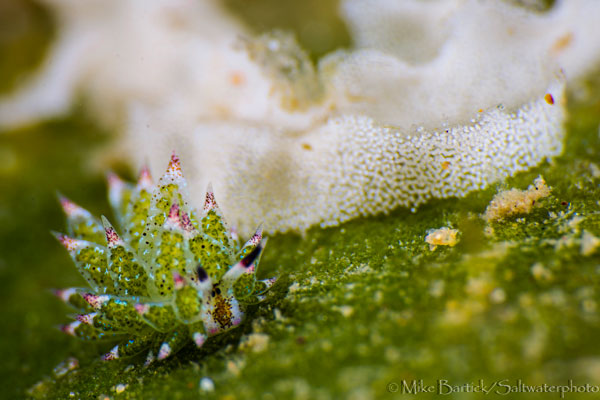 [Above](https://www.uwphotographyguide.com/essential-tips-nudibranch-photography), 'Using a quality diopter of +10 or greater will dramatically increase the size of very small subjects and allow you to fill the frame with very little cropping. These Castosiella kuroshimae are miniscule and nearly impossible to detect. Look on small algae on sandy dive sites.' 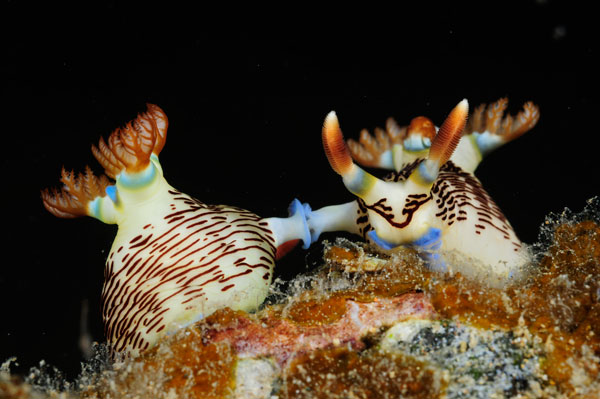 [Above](https://www.uwphotographyguide.com/essential-tips-nudibranch-photography), 'Nembrotha lineota. Get low, get close and shoot up. Use negative space and be sure your subject's Rhinophores are sharp.' 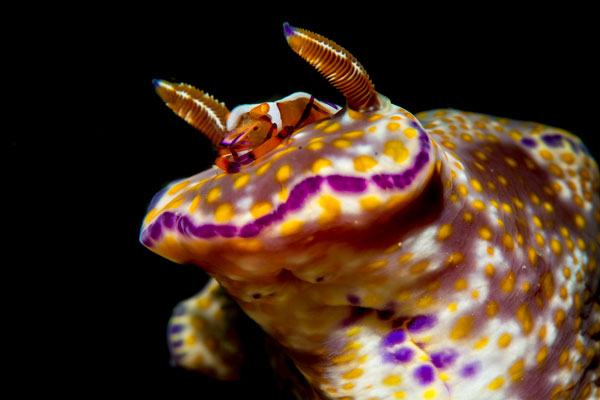 [Above](https://www.uwphotographyguide.com/essential-tips-nudibranch-photography), 'Miamira tenue aka Ceratasoma tenue can grow to impressive sizes. Some are large enough to sport accessories like this emperor shrimp that lives a symbiotic lifestyle with its host. Keeping its hosts gills cleaned and rummaging for food as the nudi moves along the substrate is priority number 1 for the shrimp, and getting photos of them on the nudi are great behavioral images.' 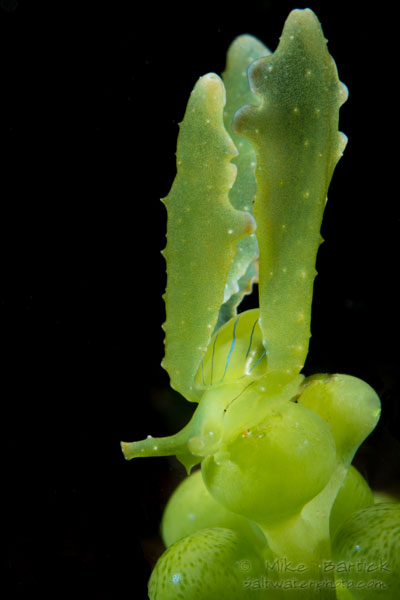 [Above](https://www.uwphotographyguide.com/essential-tips-nudibranch-photography), 'Mimicry is another behavior that an entire article could be written about, especially with these amazing Lobiger sp. Sap suckers live on algae that resembles green grapes. This image was shot in very shallow water in broad daylight. Using a high shutter speed will enable you to control the incoming light, even on the sunniest days. When a subject is tall, try turning your camera to the portrait position.' 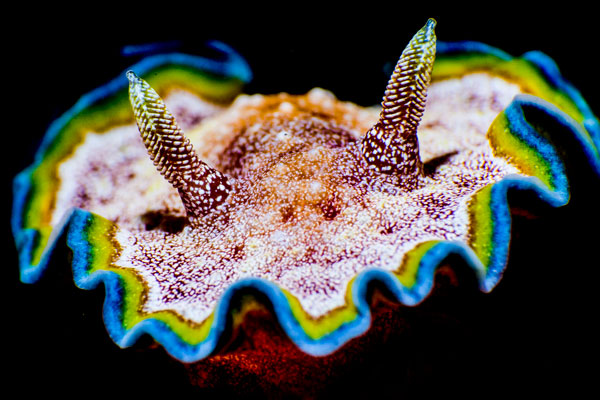 [Above](https://www.uwphotographyguide.com/essential-tips-nudibranch-photography), 'Glossodoris cincta. These larger nudis will fill your frame easily with or without a diopter. Paying close attention to the camber of your subject's Rhinophores will help with head-on composition. The gills of the cincta actually vibrate as they move and are fun to watch.' Not all photographers use black backgrounds for their photos and the results are just as beautiful.... 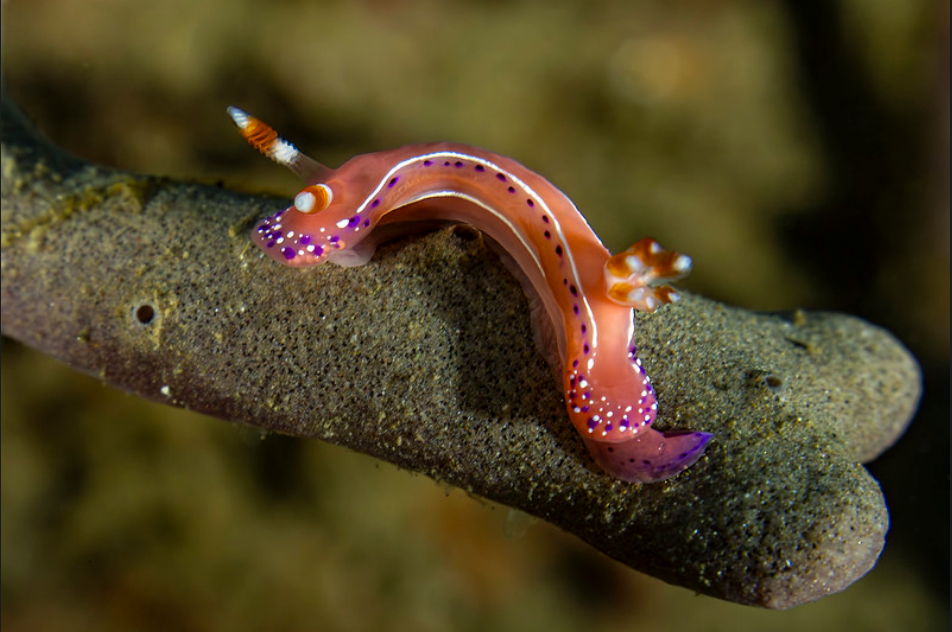 Above photo Thorunna australis, by [elebe.foto](https://www.flickr.com/photos/104413886@N07/53564993788/in/pool-nudibranch/) 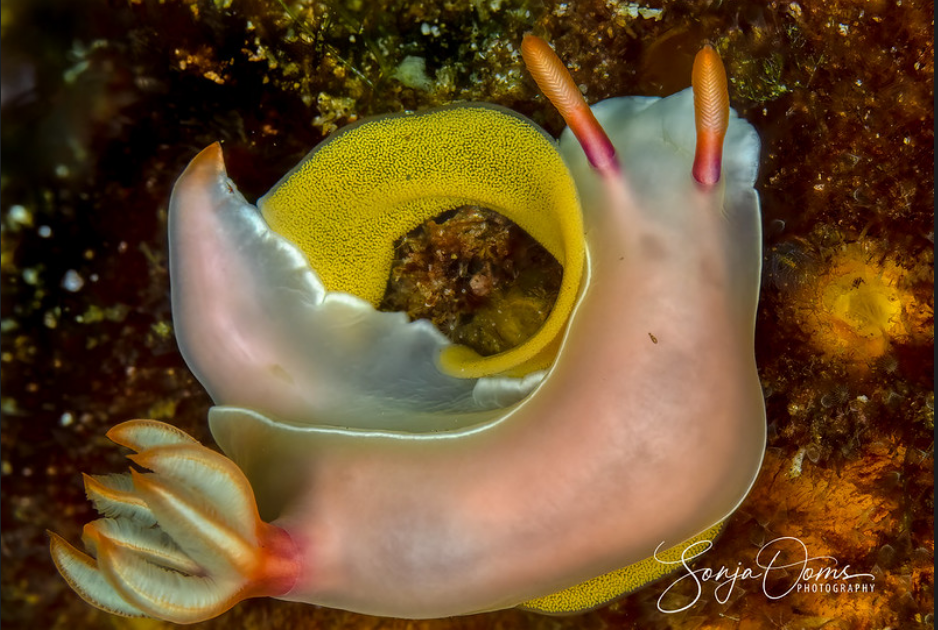 Above photo Hypselodoris bullockii laying eggs by [Sonja Ooms](https://www.flickr.com/photos/sonjaooms/52267864862/) 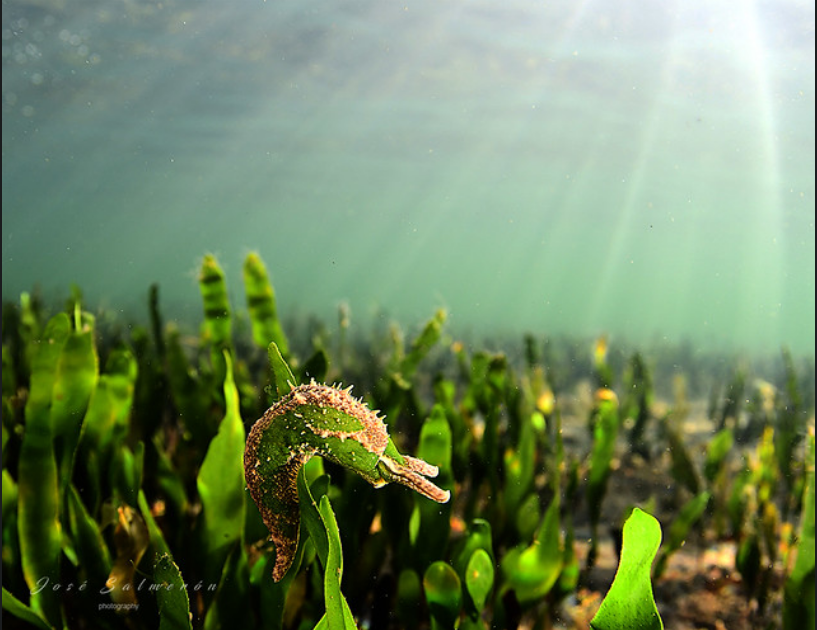 Above photo of Oxynoe olivacea by [Jose Salmerón](https://www.flickr.com/photos/salmeroncasanova/53276135934/in/pool-nudibranch/) 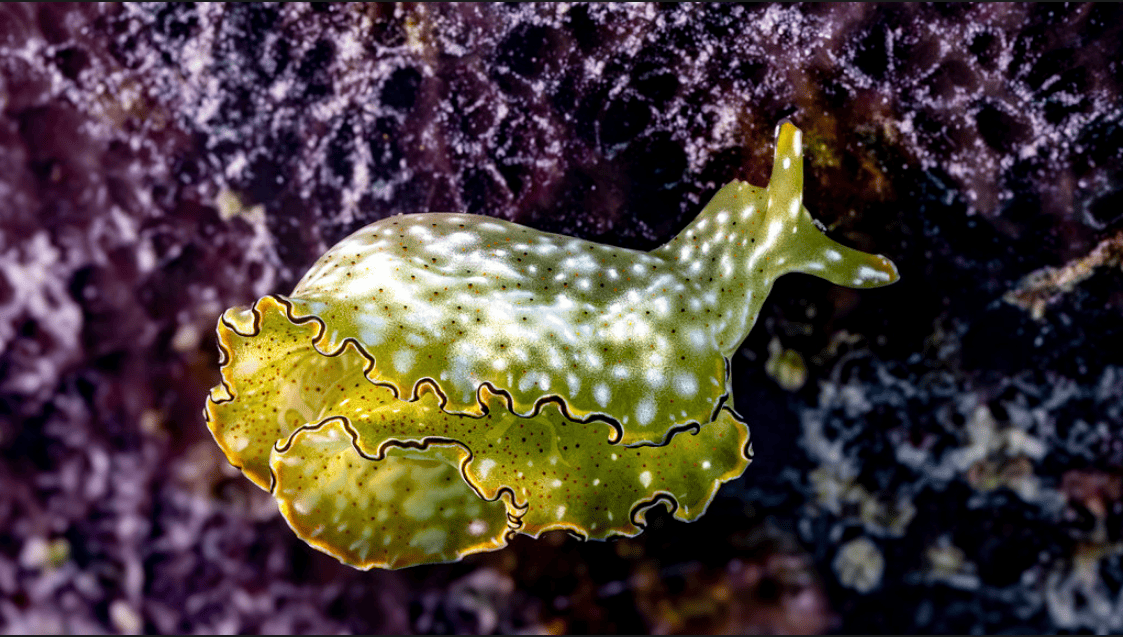 Beautiful photo that pops with contasting colours of Elysia marginata by [elebe.foto](https://www.flickr.com/photos/104413886@N07/53565177396/in/pool-nudibranch/) And also lets not forget the role of the computer in adding the final touches to a well composed and well lit photograph Some photos may need a bit of work to either remove debris in the foreground or background that distract from the main focus point... Others need work in making them pop more. Of course images can suffer through too much retouching, and also no amount of photoshop can save a poorly composed image....both sides of the debate are discussed [here](https://www.scubadiving.com/keywords/underwater-photography/ask-expert-are-we-using-too-much-photoshop-underwater-photography) 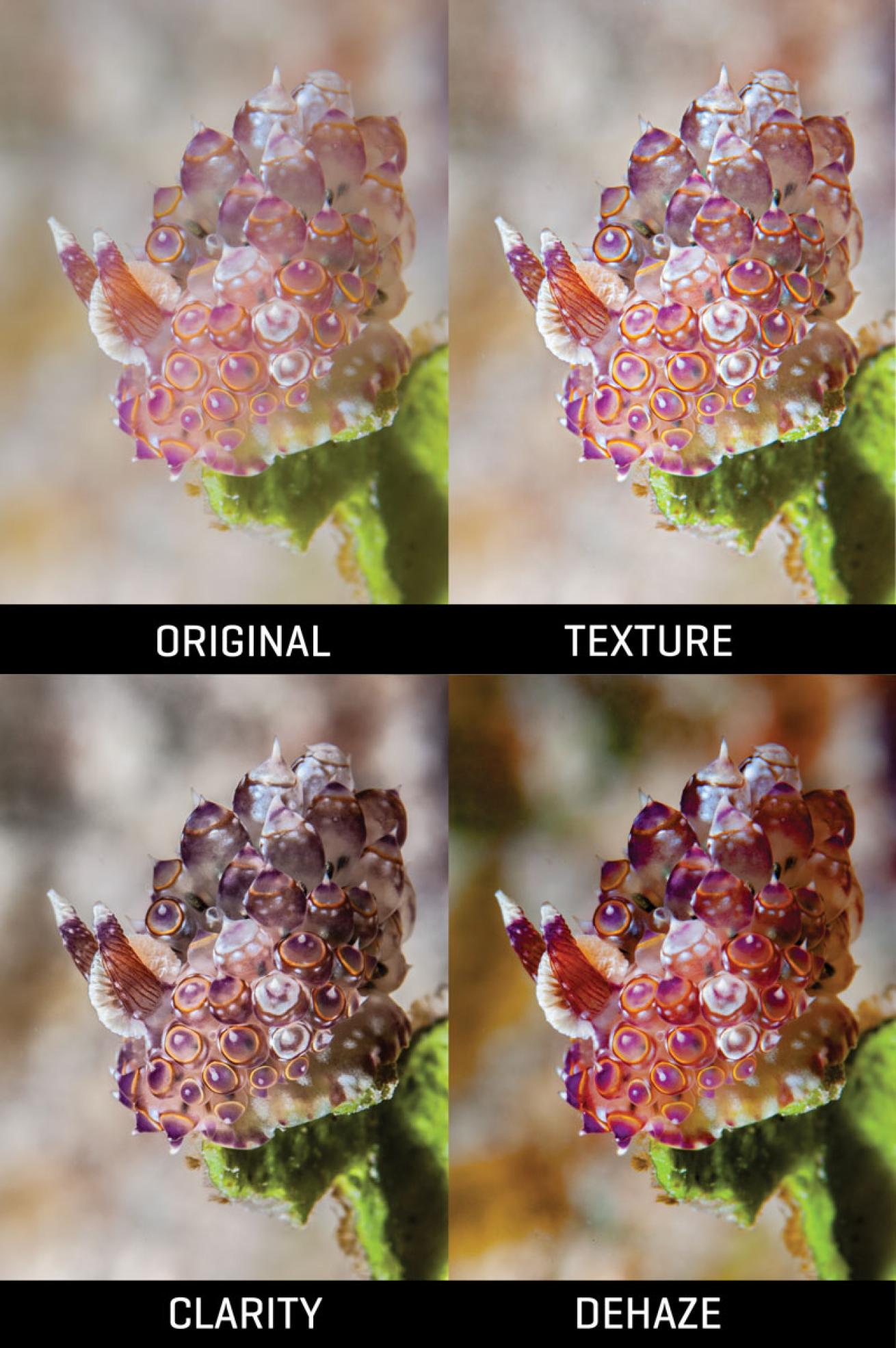 [Above](https://www.scubadiving.com/how-to-use-texture-slider-in-lightroom), 'Here's how to make Texture, Clarity and Dehaze work for you.' photo by Erin Quigley And finally a Super Pro photo by David Hall, below 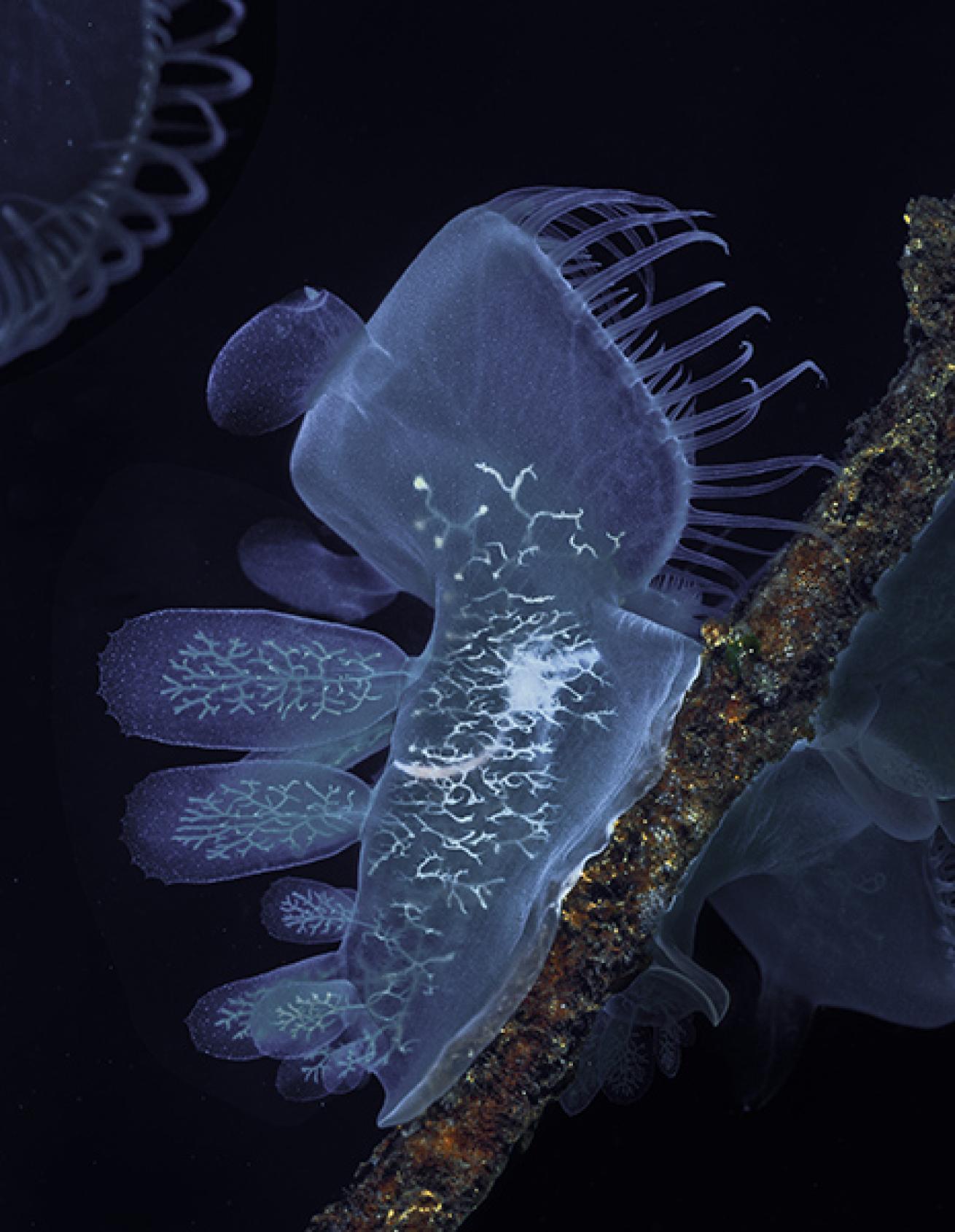 >"Imagine a bull kelp forest in which the plants are completely covered with ghostlike animals expanding and contracting rhythmically,” photographer David Hall writes of shooting the hooded nudibranch, Melibe leonine, for his award-winning book Beneath Cold Seas: The Underwater Wilderness of the Pacific Northwest. > >HOW HE GOT THE SHOT Hall used a Nikonos RS camera with a 50mm lens, two Ikelite SS-50 strobes and Fujichrome Velvia 50 film. Hooded nudibranchs are transparent, like jellyfish, and correct exposure can be difficult to estimate, so Hall bracketed the exposure generously. [here](https://www.scubadiving.com/look-hooded-nudibranch) All information from [here](https://www.uwphotographyguide.com/nudibranchs) and [here](https://www.uwphotographyguide.com/essential-tips-nudibranch-photography), unless otherwise stated As always I'm not an expert, and certainly not one in underwater photography (I'm still trying to get to grips with terrestrial photography)
 quinacridone
5 months ago
•
100%
quinacridone
5 months ago
•
100%
You're welcome, also do checkout the other underwater photos he has, they're full of beautiful things 👍

Main photo 'A giant dendronotid nudibranch swimming in mid-water'  Above, 'The opalescent nudibranch is a predatory mollusk with no shell'  Above, 'Hooded Nudibranchs on Kelp' 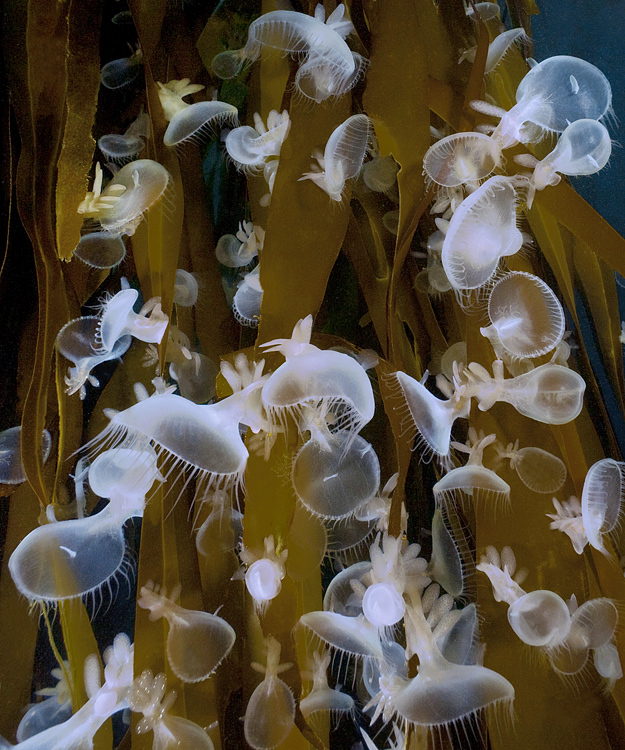 Above, 'Hooded Nudibranchs'  Above, 'Hooded Nudibranch, Melibe leonina - British Columbia, Canada'  Above, 'Opalescent nudibranchs and ascidians'  Above, 'Sea Lemon Nudibranch, Anisodoris nobilis - British Columbia, Canada' 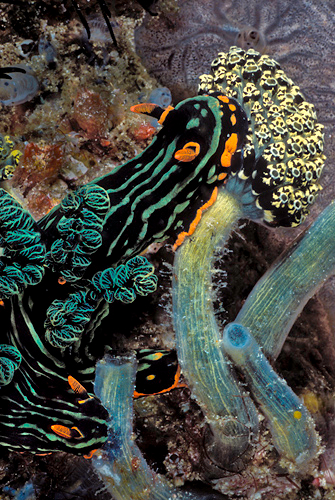 Above, 'Nudibranchs (Nembrotha kubaryana) feeding on stalked ascidians. All nudibranchs are carnivorous, mostly preying upon sessile invertebrates such as ascidians, sponges, bryozoans and cnidarians (hydroids, corals, anemones). (Komodo, Indonesia) (photo: Gayle Jamison)' 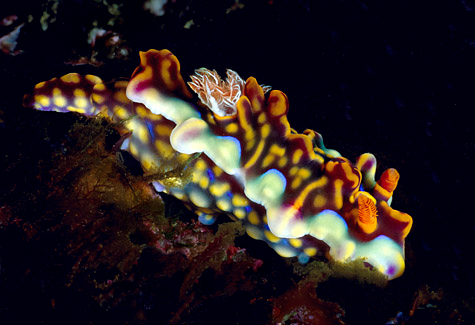 Above, 'Nudibranch, Miamira magnifica - Izu, Japan'  Above, 'Hypselodoris infucata; Lembeh Strait, Indonesia' Selected underwater photography [here](https://www.seaphotos.com/bc/), more [nudibranchs](https://www.seaphotos.com/nudibranchs.html#), and his [books](https://www.seaphotos.com/beneathcoldseas/)

Title photo by [Doug Anderson](https://www.flickr.com/photos/douga/6328729772/) More photos of Emperor shrimp (Periclimenes imperator) riding on various nudibranch hosts... Solo riding.... 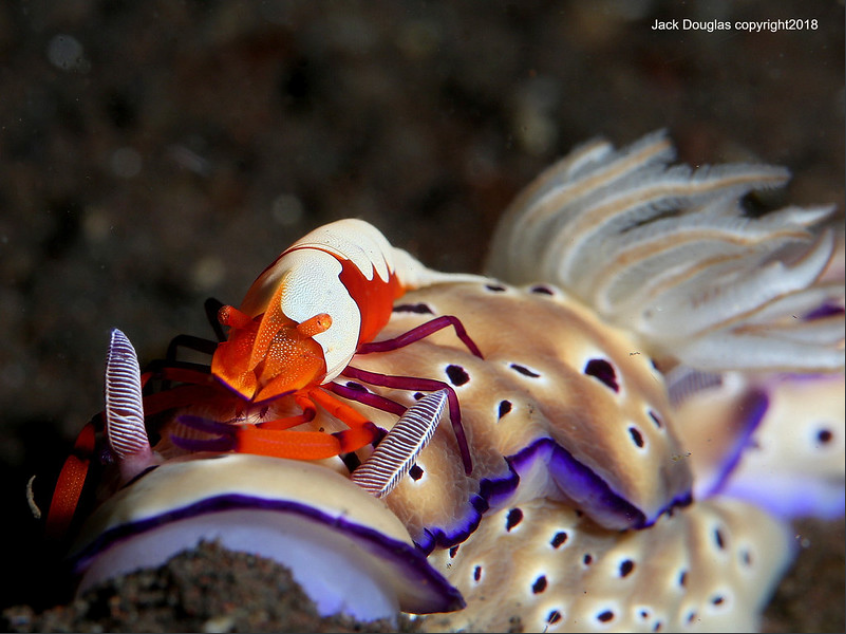 Above photo of Ceratosoma trilobatum, by [Jack](https://www.flickr.com/photos/11016640@N07/42003318874/) .....or with a pal....  Above photo of Ceratosoma trilobatum, by [Jack](https://www.flickr.com/photos/11016640@N07/42003319384/) ...Tandem.... 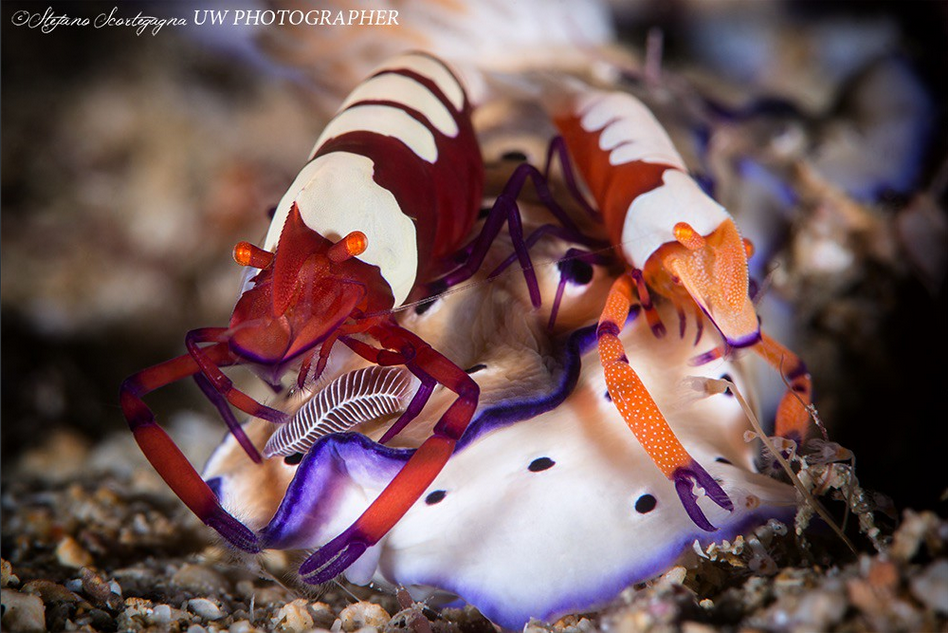 Above photo by [Stefano Scortegagna](https://www.flickr.com/photos/stefanoscortegagna/17367487930/) 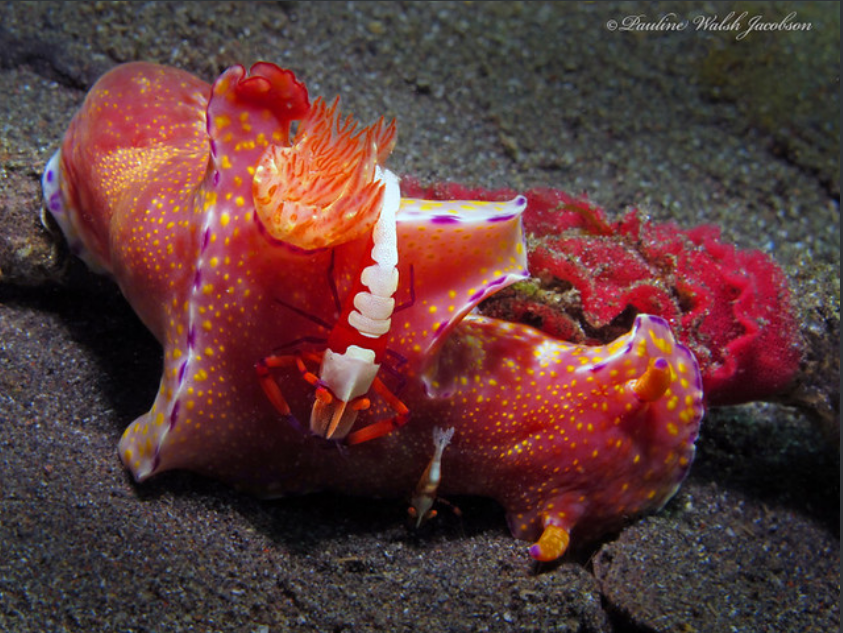 Above photo of Ceratosoma gracillimum with eggs by [Pauline Walsh Jacobson](https://www.flickr.com/photos/coralreefdreams/53111428093/) 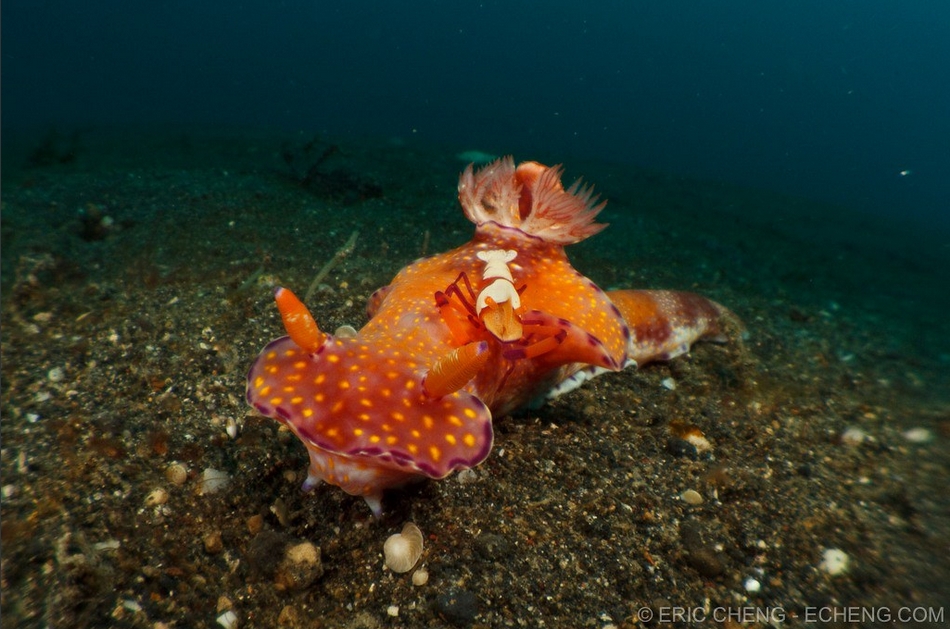 Above photo of Ceratosoma tenue by [Eric Cheng](https://www.flickr.com/photos/echeng/4431715718/) 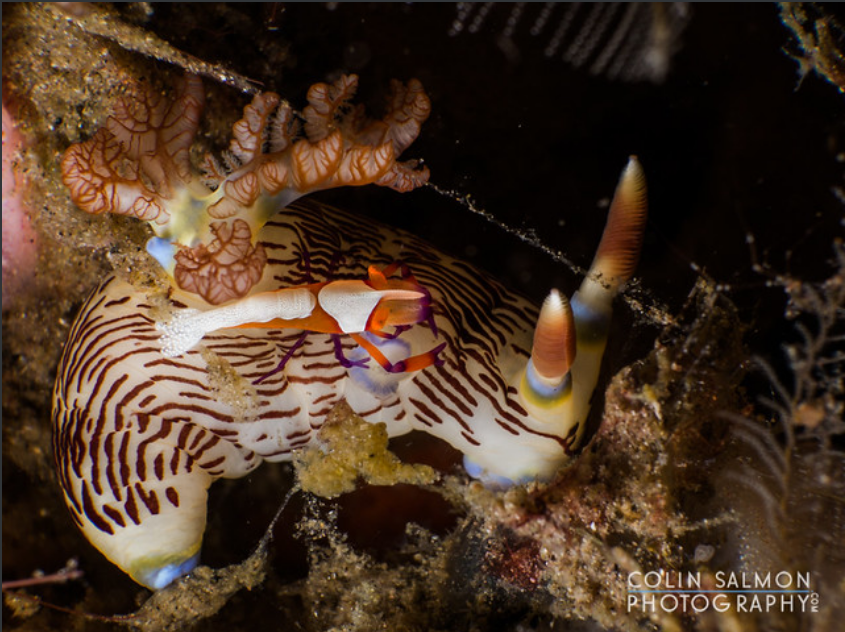 Above photo of Nembrotha lineolata, by [Colin Salmon](https://www.flickr.com/photos/colinsalmonphotography/26164286943/) 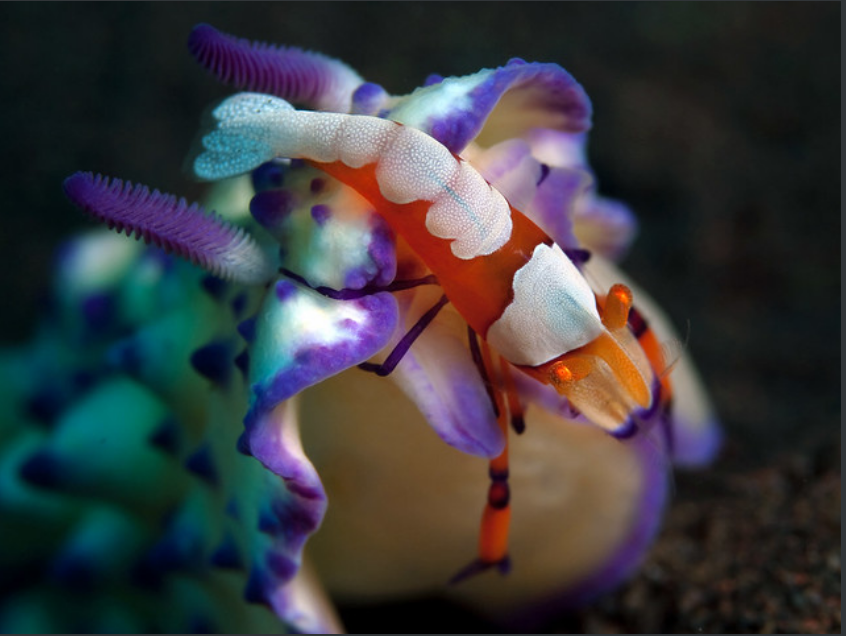 Above photo by [Doug Anderson](https://www.flickr.com/photos/douga/6179671953/) 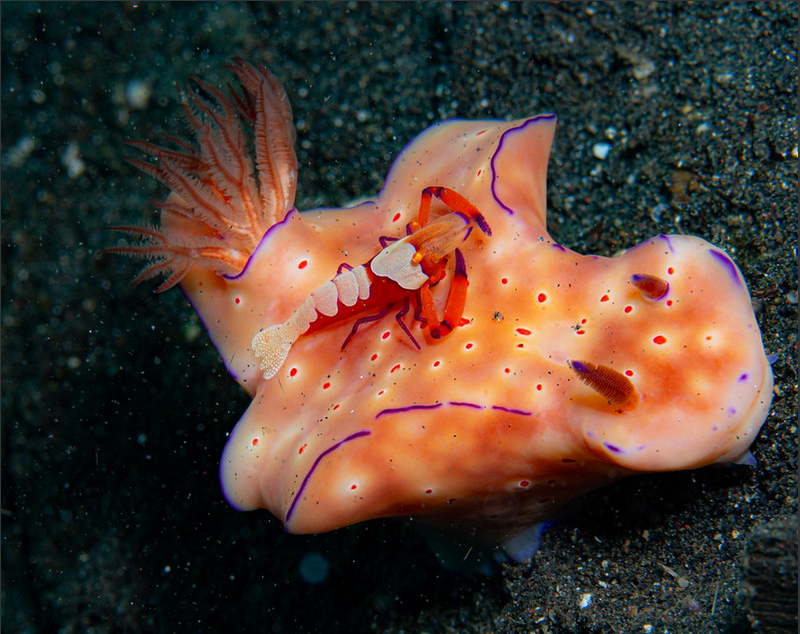 Above photo by [Michel Duchayne](https://www.flickr.com/photos/190779611@N08/50604770681/)  Above photo of Dendrodoris tuberculosa, by [Brian Mayes](https://www.flickr.com/photos/brianmayes/5986205268/)  Above photo of ceratosoma nudibranch, by [KIYOSHI OKADA](https://www.flickr.com/photos/124477069@N06/40566781253/) 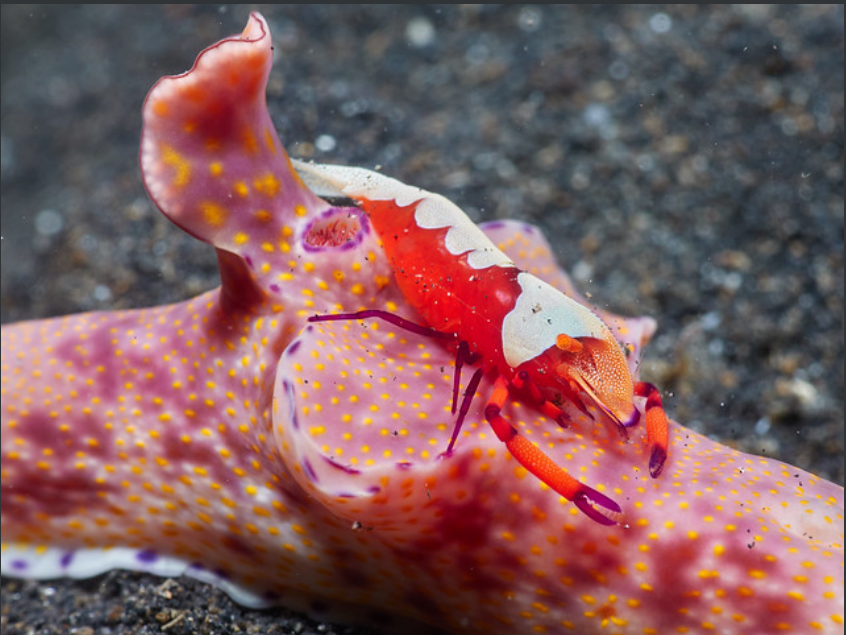 Above photo of Ceratosoma tenue, by [Gomen S](https://www.flickr.com/photos/gomensee/26348187818/)  Above photo by [Colin Robson](https://www.flickr.com/photos/22571051@N06/17387476443/) .... Hail The Emperor! 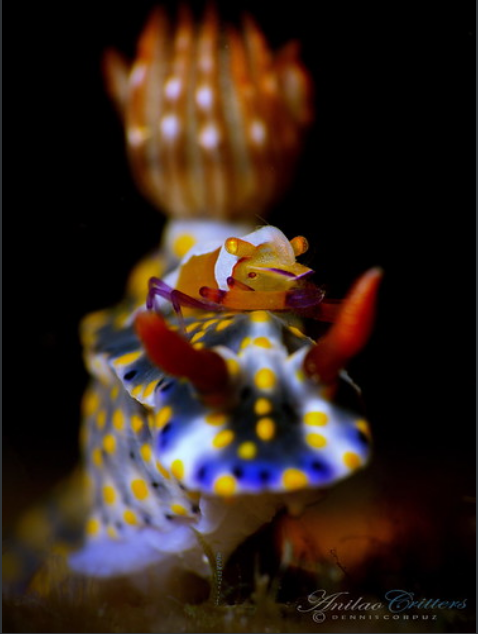 Above photo of Hypselodoris infucata, by [Anilao~Critters](https://www.flickr.com/photos/74171608@N04/15823600444/)
 quinacridone
5 months ago
•
100%
quinacridone
5 months ago
•
100%
Lol, I left a lot of photos out too!
The sex lives of hermaphrodites is really interesting to read up on, I'll probably do something similar on !invertebrates@mander.xyz....there's loads of freaky creatures out there
Part 2 is going to be eggs, larvae and mini-nudis, but I'm off on holiday soon so maybe a 2 week or more wait, unless it rains a lot

Title photo by [Todd Aki](https://www.flickr.com/photos/90966819@N00/10115535594/) - Nudibranchs are hermaphrodites (having both male and female sex organs), but they still require a mate in order to reproduce as they cannot self fertilize  Above nudibranch reproductive system by Carissa Shipman, found [here](https://www.calacademy.org/blogs/project-lab/nudi-sex-ed) - The reproductive organs are usually next to each other inside the nudibranchs body, and the exterior reproductive opening being on its right lateral side 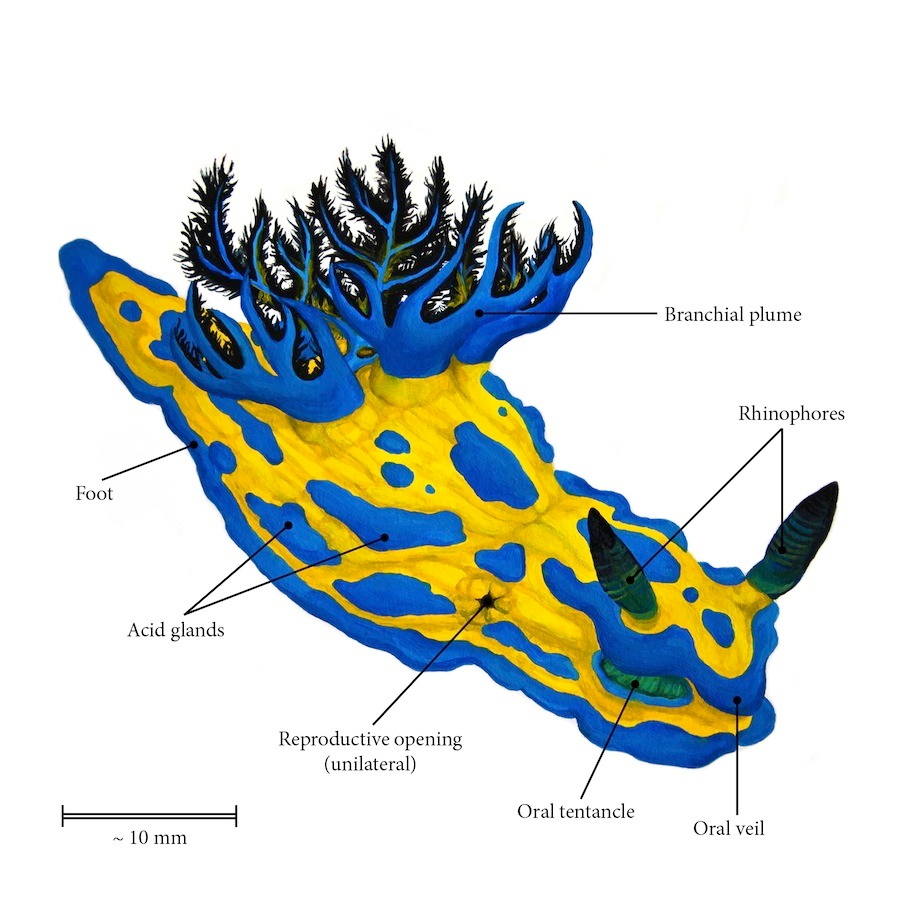 Above, 'External anatomy of a Tambja verconis nudibranch (by wadeangeliart) found [here](https://www.diveoclock.com/destinations/Asia/Philippines/Anilao_nudibranchs/) - Being simultaneous hermaphrodites increases their opportunities to find a mate, as both partners will transfer sperm, and lay eggs, via reciprocal reproduction.....although there are some exceptions as we will discover! 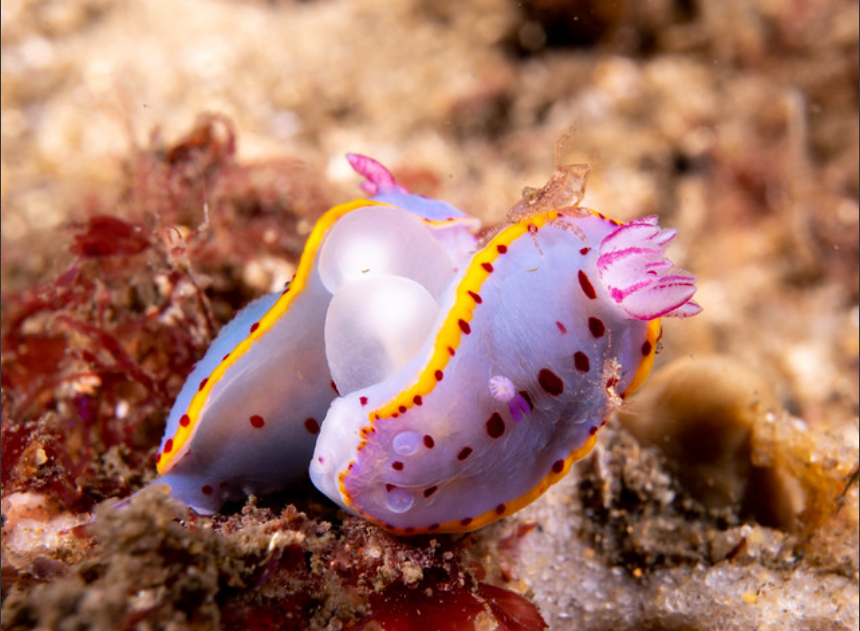 Above photo Bennett's nudibranchs Mating' by [John Turnbull](https://www.flickr.com/photos/johnwturnbull/51706507506/) - Nudibranchs will follow the scent trail left by potential partner. When they catch up with them they start courtship which involves the gentle touching of each other 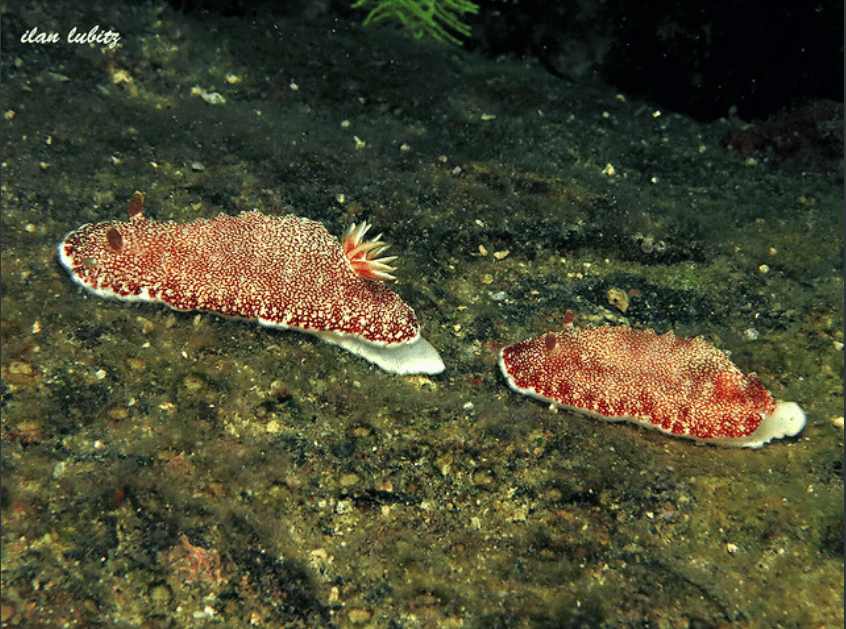 Above photo by [ilan Lubitz](https://www.flickr.com/photos/128664509@N04/26514563779/) - Depending on the species, the nudibranchs will then orientate their bodies so that their reproductive openings are facing, allowing their swollen gonopores to connect  Above photo of Nembrotha chamberlaini mating, by [Jim Greenfield](https://www.flickr.com/photos/jim1/43584566865/) 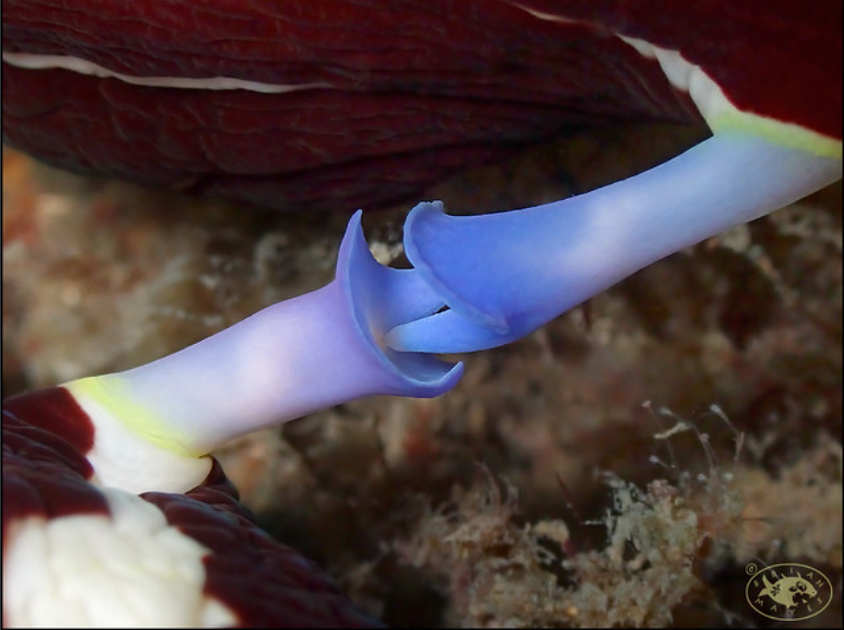 Above photo of Nembrotha purpureolineata, by [Brian Mayes](https://www.flickr.com/photos/brianmayes/53334549252/) - Nudibranchs will take every opportunity they can to mate when finding a partner. One quirk of their anatomical development whilst maturing into adults is that the male reproductive organs will grow, and be functional before their female organs. This is called protandry.... 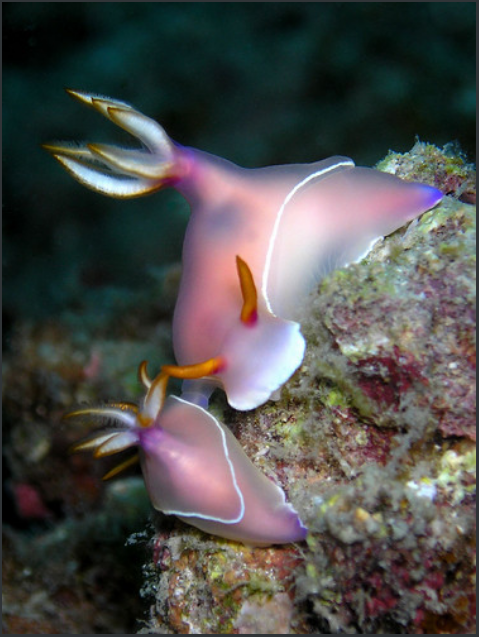 Above photo of Hypselodoris bullocki mating, by [Coppertane](https://www.flickr.com/photos/coppertane/130836284/)....a possible protandry mating, due to size difference - They can still take the opportunity to mate though as a 'male'..... It has been suggested that any sperm passed to the 'male' partner, can be stored within their bodies until their female organs have matured. It will then use the stored sperm to fertilize its eggs!  Above photo of pelagic nudibranchs mating by [Rajiv Bhambri](https://photocontest.smithsonianmag.com/photocontest/detail/mating-pelagic-nudibranchs/) - Mating duration depends on species, and can vary from brief encounters to several hours! 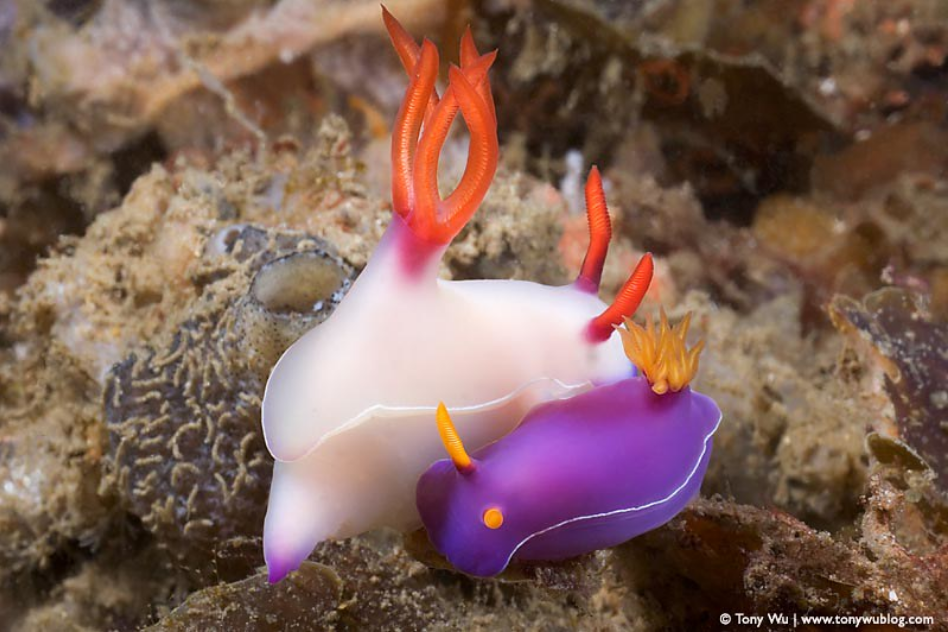 Above photo by [Tony Wu](https://www.flickr.com/photos/tonywublog/322931873/) - There are 3 basic mating positions depending on species- right side to right side..... (see photo below) 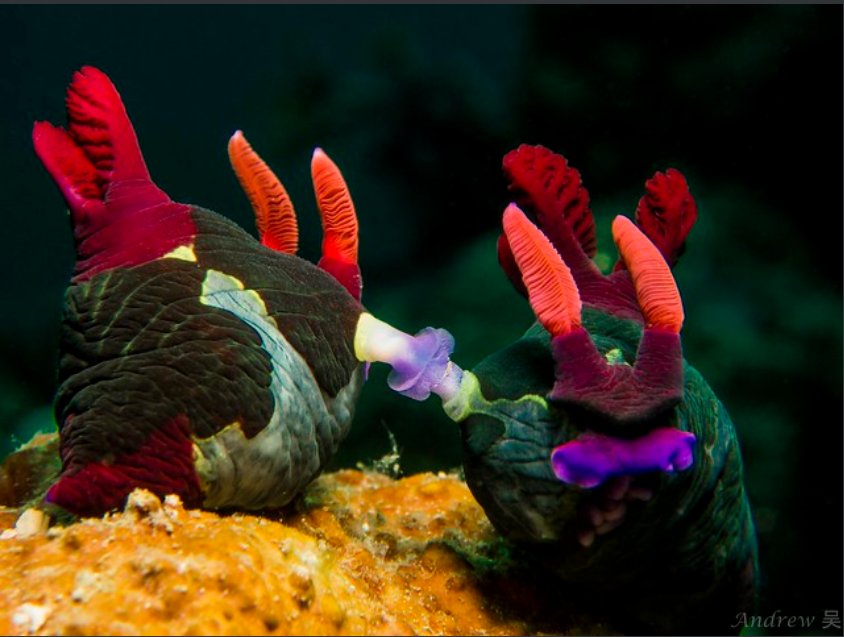 Above, Nembrotha chamberlaini, by [Andrew Wu](https://www.flickr.com/photos/namelessbear/13350412323/) - .....Head to head.....(see photo below)...... 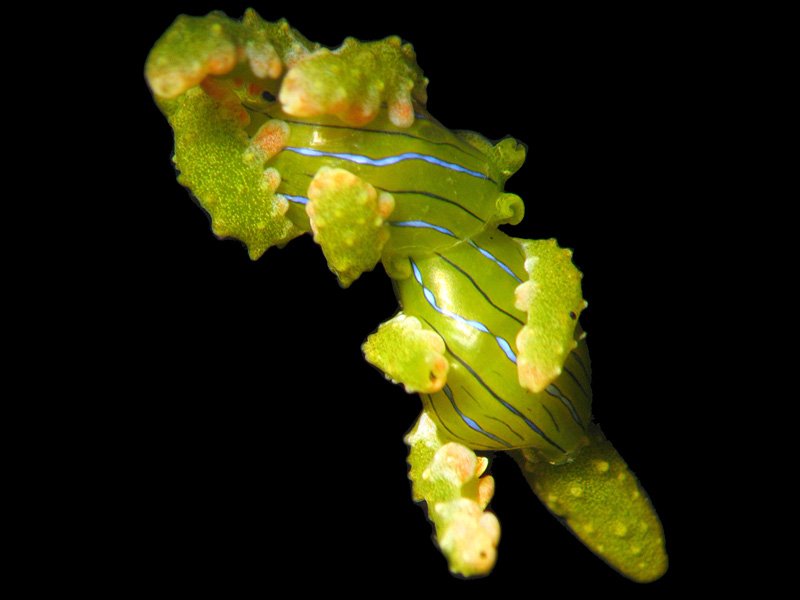 Above, Lobiger viridis, from [here](https://nudibranchdomain.org/rudie-nudies-the-mating-game/) - ......And head to tail, which is either a reciprocal, or a unilateral process depending upon flexibility of the species, or even partner aggression......(see photo below)... 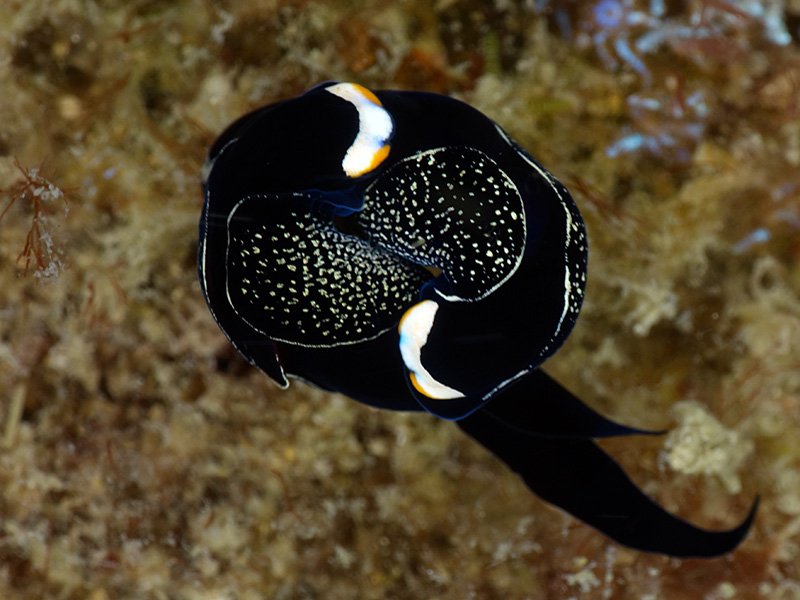 Above, Mariaglaja inornata, from [here](https://nudibranchdomain.org/rudie-nudies-the-mating-game/). The genitals are separate in this species- the penis is in the head, and the vagina in the tail 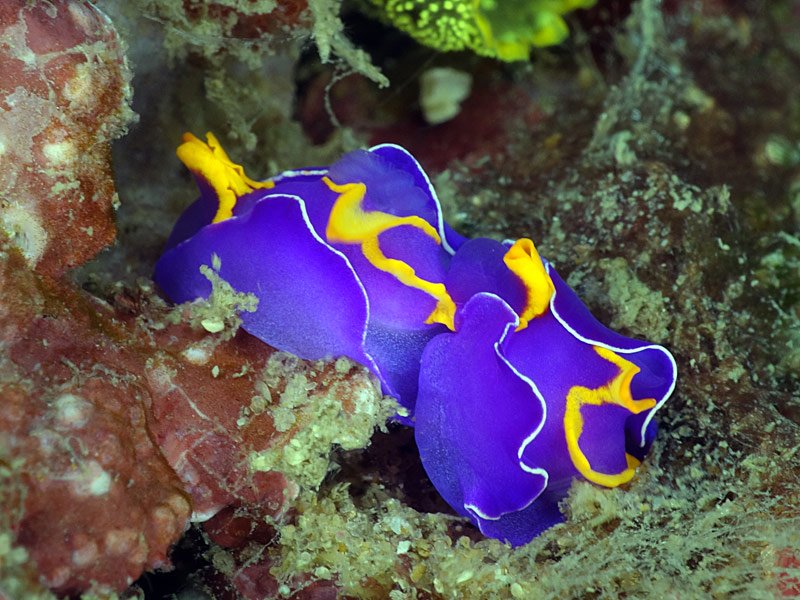 > [Above] The gastropterid sea slug Sagaminopteron ornatum will sometimes form a circle of two to achieve reciprocal mating, or at other times as illustrated here, act unilaterally as a male by approaching from behind to copulate with another acting as a female. [source](https://nudibranchdomain.org/rudie-nudies-the-mating-game/) - Hypodermic Insemination is the preferred method used by some species. The penis has a sharp point which is used to stab the partner in order to deliver a packet of sperm. This can be done either as a mutual act, or happening unilaterally with one nudibranch taking advantage to inseminate another....This can occur amongst some of the sacoglassans 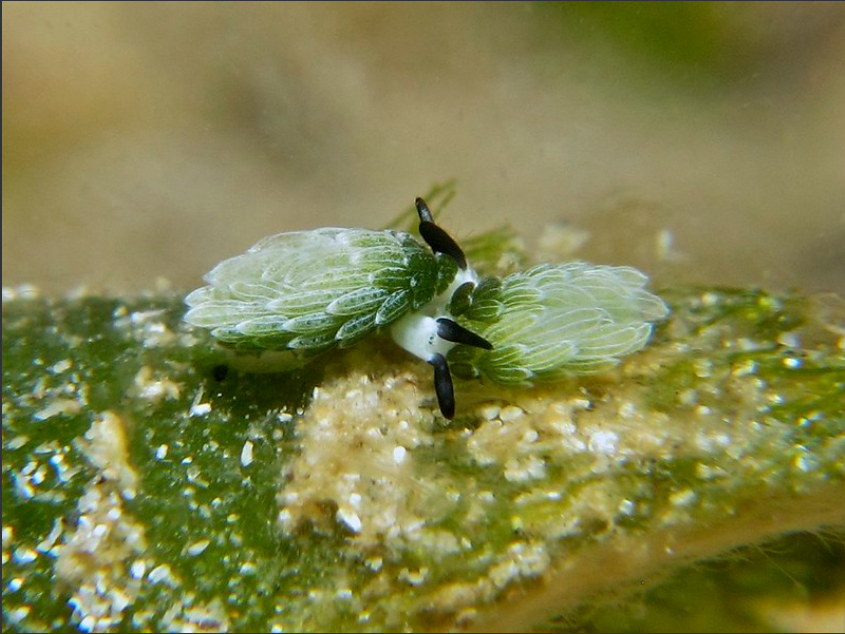 Above photo of Costasiella usagi, by [eunice khoo](https://www.flickr.com/photos/mermate/14194152102/)....not as cute as I originally thought.... - Goniobranchus reticulatus is an unusual nudibranch as after it has mated the external part of its penis detaches! And within 24 hours it grows back.....! >Scientists think this mating strategy has evolved so the sperm of rival nudibranchs stored in the vagina of their mate will not accidentally get passed on to future mates [source](https://www.calacademy.org/blogs/project-lab/nudi-sex-ed) 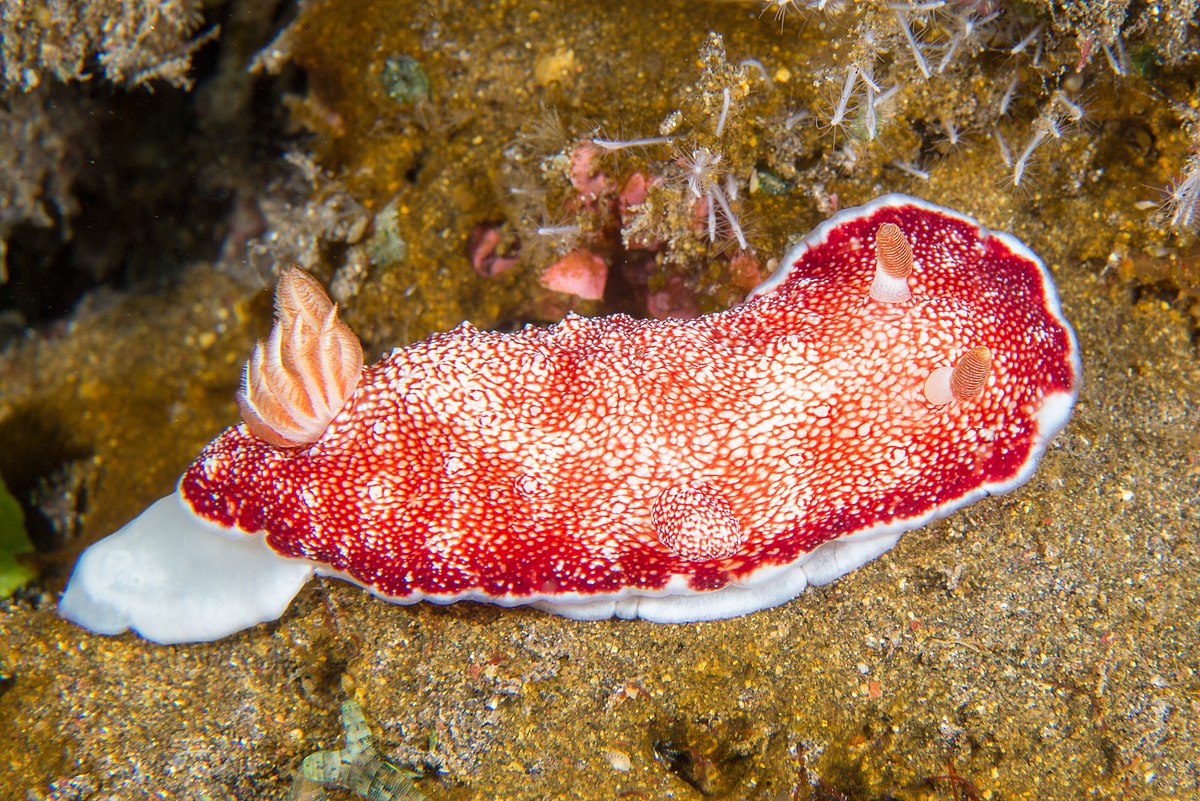 Above photo of Goniobranchus reticulatus by [Bernard Picton](https://en.wikipedia.org/wiki/File:B150318_Goniobranchus_reticulatus.jpg)...with or without penis...(Schrodinger's penis?) ...And finally a shrimp jockey on a pair of mating nudis.... 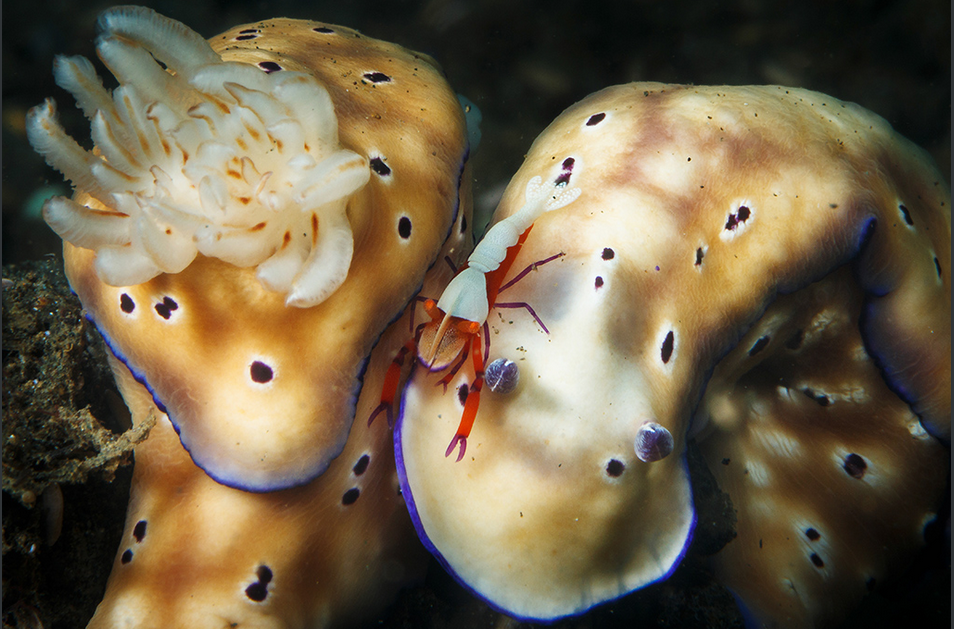 Above photo by [Ludovic](https://www.flickr.com/photos/luko/34086526786/) Information from- [here](https://biologydictionary.net/nudibranch/) [here](https://en.wikipedia.org/wiki/Goniobranchus_reticulatus) and the fantastic [Nudibranch Domain](https://nudibranchdomain.org/rudie-nudies-the-mating-game/) As always, I'm not an expert...any errors let me know in the comments, and I'll edit my post!
 quinacridone
5 months ago
•
100%
quinacridone
5 months ago
•
100%
No probs, it gives me an excuse to scroll through flickr 👍

Main photo by [Dusan Beno](https://www.flickr.com/photos/29855281@N06/5867100103/in/pool-insects-studio-stacks/) 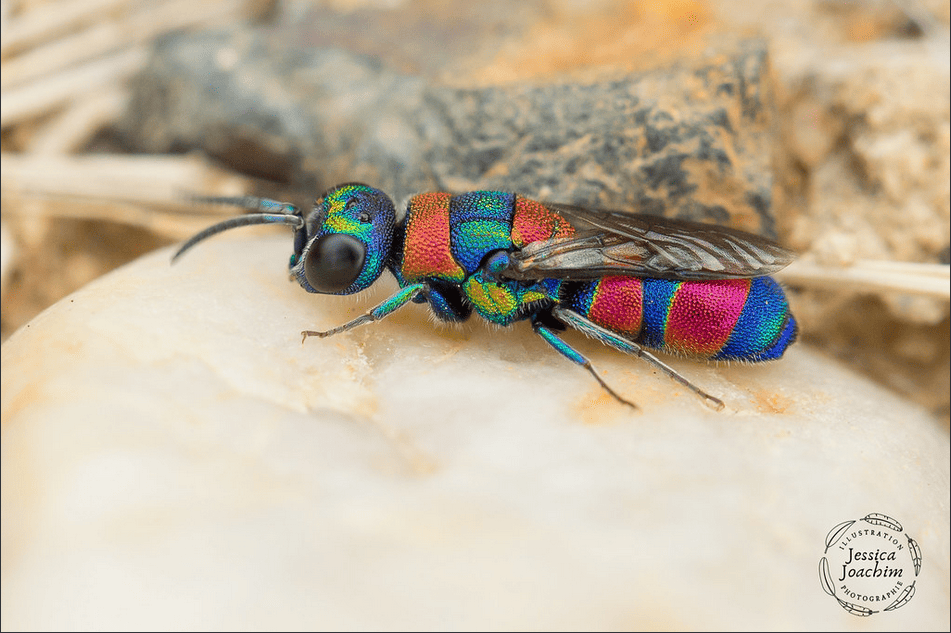 Above, 'Chrysis semicincta' by [Jessica JOACHIM](https://www.flickr.com/photos/tifaeris/48821515013/in/gallery-42145526@N03-72157720322864224/)  Above, 'Cotinis Mutabilis, also known as the Figeater Beetle' by [Cotinis Mutabilis](https://www.flickr.com/photos/tanneryates/6024877920/in/pool-insects-studio-stacks/)  Above photo by [philux66](https://www.flickr.com/photos/pcoffe/51975661218/in/pool-insects-studio-stacks/)  Above, 'Green Tortoise Beetle, Cassida viridis' by [Duncan Cooke](https://www.flickr.com/photos/happydayzphotography/52077353016/in/pool-world_wide_amazing_nature/) >Length; 7 - 10mm. > >Distribution; Widespread in England and Wales, although sparse in the north and rarer in Scotland. > >Habitat; Grassland, Heathland & Moorland, Farmland, Wetlands, Woodland & Gardens. > >Found; April to October. > >The Green Tortoise Beetle is one of a group of several closely related beetles. Host plants include White Dead-nettle, Hemp Nettles, Hedge Woundwort, Gypsywort and Water Mint and is often found in gardens. When disturbed, the adults behave just like tortoises, retracting their antennae and feet, and pulling their 'shell' tight down around them as they grip tightly on to the leaf they are. > >The Green tortoise beetle is round, flattened and lime green. Tortoise beetles are easy to identify as a group, but there are several closely related species that are very difficult to tell apart. the Green Tortoise Beetle is entirely green and generally lacks the markings of other species. Cassida viridis is similar to Cassida rubiginosa but can be distinguished by the rounded rear corners of the pronotum which are sharp in C. rubiginosa. It is also usually more apple green in colour. > >Adults spend a few weeks feeding on host foliage and possibly also pollen before mating in April and May and ovipositing from May to July. Between 1 and 10 eggs laid in firm-walled and distinctive egg cases which are stuck to stems or under lower leaves and covered with frass and leaf fragments. They hatch within 6 to 10 days and the larvae initially feed below the leaves, moving to the upper surface as they grow, they pass through 5 instars and develop rapidly. They are fully grown within 4 to 6 weeks. > >Pupation occurs from June to September. The fully grown larvae move to stems and petioles and become attached by a secretion before they pupate. This stage is also brief, generally lasting about a week, and new generation adults emerge from July to October.  Above 'Green vegetable or Shield bug' by [Bernard Spragg. NZ](https://www.flickr.com/photos/volvob12b/52651443368/in/pool-world_wide_amazing_nature/) >Nezara viridula, commonly known as the southern green stink bug, southern green shield bug or green vegetable bug, is a plant-feeding stink bug. Believed to have originated in Ethiopia, it can now be found around the world. 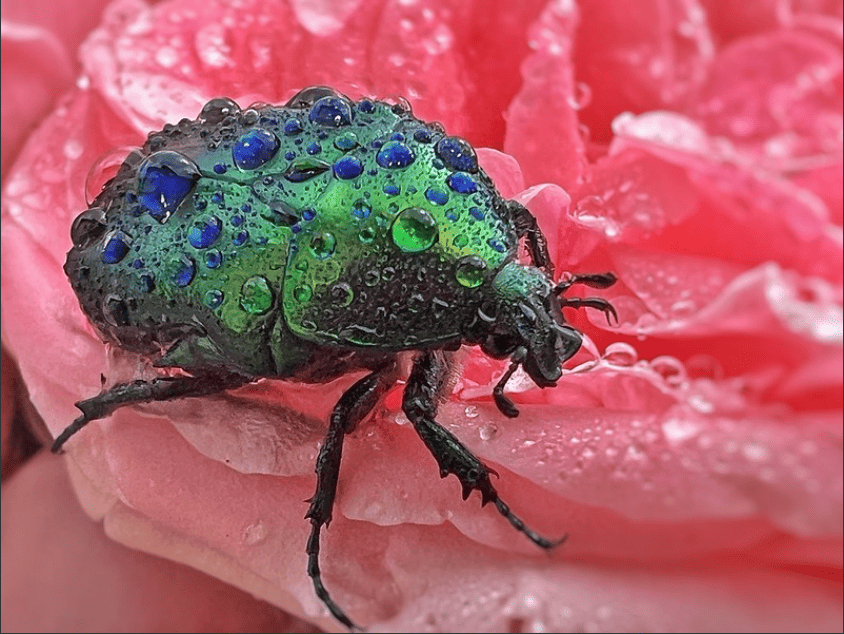 Above, 'Golden Beetle' by [Ivan Anisimov](https://www.flickr.com/photos/outstanding_macro/53611793101/in/pool-closeupandmacrophotograpygroup/)

-Leeches are found all across the world, except Antarctica, so far around 700 species of leech have been described. Approximately 100 are marine, 480 freshwater and the remainder are terrestrial different species…. All of these are divided into 2 major infraclasses >1. Euhirudinea: the 'true' leeches – marine, freshwater and terrestrial – which have suckers at both ends and lack chaetae (bristles) > > >2. Acanthobdellida: a small northern hemisphere infraclass ectoparasitic on salmoniid fish, which lack an anterior sucker and retain chaetae. > > >The Euhirudinea is further divided into two orders: > > 1. Rhynchobdellida: jawless marine and freshwater leeches with a protrusible proboscis and true vascular system > >2. Arynchobdellida: jawed and jawless freshwater and terrestrial leeches with a non-protrusible muscular pharynx and a haemo-coelomic system. [source](https://australian.museum/learn/animals/worms/leeches/#top)  Above image from [here](https://www.researchgate.net/profile/Muzaffer-Durmus/publication/305690889/figure/fig1/AS:483042151145472@1492177631675/Anatomy-of-Hirudo-medicinalis-the-first-defined-by-Hippocrates-460-370-BC-who.png) -Leeches are segmented parasitic or predatory worms, and are closely related to earthworms -They have suckers at both ends of their bodies and use them to travel around by ‘looping’ or ‘crawling.’ Some species can also swim like an eel  Above image by Chiswick Chap via [wikipedia](https://en.wikipedia.org/wiki/File:Leech_looping_locomotion.jpg) -All leeches are hermaphrodites, although they prefer to find a mate to exchange sperm packets with….. -They can live in both fresh and salt water, and there are some which are terrestrial, living on the ground or on low growing plants waiting for a meal to brush past -Some species can even survive extremely dry conditions by burrowing into the soil where they can stay without any water. Their bodies contract, becoming dry and rigid, but within 10 minutes of water contact they emerge, ready to go! -The most famous type of leech is probably the European medicinal leech (Hirudo medicinalis), which was used extensively in the past (the first recorded case being Ancient Egypt 3500 years ago). Its populations in the wild have dropped significantly due to over exploitation for the medical industry 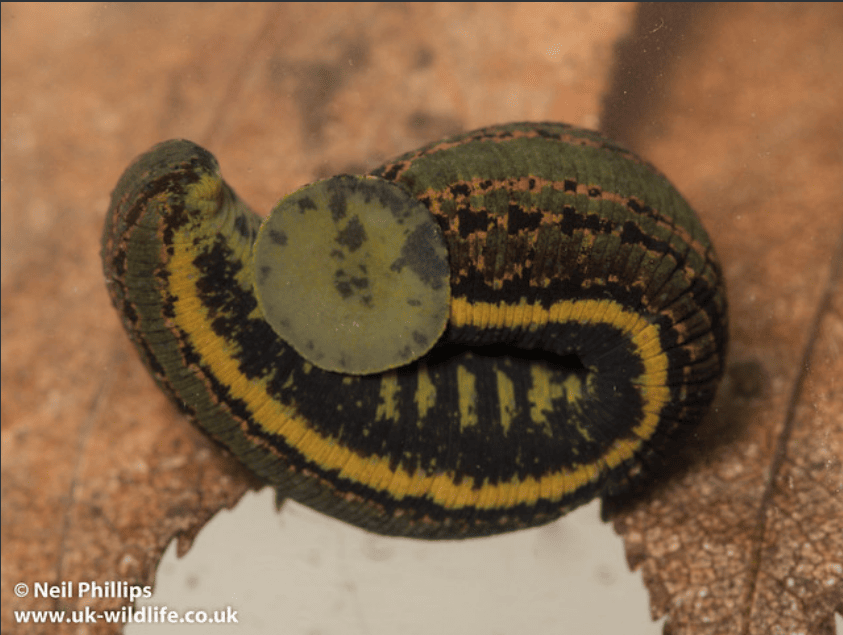 Photo by [Neil Phillips](https://www.flickr.com/photos/ukwildlife/15365527517/) -Manchester Royal Infirmary used 50,000 leeches in one year in 1831, but use of the medicinal leech started to decline during the late 19th century. However, since the 1970’s they have made a comeback due to their use in micro surgery. Their anti coagulant saliva allows blood to keep flowing, and wounds to stay open during reattachment and reconstructive surgery! 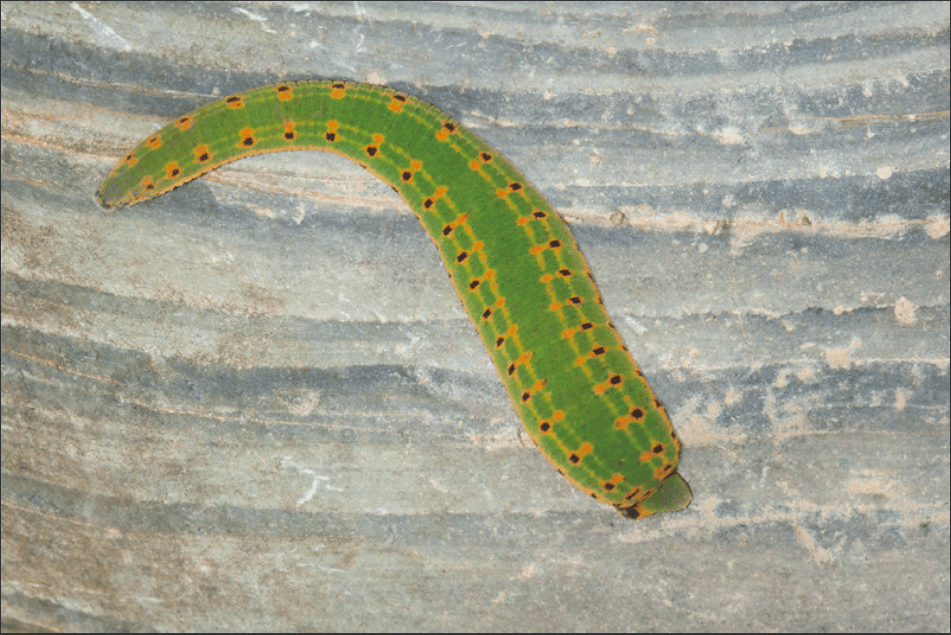 Photo by [Armando Caldas](https://www.flickr.com/photos/8793530@N03/4086985444/) -Hirudo medicinalis are ‘jawed’ leeches (Gnathobdellida). They have 3 jaws resembling rotary saws which have around 100 sharp edges used to incise the host which leaves a Y shape wound on the skin. They are so tiny their bite is virtually painless. Blood suckers are only one type of leech though... -Other species of jawed leeches can have between 1 and 3 jaws. Detrivorous species use their jaws for chewing and swallowing soft food particles, whilst the carnivores use them to cut a hole in the body walls of invertebrate prey (molluscs, worms, insect larvae), in order to suck out the soft innards. 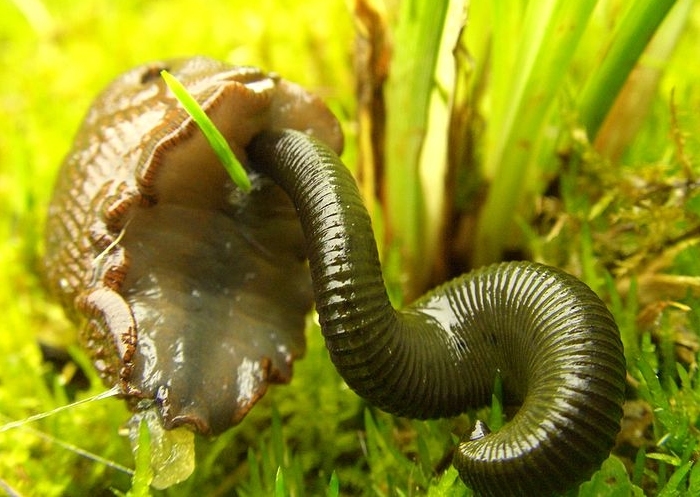 Photo by [Manuel Krueger-Krusche](https://bogleech.com/leeches) -The largest fresh water leech in the world is Haementeria ghilianii, (the Amazon giant leech) which can grow up to 450mm long and 100mm wide. One end of the leech contains its head, and the other the proboscis, which is 10cm long and like a hypodermic needle. It is capable of feeding on humans, rabbits, cattle and horses and a report from 1899 claims it could feed in such numbers that it could kill cattle and birds 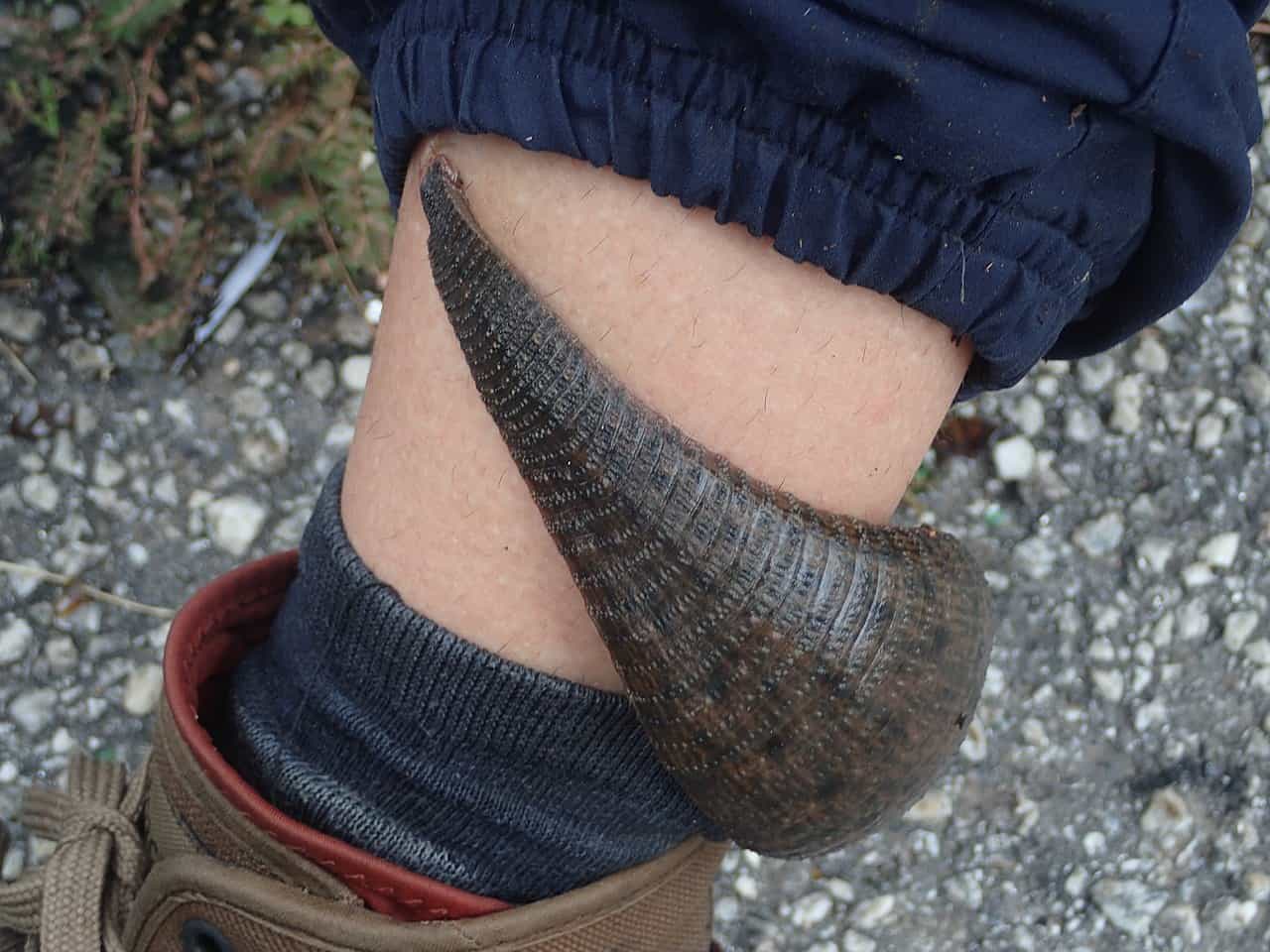 Photo by [Anonyme973](https://en.wikipedia.org/wiki/Haementeria_ghilianii#/media/File:Haementeria_ghilianii_4.jpg) -Its male reproductive parts can weigh 3-5 grams, and the female parts weigh in at 10 grams, they are capable of producing egg clutches ranging from 60 to 500 eggs -It was thought to be extinct in 1893, however during the 1970s Dr Roy Sawyer discovered 2 specimens in a pond in French Guiana. One of these was transferred to the UC Berkeley where it was part of a ‘breeding’ program. Named ‘Grandma Moses’ it managed to produce 750 offspring over 3 years, and helped to bring the Amazon Giant Leech back from the brink of extinction 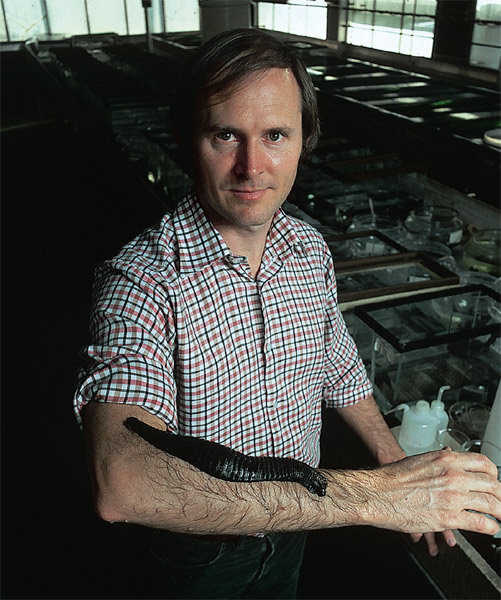 [Dr. Roy Sawyer and friend](https://bogleech.com/leeches) photographed by Timothy Branning -When it died, ‘Grandma Moses’ was given to the Smithsonian National Invertebrate Collection where it still resides preserved in alcohol! 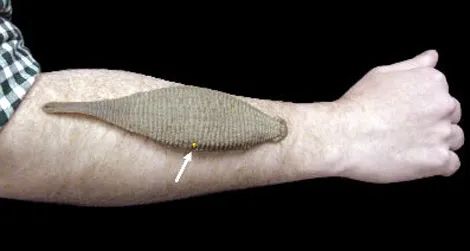 [The Grandma Moses leech](https://www.smithsonianmag.com/smithsonian-institution/the-list-5-weirdest-worms-at-the-smithsonian-47017905/) -A small minority of leech species have no jaws or teeth (these are the worm leeches or Pharyngobdellida). Instead they swallow their prey, usually small invertebrates, whole! -The Kinabalu giant red leech (Mimobdella buettikoferi) is probably one of the longest leeches, growing over 50cm. 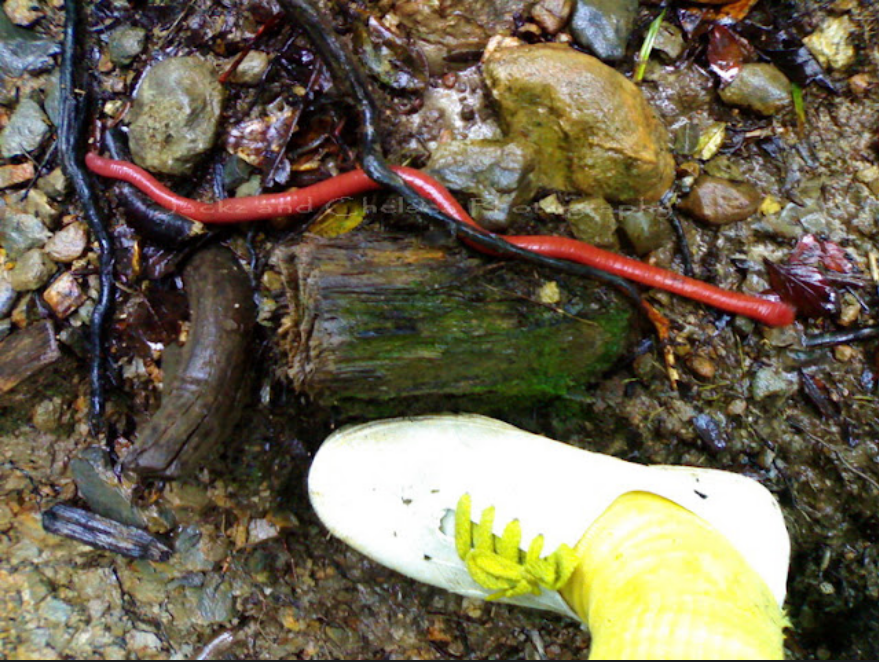 Above photo from [here](https://zc-lovenaturewildlife-studio.blogspot.com/p/giant-red-leech-of-mount-kinabalu-sabah.html) -It lives only on Mt Kinabalu, Borneo and feeds on an equal giant prey, the Kinabalu giant earthworm (Pheretima darnleiensis) 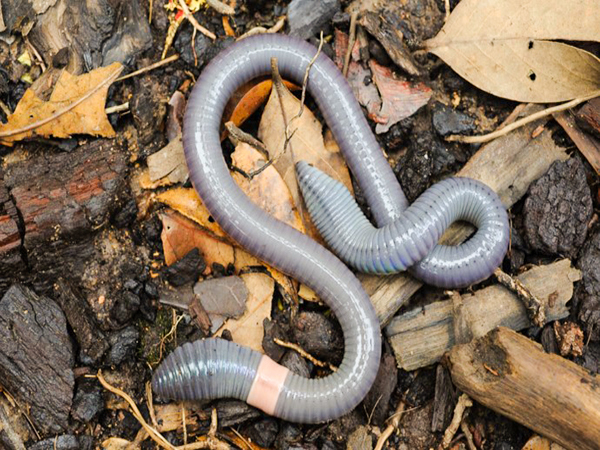 Kinabalu giant earthworm, Photo by [Chien Lee](https://www.flickr.com/photos/25872797@N02/33381593598/in/gallery-42145526@N03-72157720322864224/)  Kinabalu giant earthworm, Photo by [Ivan Kwan](https://www.flickr.com/photos/hai_ren/4262577818/) -It lives among the leaf litter and soil, and both leech and worm are usually seen during or after a downpour…. 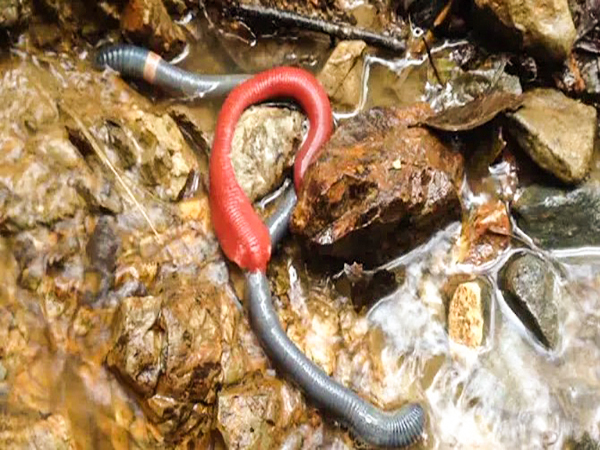 Found [here](https://www.inaturalist.org/taxa/889425-Mimobdella-buettikoferi/browse_photos) >A hungry leech is very responsive to light and mechanical stimuli. It tends to change position frequently, and explore by head movement and body waving. It also assumes an alert posture, extending to full length and remaining motionless. This is thought to maximise the function of the sensory structures in the skin. [source](https://australian.museum/learn/animals/worms/leeches/#top) 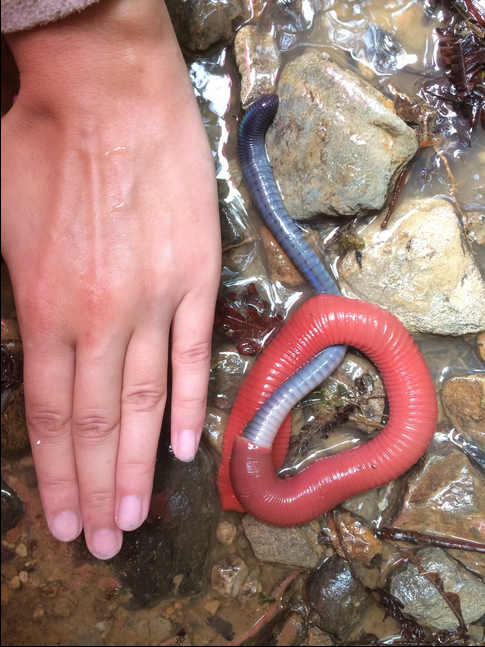 Photo from [here](https://www.inaturalist.org/taxa/889425-Mimobdella-buettikoferi/browse_photos) -When it finds a worm it begins to grope towards an end, then it begins to suck….. [Here](https://www.bbc.co.uk/programmes/p027f9q0) is a delightful film of just that! Also on [youtube](https://www.youtube.com/watch?v=0fGGz6d3vC4&themeRefresh=1) 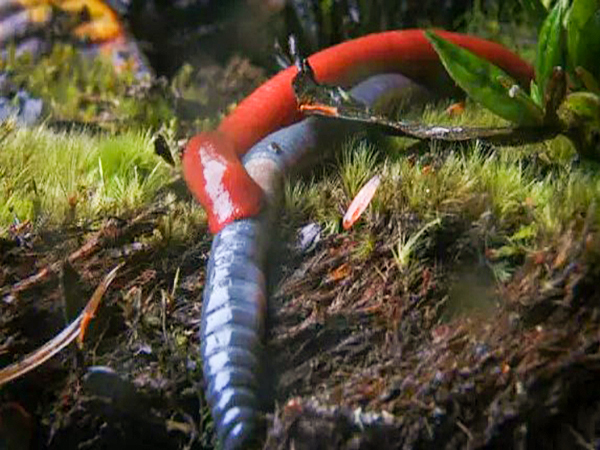 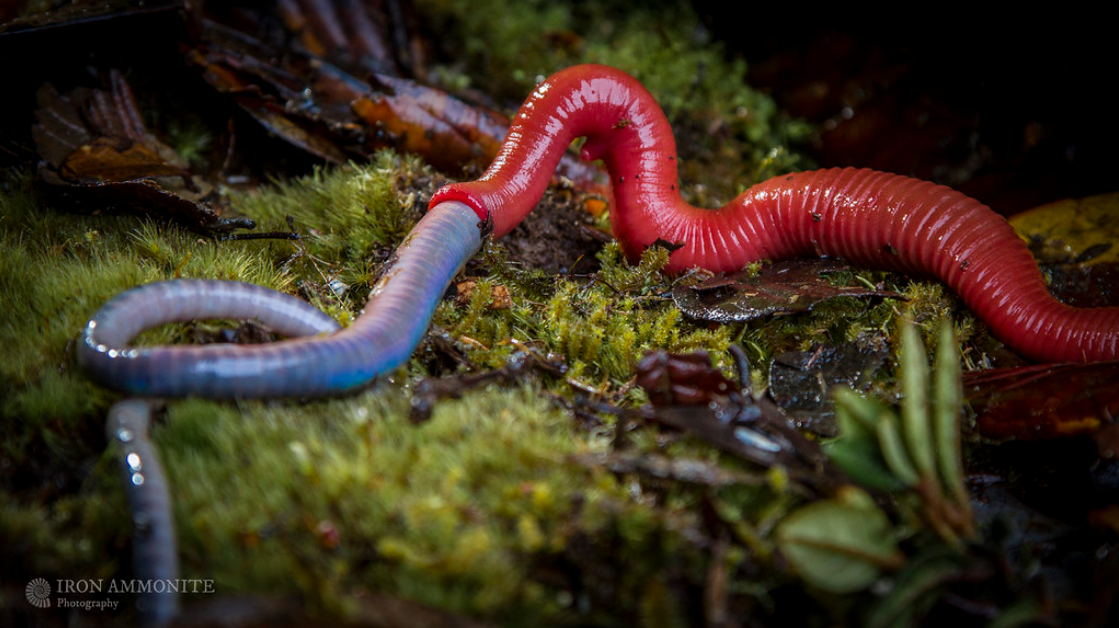 Above photos by [Paul Williams](https://www.flickr.com/photos/ironammonite/15366274391/) -Almost all leeches have at least one pair of tiny eyes, however some can have up to 16, these are arranged in patterns although their vision may only be able to detect light and dark.  Photo by [Paul](https://www.flickr.com/photos/rainforests/8316883892/in/gallery-quasimodo-72157660594159737/) -Glossiphoniid leeches demonstrate exceptional parental care for their offspring, which is the most highly developed for the annelids (the worm species). They produce a membranous bag in which they keep their eggs, this is carried on the underside of their bodies. When the young hatch they attach onto their parents belly (but not with a feeding bite) and the parent carries them to their first meal!  Above photo by [Maralee Joos](https://www.flickr.com/photos/wildflorida/5858291248/in/gallery-quasimodo-72157660594159737/)  Above photo by [Duncan Cooke](https://www.flickr.com/photos/happydayzphotography/7465798834/in/gallery-quasimodo-72157660594159737/)  Above photo by [Duncan Cooke](https://www.flickr.com/photos/happydayzphotography/7465798580/in/gallery-quasimodo-72157660594159737/) >Helobdella, which have a world-wide distribution, display the most highly developed parental care system: they not only protect but also feed the young they carry. This results in the young being much larger when they leave the parent and, presumably, in higher subsequent survival. [source](https://www.sciencedirect.com/science/article/abs/pii/S1431761304700336)  Above photo by [Dick Todd](https://www.flickr.com/photos/36044199@N00/11824464484/in/gallery-quasimodo-72157660594159737/) -Leeches are quite hardy, some can survive in low oxygen environments, others at low ocean depth such as…. >Bathybdella sawyeri occurs at 2447–2623 m depth at the Galápagos Rift and the Southeast Pacific Rise and Galatheabdella bruuni has been found at depths of 3880–4400 m in the Tasman Sea (Richardson and Meyer, 1973; Burreson, 1981; Burreson and Segonzac, 2006). However, the leech that occurs at the greatest depth is Johanssonia extrema described by Utevsky et al. (2019) that was collected at a depth of 8728.8 m in the Kuril-Kamchatka Trench. Occurring at that depth, J. extrema withstands pressure that is over 870 times greater than that at sea level. [source](https://www.ncbi.nlm.nih.gov/pmc/articles/PMC7569739/) -Some species have evolved to live within the extreme dark of caves, others to withstand the extreme cold of arctic waters, one lives in waters of high alkalinity with the addition of arsenic at levels >110mg/L >Members of Praobdellidae are characterized by feeding primarily from mucous membranes [mouth, throat, nasal passages, and under the eyelids] particularly of mammals, but also from the skin of amphibians. This behavior is considered equally unnerving by both academic and public audiences. [source](https://www.ncbi.nlm.nih.gov/pmc/articles/PMC7569739/) -A backpacker returning from Vietnam discovered she had also brought home a leech passenger that was attached inside her nostril "At one point, I could feel him up at my eyebrow," she said. It was removed at Liverpool Hospital, before it could reach her brain…. She than kept the leech named ‘Mr Curly’ as a pet…. delightful! -One other leech has evolved to live in another type of orifice...*a hippos anus!* >…...Placobdelloides jaegerskioeldi inhabits one of the most extreme environments of all of the leeches that invade orifices, the rectum of the hippopotamus (Oosthuizen and Davies, 1994). Adult P. jaegerskioeldi have papilla-bearing tubercules that are postulated to provide traction against the anal-wall of the hippopotamus (Oosthuizen and Davies, 1994). This species is also one of the few glossiphoniid leeches that can actively swim and swims (even upstream) to its hippopotamus host (Oosthuizen and Davies, 1994). [source](https://www.ncbi.nlm.nih.gov/pmc/articles/PMC7569739/) As always, I’m not and expert I just like finding and sharing fun things I find on the internet. Any mistakes or errors, let me know in the comments and I’ll edit my post! All information via wikipedia- [Leech](https://en.wikipedia.org/wiki/Leech) [Giant Amazon Leech](https://en.wikipedia.org/wiki/Haementeria_ghilianii) [Medicinal Leech](https://en.wikipedia.org/wiki/Hirudo_medicinalis) [Kinabalu Giant Leech](https://en.wikipedia.org/wiki/Kinabalu_giant_red_leech) [Glossiphoniidae](https://en.wikipedia.org/wiki/Glossiphoniidae) Except these- [Bogleech](https://bogleech.com/leeches) [Smithsonian Magazine](https://www.smithsonianmag.com/smithsonian-institution/the-list-5-weirdest-worms-at-the-smithsonian-47017905/) [Australian Museum](https://australian.museum/learn/animals/worms/leeches/#top) [buzzfeed](https://www.buzzfeednews.com/article/rachelzarrell/meet-mr-curly#40dnf0u) [Leeches in the extreme: Morphological, physiological, and behavioral adaptations to inhospitable habitats](https://www.ncbi.nlm.nih.gov/pmc/articles/PMC7569739/) [mentalfloss](https://www.mentalfloss.com/article/76821/10-juicy-facts-about-leeches) [The Evolution of Parental Care in Freshwater Leeches](https://www.sciencedirect.com/science/article/abs/pii/S1431761304700336)
 quinacridone
5 months ago
•
100%
quinacridone
5 months ago
•
100%
Follow the photographer links and you'll find plenty more! There are a lot of talented people out there...... who aren't me lol

Main photo 'Wasp' by [Joshua Coogler](https://www.flickr.com/photos/134685632@N07/51928456758/in/pool-insects-studio-stacks/)  Above, 'Pachyrrhynchus ocelatus' by [Raúl García Navarro](https://www.flickr.com/photos/160304944@N04/52029423095/in/pool-insects-studio-stacks/) 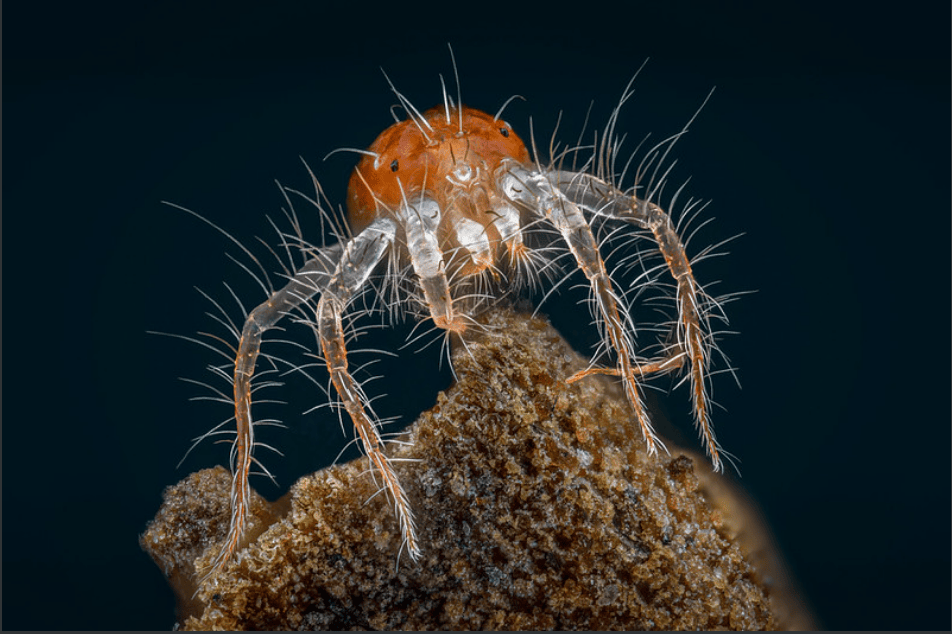 Above, 'Mite SP' by [Harry Sterken](https://www.flickr.com/photos/harrysterken/51991874677/in/pool-insects-studio-stacks/) 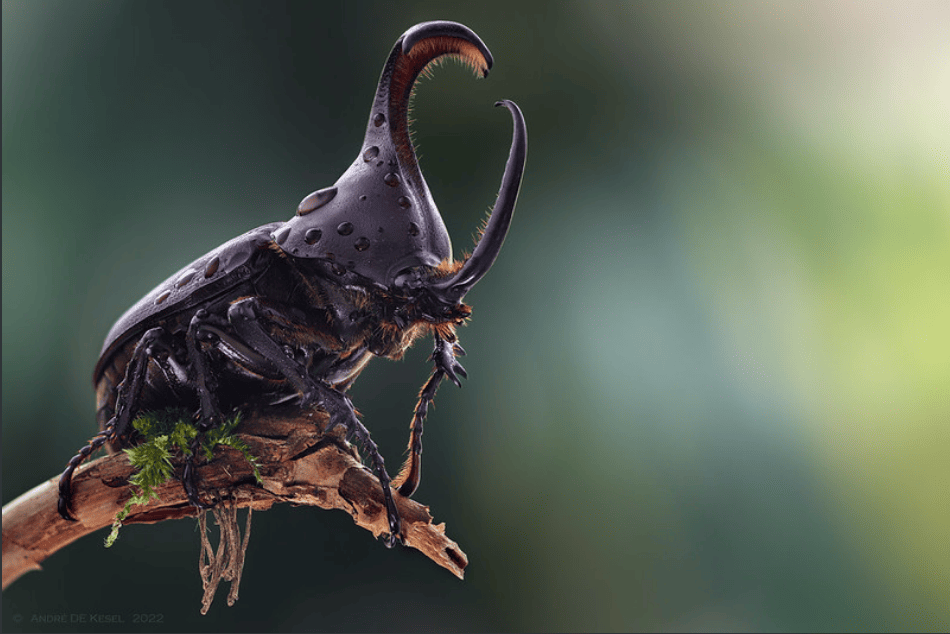 Above, 'Golofa claviger - Giant rhinoceros beetle' by [André De Kesel](https://www.flickr.com/photos/andredekesel/52102568867/in/pool-insects-studio-stacks/) 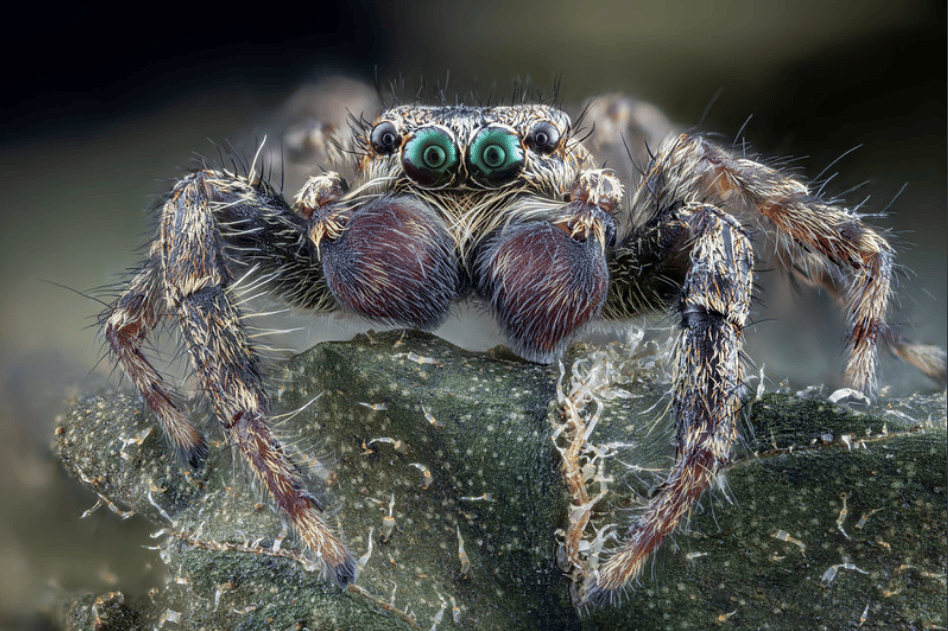 Above, 'Jumping spider SP (male)' by [Harry Sterken](https://www.flickr.com/photos/harrysterken/52261021618/in/pool-insects-studio-stacks/) 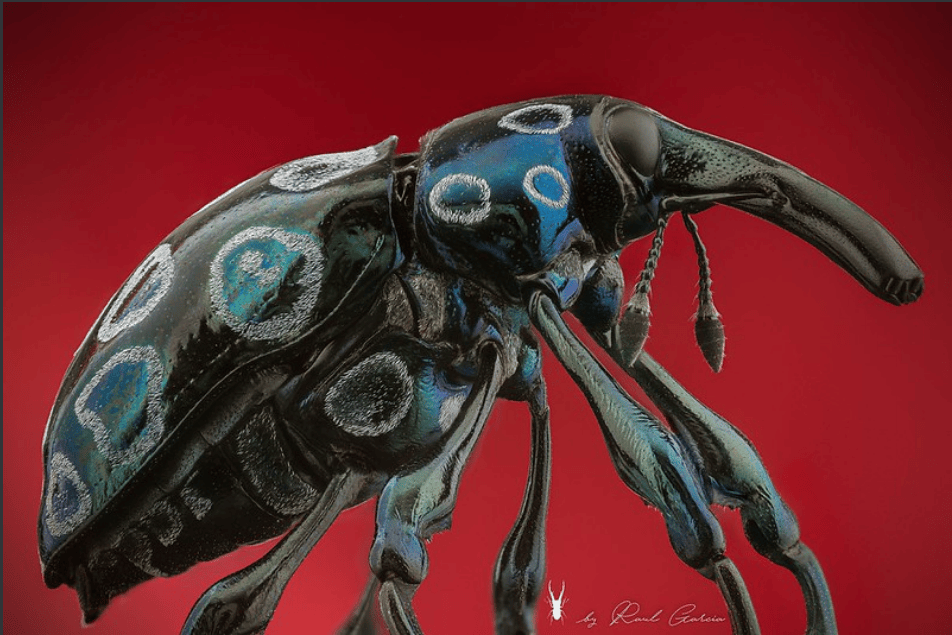 Above, 'Alcidodes Ocellatus' by [Raúl García Navarro](https://www.flickr.com/photos/160304944@N04/52058527033/in/pool-insects-studio-stacks/)

Main photo..........Spanish Dancer Nudibranch. Photograph by David Doubilet >There are more than 3,000 known nudibranch species, and scientists estimate there are another 3,000 yet to be discovered. So-called Spanish dancers, like this one off the coast of New South Wales, Australia, boast some distinctions over other nudibranchs: First, they can be enormous, reaching a foot and a half (46 centimeters) long. Most nudibranchs are finger-size. Second, it can swim, a skill most of its cousins lack. 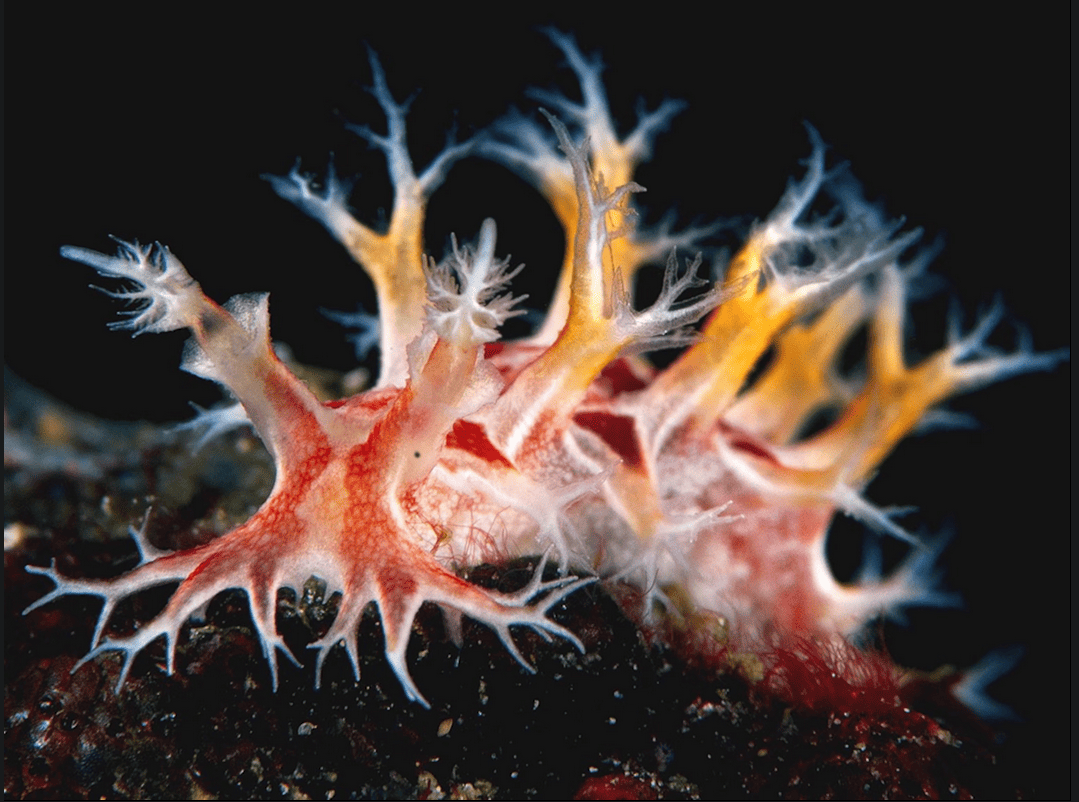 Above, Tritonia Nudibranch. Photograph by Jeffrey de Guzman Members of the mollusk family, nudibranchs abandoned their shells millions of years ago. Their scientific name, Nudibranchia, means "naked gills," and describes the feathery gills and horns that most, like this Tritonia species, wear on their backs. 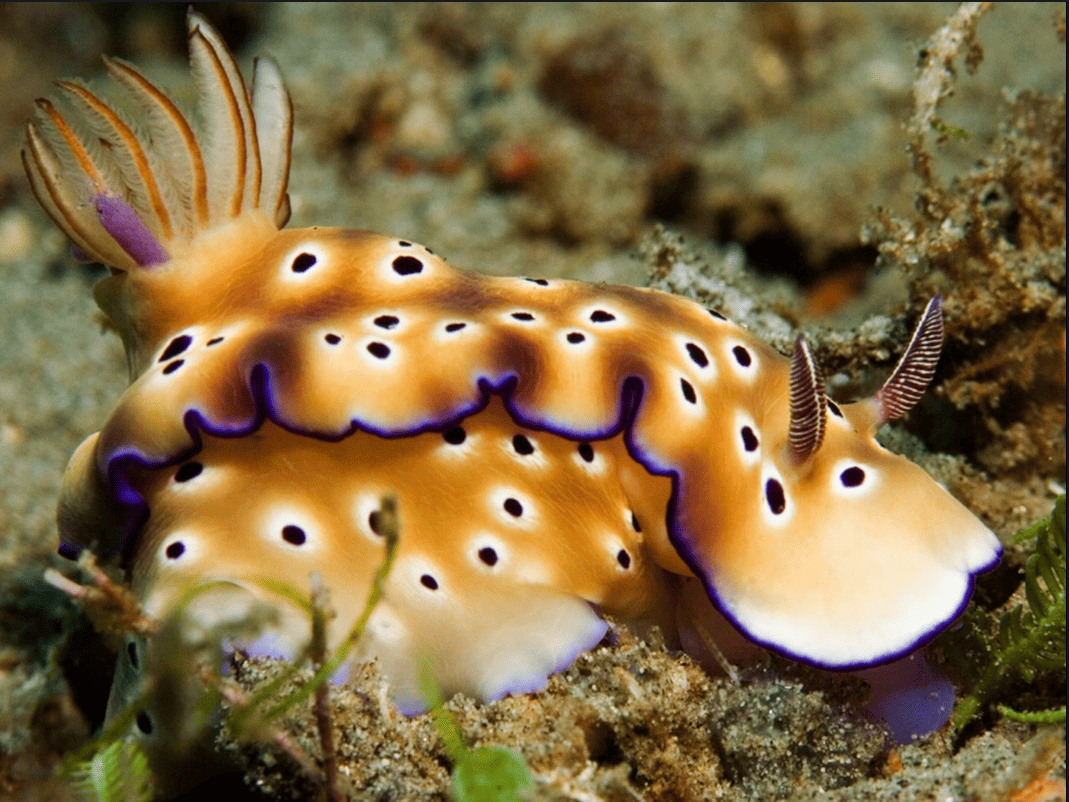 Above, Nudibranch, Philippines. Photograph by Libor Spacek >Nudibranchs, nicknamed "nudis," are best known for the impossible array of colors and designs they sport. They derive coloring, as well as toxicity, from the food they eat. Their wild hues tell potential predators, "You'd best look elsewhere for a meal." 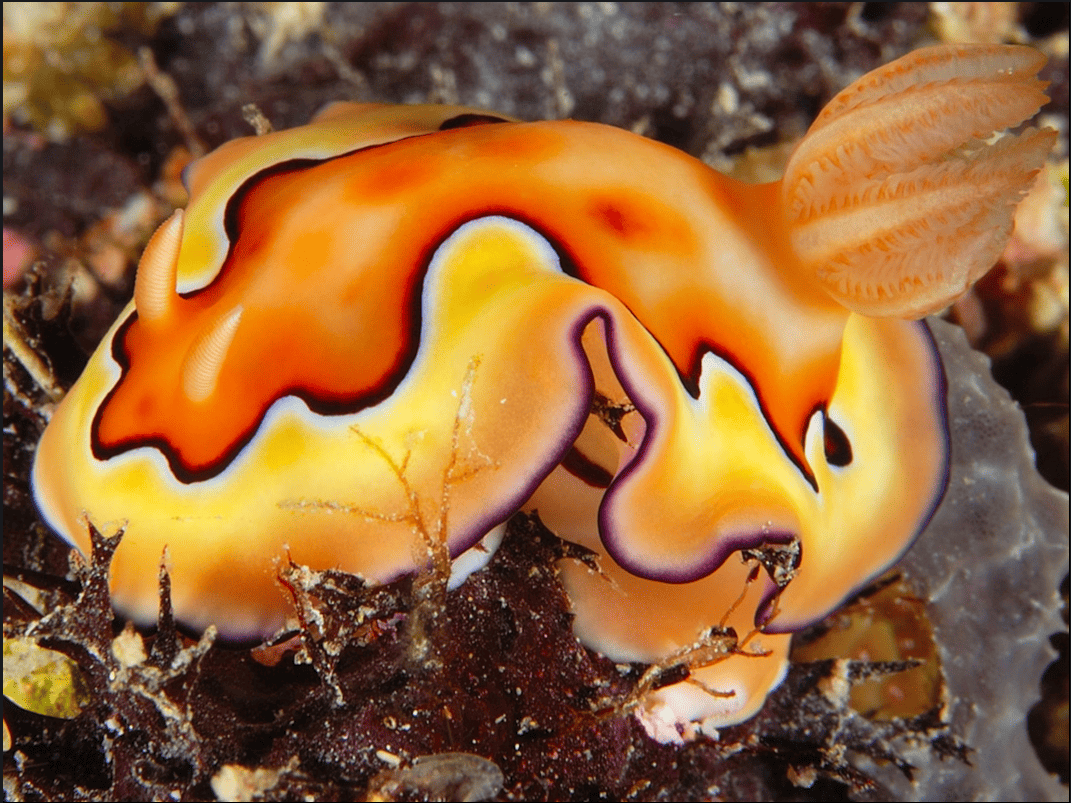 Above, Nudibranch, Palau. Photograph by Ernie Collier >Though partial to tropical climes, nudibranchs thrive throughout the oceans, in warm water and cold, from sandy shallows and reefs to the murky seabed a mile down. Chromodoris nudibranchs, like this one photographed near Palau, are generally a warm-water species. 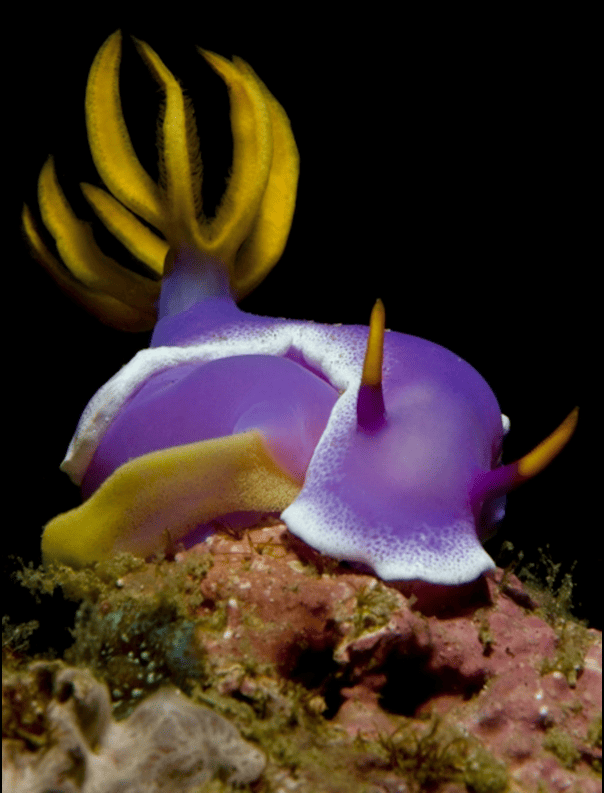 Above, Egg-Laying Nudibranch. Photograph by Jeffrey de Guzman >Nudibranchs are hermaphroditic, carrying both male and female reproductive organs. Mating pairs fertilize one another and lay up to two million eggs in coils, ribbons, or tangled clumps, as this purple-painted Hypselodoris is doing.  Above, Green-and-Orange Nudibranch. Photograph by Jeffrey de Guzman >Nudibranchs are blind to their own beauty, their tiny eyes discerning little more than light and dark. Instead the animals smell, taste, and feel their world using head-mounted sensory appendages called rhinophores and oral tentacles. All text and photos from [National Geographic](https://www.nationalgeographic.com/environment/article/nudibranchs)

Title photo by [David Guillemet](https://www.flickr.com/photos/dguillemet/) I've only just discovered that this exists... Orangutan crab (Achaeus japonicus) >.....it has relatively long arms, which are thickly covered with fine hairs, red or reddish brown in colour, and often laden with small bits of debris for further camouflage.... > >....frequently, but not always, found in association with the bubble coral [wikipedia](https://en.wikipedia.org/wiki/Achaeus_japonicus) 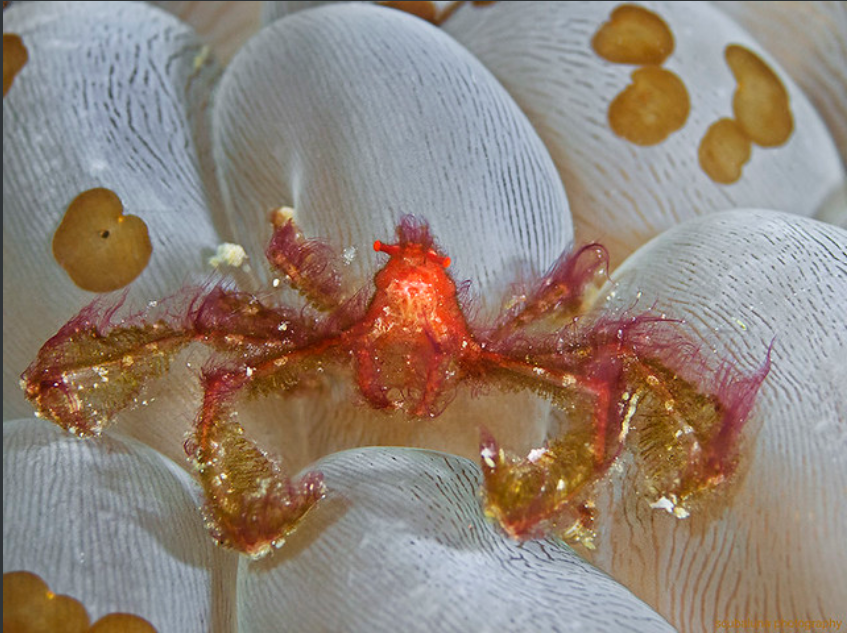 Above photo by [scubaluna](https://www.flickr.com/photos/scubaluna/31076532444/) -They're found in the Indo-Pacific region, have a naturally shaggy pelt, and like to decorate themselves with debris, small plants, sedentary animals, shells and gravel to enhance their natural camouflage! 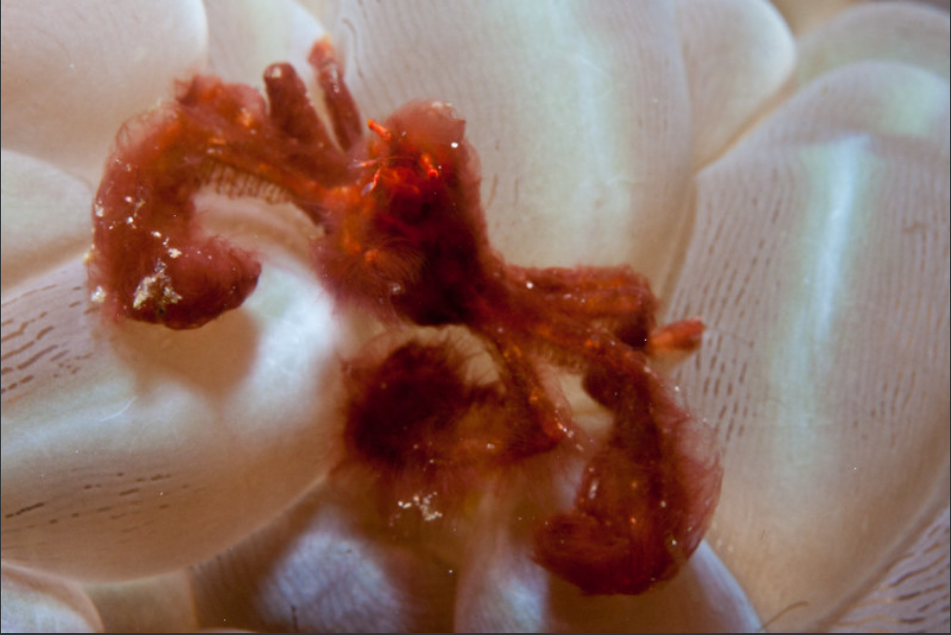 Above photo by [Bruce Versteegh](https://www.flickr.com/photos/bversteegh/5985756457/) -During the day like to hang out in Bubble Coral, which swells its bubble-like structures to maximise its intake of light.... 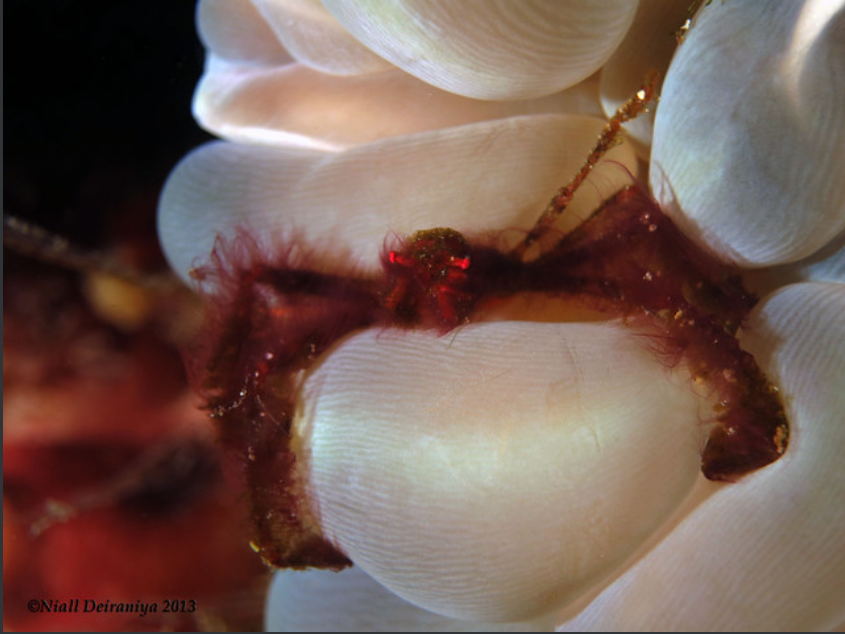 Above photo by [Niall Deiraniya](https://www.flickr.com/photos/48625685@N07/9575026613/) -At night the coral 'deflates' and the Orangutan crab wanders off in search of food 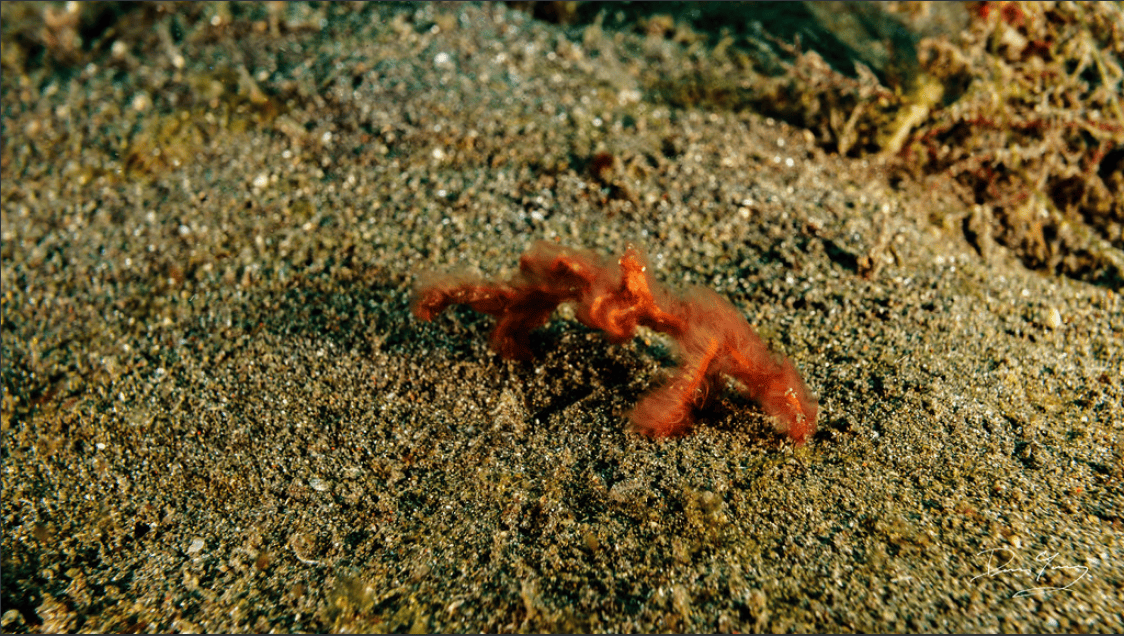 Above photo by [Dennis Young](https://www.flickr.com/photos/dlyoung/53301565931/) The last 2 photos made me piss myself laughing....it looks like a fuzzy little muppet! Info from [wikipedia](https://en.wikipedia.org/wiki/Achaeus_japonicus) and [here](https://www.australiangeographic.com.au/blogs/creatura-blog/2014/05/orangutan-crab-a-decorator-expert/)
 quinacridone
5 months ago
•
100%
quinacridone
5 months ago
•
100%
Reverse cowboy and side saddle
....and on top of fornicating nudis, anything goes under the sea!
 quinacridone
5 months ago
•
100%
quinacridone
5 months ago
•
100%
As it turns out: me! I want to see shrimps riding on Nudibranchs
Yay! There's literally dozens of us!
And you're welcome, it was nice to browse through some quality nudi pics 👍

Title photo Emperor shrimp on glossodoris nudibranch, by [Ludovic](https://www.flickr.com/photos/luko/53446827166/) 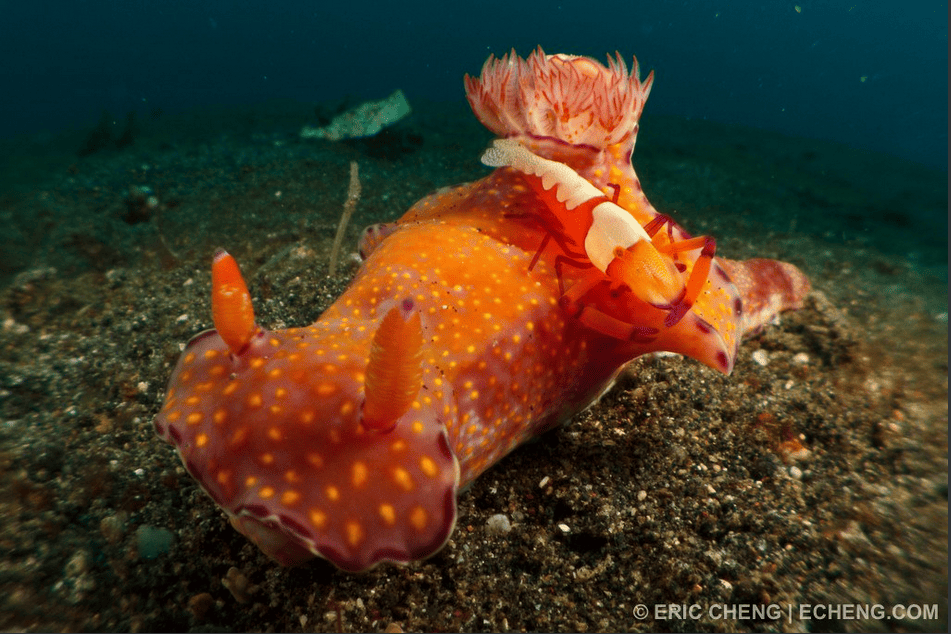 Above photo by [Eric Cheng](https://www.flickr.com/photos/echeng/4408624932/) -The Emperor Shrimp (Periclimenes imperator) is a species of shrimp with a wide distribution across the Indo-Pacific 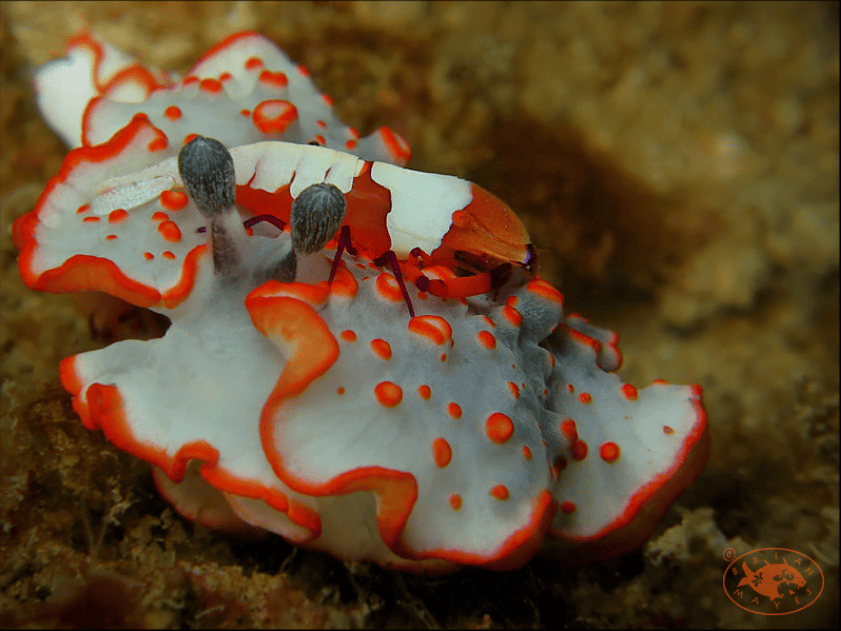 Above, Nudibranch (Dermatobranchus ornatus), with Emperor Shrimp by [Brian Mayes](https://www.flickr.com/photos/brianmayes/15379351399/) -It lives commensally on a number of hosts (this is a long term symbiosis where one species gains benefits, while the other doesn't benefit, but is otherwise unharmed) 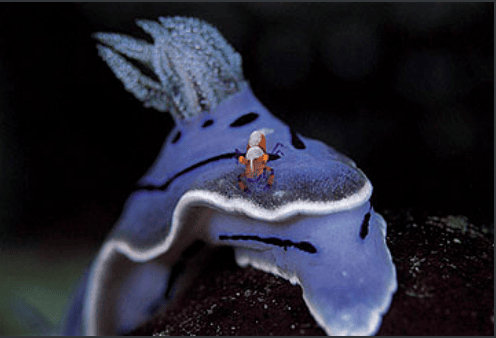 Above photo by [EcoDivers1](https://www.flickr.com/photos/ecodivers/3595611969/in/album-72157619170416177/) -It will hitchhike on slow moving invertebrates including sea cucumbers, starfish (rare), molluscs...and also nudibranchs! 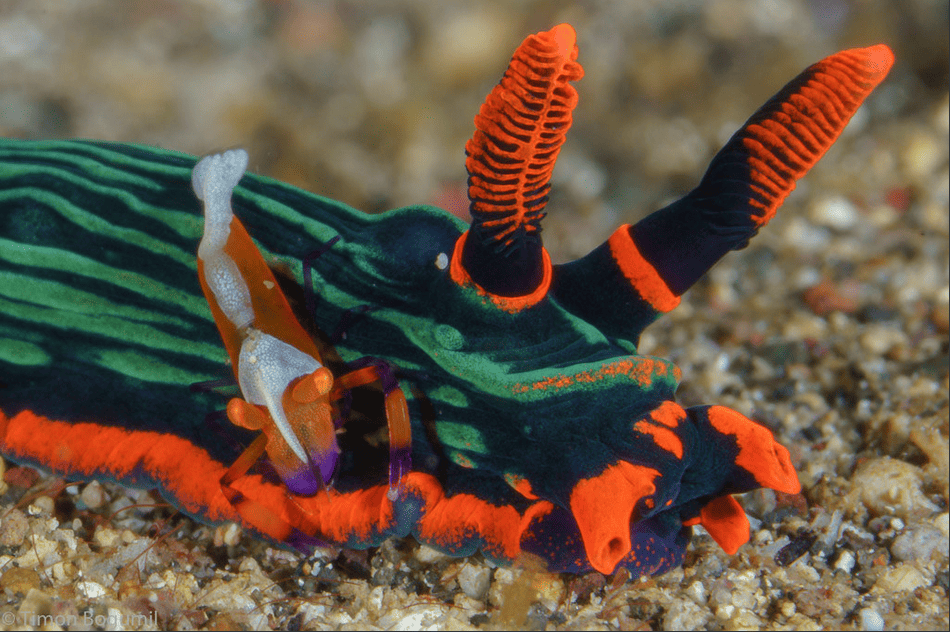 Above, Emperor shrimp on Nembrotha nudibranch by [Roberta Cipressi](https://www.flickr.com/photos/nosytour/36508768861/) -The shrimp is only 19mm, and from it's vantage point it gains access to a stream of nutrients while perched on it's host 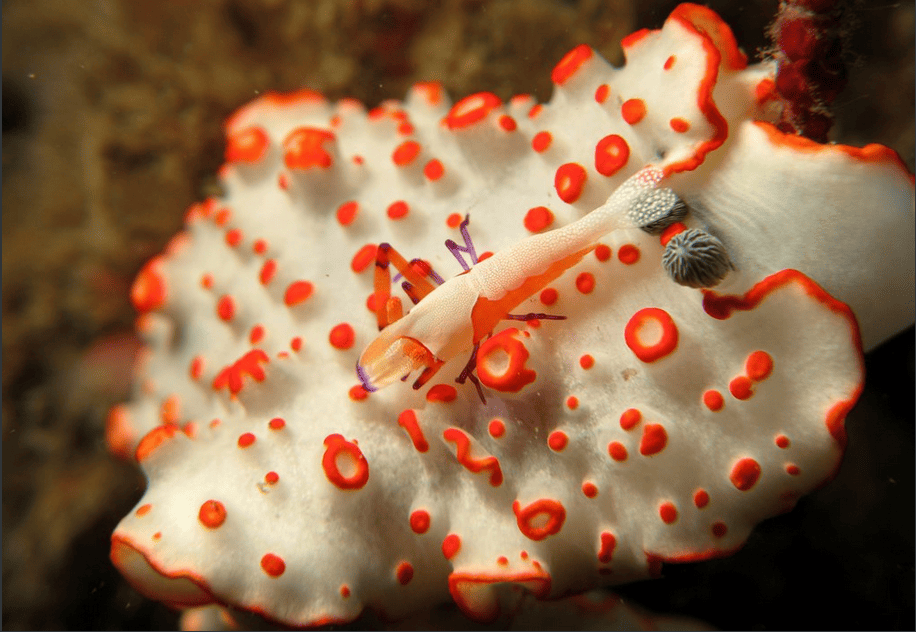 Photo by [Jessie Weng](https://www.flickr.com/photos/samuie/9115649778/) -The shrimps vibrant colours advertise the fact that it is unpalatable and help it camouflage on its host  Above, 'Ceratosoma tenue & Emperor Shrimp' by [Allen Lee](https://www.flickr.com/photos/houpc/14492360874/) 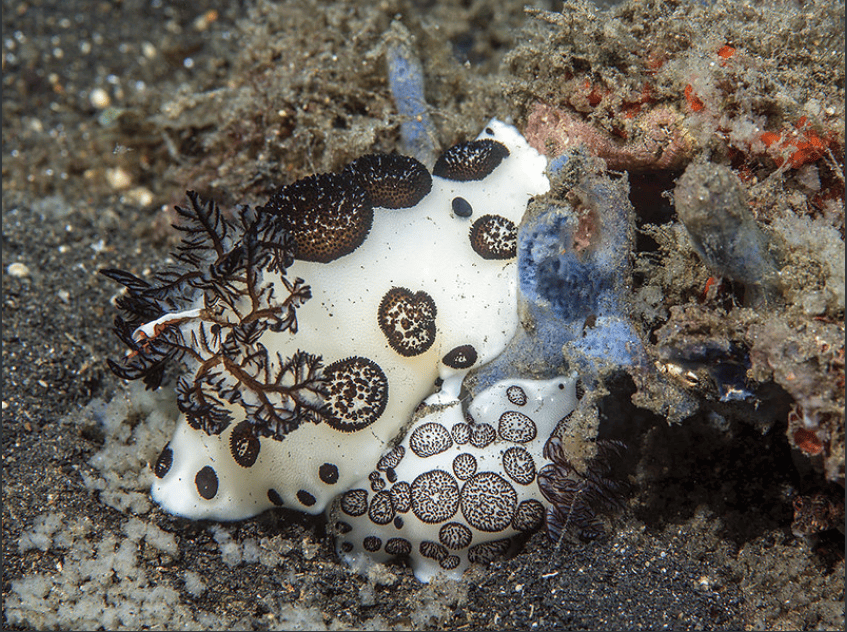 Spot the shrimp.....Above, '(Jorunna funebris), actually two of them copulating. And an Emperor Shrimp...is attached!' photo by [Ülar Tikk](https://www.flickr.com/photos/30583764@N05/39176426330/) -They also help by removing parasites and dead tissue from their host 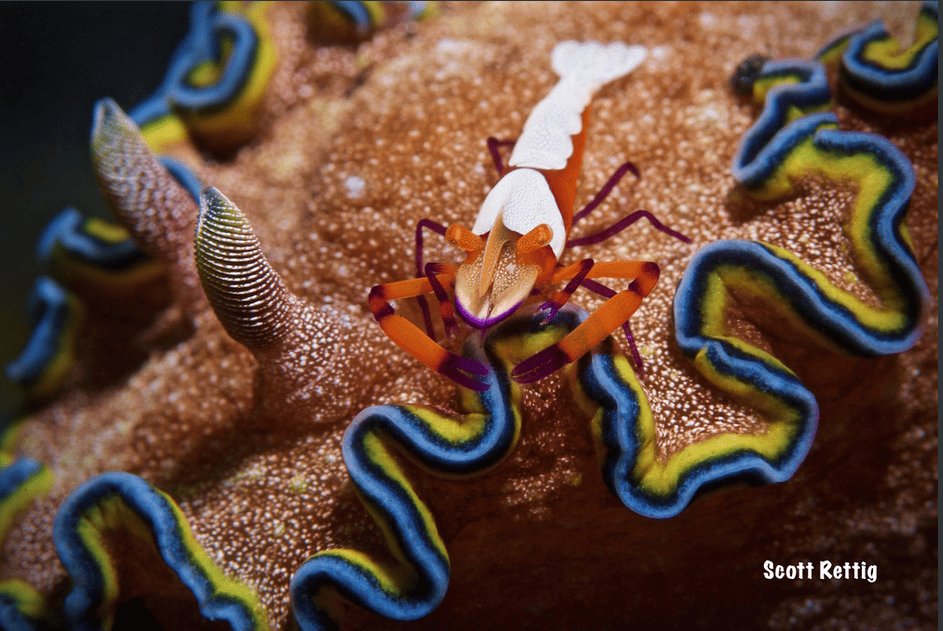 Above, '(Periclimenes imperator) on a Glossodoris cincta Nudibranch' by [Scott Rettig](https://www.flickr.com/photos/29419518@N06/24652107770/) 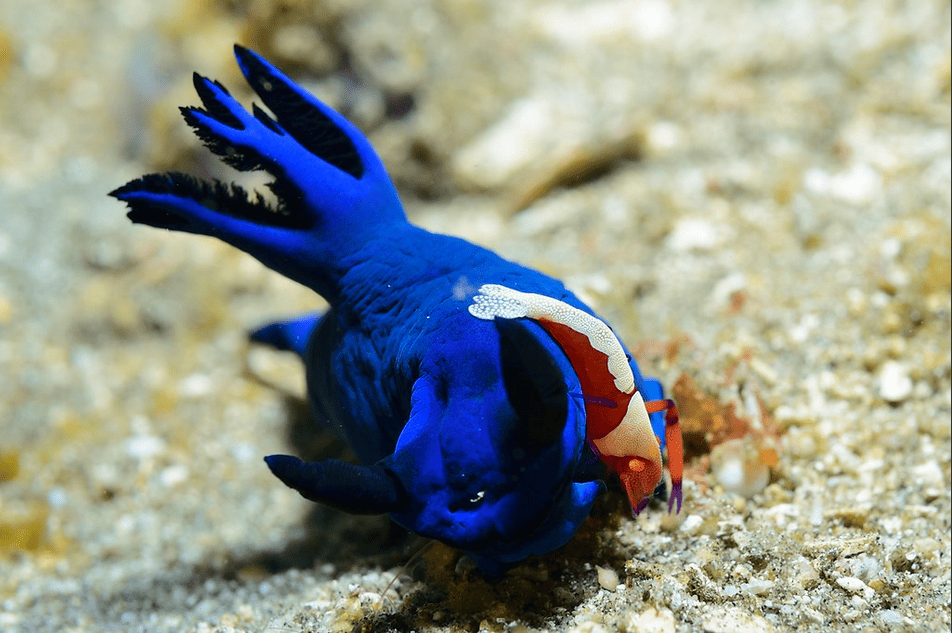 Above, Tambja morosa with Periclimenes imperator by [Benjamin Naden](https://www.flickr.com/photos/ben-naden/10418447045/) -They live approx 2-3 years, and will often change hosts. Having a host is essential for the shrimps survival 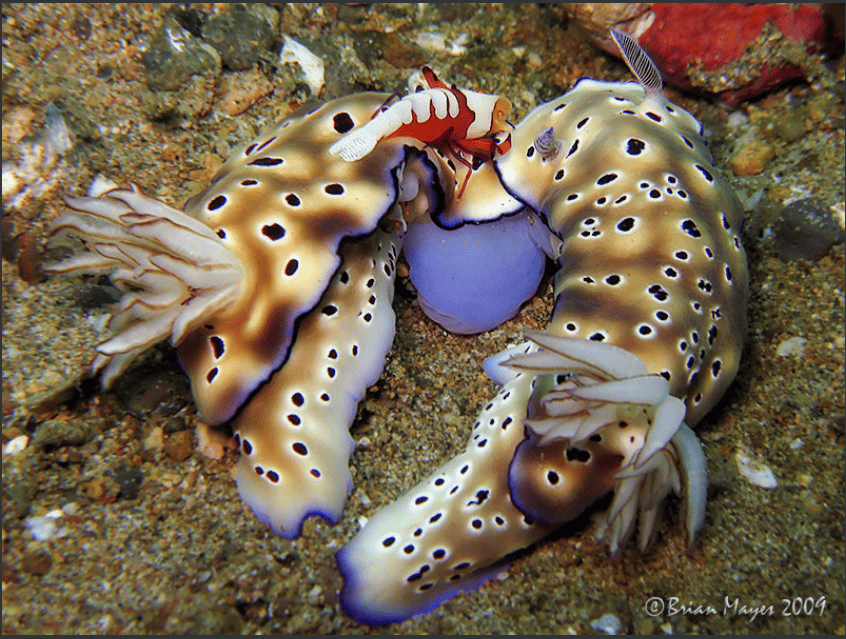 Above photo by [Brian Mayes](https://www.flickr.com/photos/brianmayes/3717564617/) 'I was surprised to see the shrimp change hosts and leave his small companion behind -The shrimps are protandrous hermaphrodites. They are born with male reproductive organs and can change their sex to become female as they age and mature 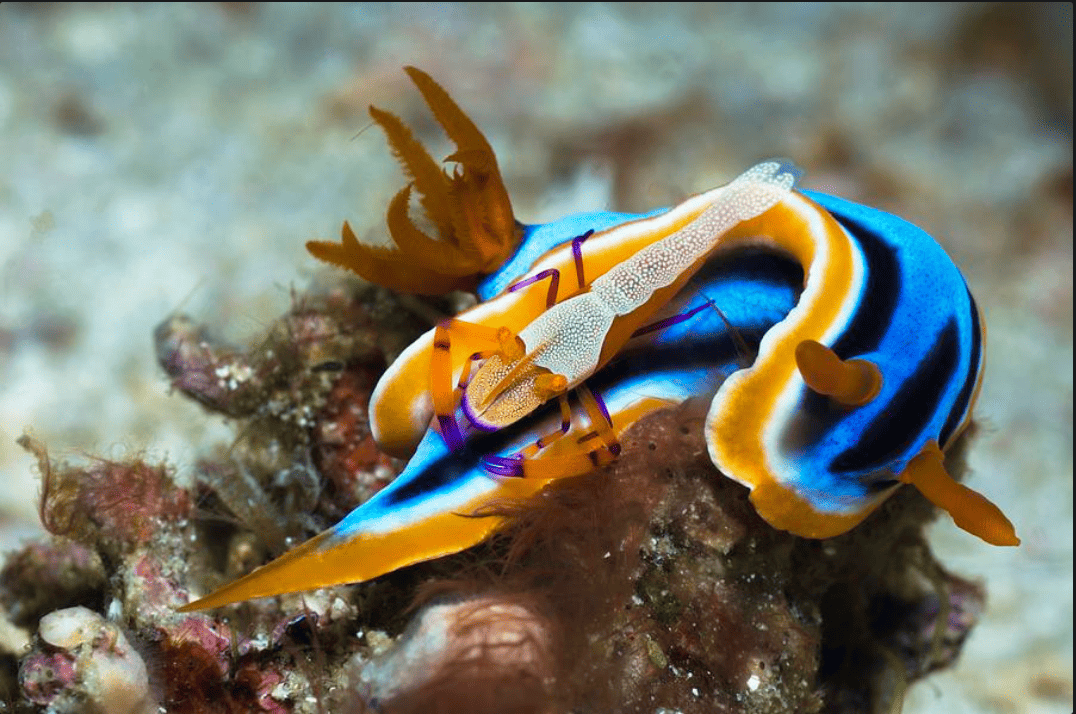 Above photo by [Georgette Douwma](https://fineartamerica.com/featured/nudibranch-and-emperor-shrimp-georgette-douwma.html) -Finding a partner for reproduction can be complex as their dependence on their hosts can impact mating opportunities 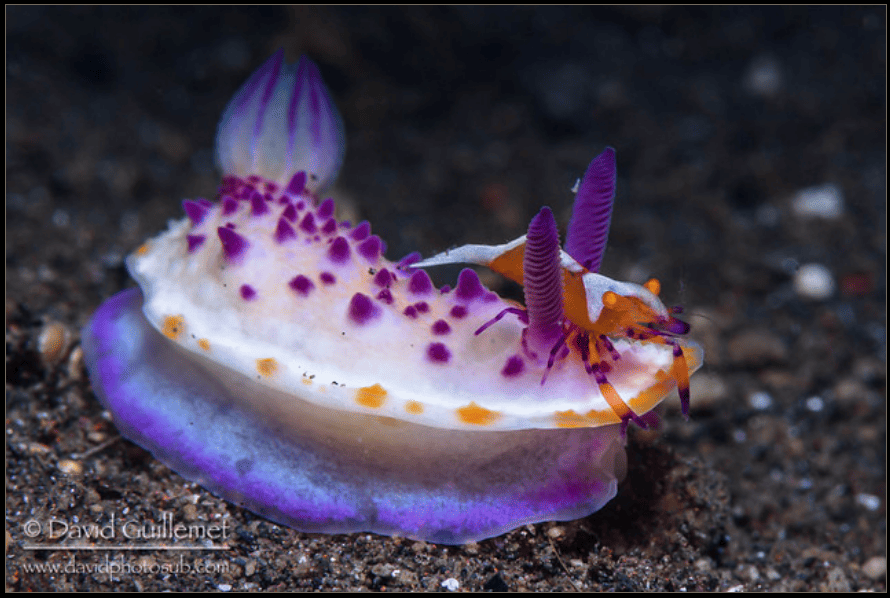 Above, '(Periclimenes imperator) takes a ride on a Bumpy Mexichromis (Mexichromis multituberculata)' by [David Guillemet](https://www.flickriver.com/photos/dguillemet/tags/nudibranch/) -After finding a suitable mate the female shrimp releases her eggs into the oceans current.... 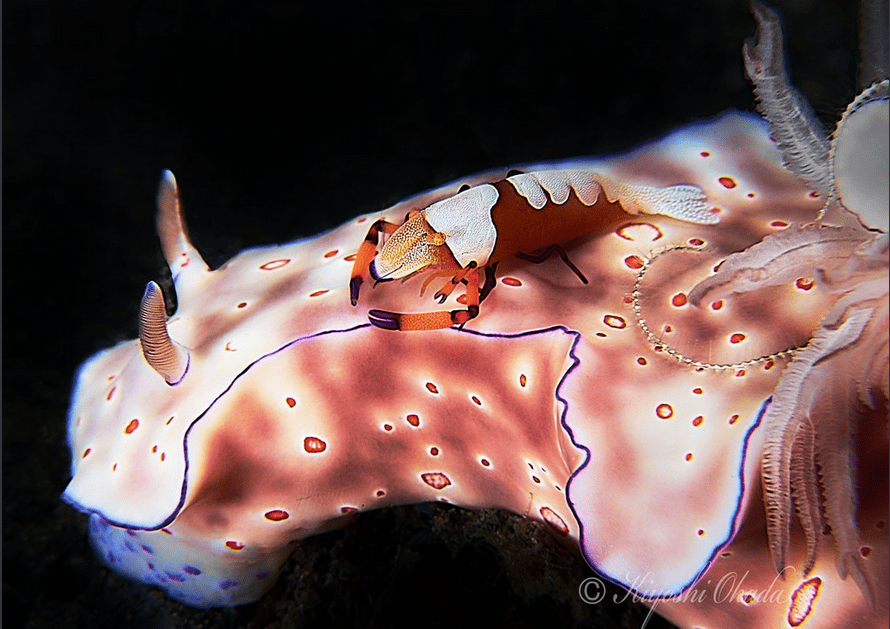 Above, 'Emperor shrimp on ceratosoma nudibranch' by [KIYOSHI OKADA](https://www.flickr.com/photos/124477069@N06/40566781253/) -When the eggs hatch the small larvae will go through several life stages and molts, until eventually finding a companion to ride on.... 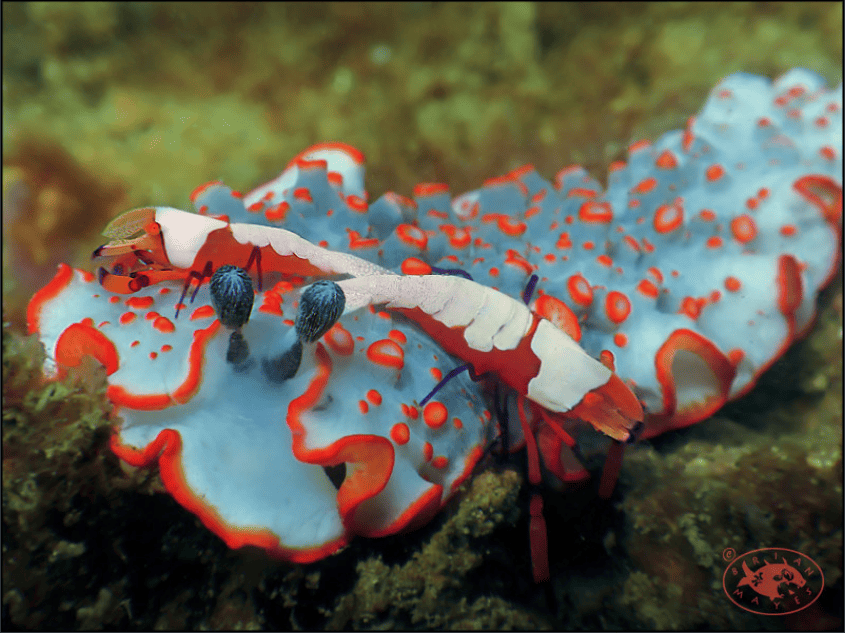 Above photo by [Brian Mayes](https://www.flickr.com/photos/brianmayes/14974314463/) 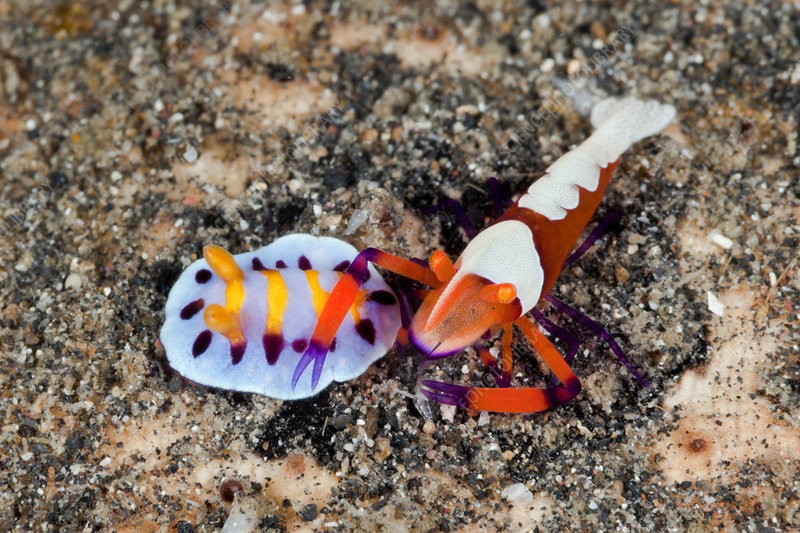 ....reminds me of being sat on the sofa with my dog..... Above photo by [ REINHARD DIRSCHERL](https://www.sciencephoto.com/media/794690/view/emperor-shrimp-with-nudibranch) All info from [wikipedia](https://en.wikipedia.org/wiki/Periclimenes_imperator) and also [here](https://oceanfauna.com/emperor-shrimp-diet-habitat-description-and-fun-facts/) and [here](https://www.biographic.com/the-emperors-throne/) 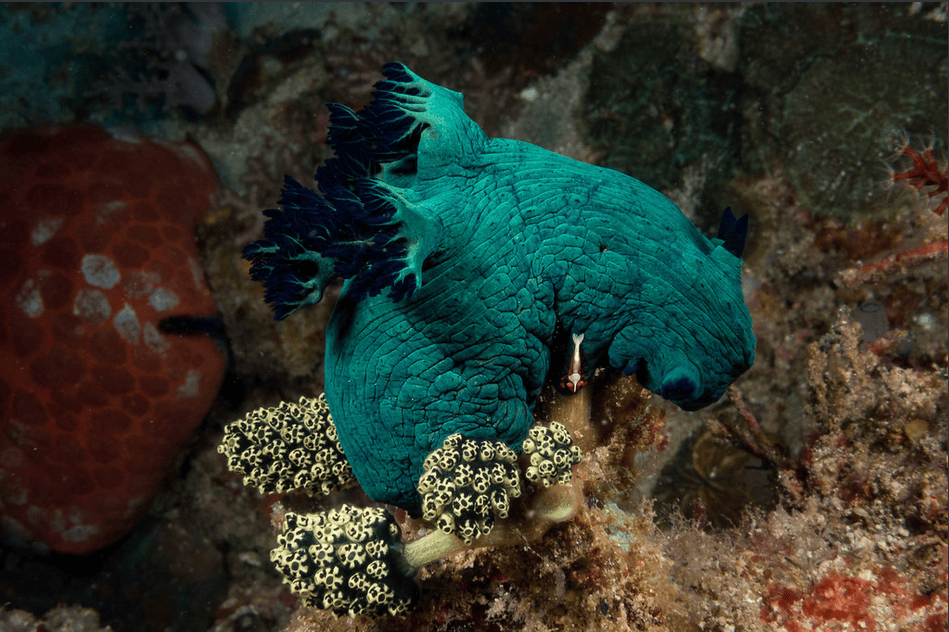 Above, 'Zenopontonia rex with Nembrotha milleri' by [élanarchist](https://www.flickr.com/photos/elanarchist/20832237191/) 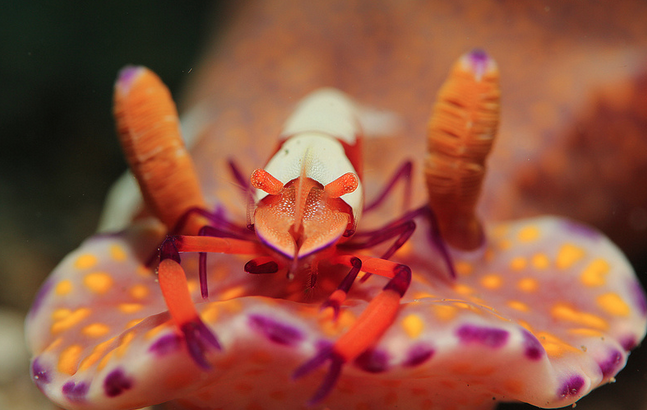 Above, '(Periclimenes imperator) with a Ceratosoma Tenue nudibranch as its commensal host' by [Jun V Lao](https://en.wikipedia.org/wiki/File:Emperor_Shrimp_(Periclimenes_imperator).png#filelinks) I'm not an expert, if there are any mistakes let me know in the comments and I'll edit my post!

Title photo by [Dotted Yeti](https://a-z-animals.com/animals/anomalocaris/pictures/) >Travel back in time to the Cambrian Era, a period famous for the diversity of its life forms! > >Lasting approximately 53.4 million years from the end of the preceding Ediacaran period 538.8 million years ago (mya) to the beginning of the Ordovician period 485.4 mya. It is a period where the atmosphere had elevated concentrations of oxygen, and the global temperature increased-creating a temperate world > >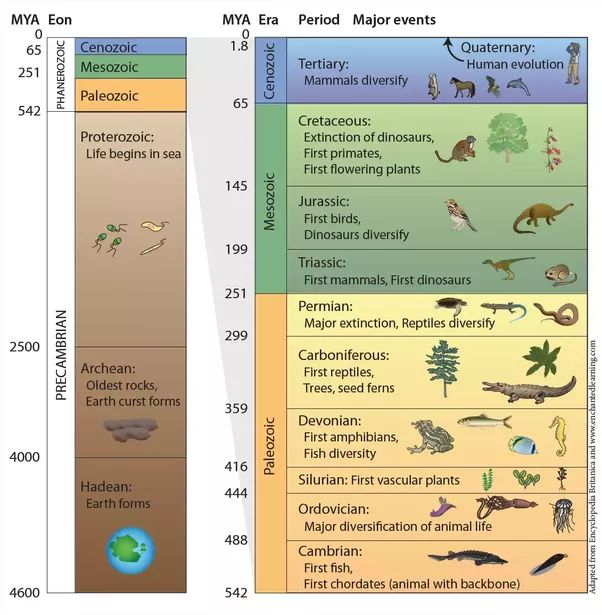 > >Geological timescale from [here](https://www.sutori.com/en/story/geologic-time-scale--gaP3hEy5bkbZhpxTgfZSgREZ) > >Scientists believe that the higher oxygen levels, and warmer climate contributed to the incredible diversity of life that occurred in the oceans. > >However, on land it was mostly barren...complex lifeforms were non-existent and would have been restricted to mollusks and arthropods emerging from the water to feed on microbes in slimy biofilms > >The Cambrian is unique as it had unusually high deposits of Lagerstätte sedimentary deposits, these sites offer exceptional preservation of 'soft' organism parts, as well as their harder shells which means that the study and understanding of the fossilized life forms surpasses some of later periods (above, from my previous post on [Aysheaia](https://lemmy.ml/post/13725497)) Anomalocaris means 'unlike other shrimp' or 'abnormal shrimp' and is an extinct Cambrian arthropod belonging to the radiodonts (meaning, radius 'spoke of a wheel' and odoús 'tooth') and is thought to have been one of the top predators for it's time The fossils that were discovered in The Burgess Shale in 1886 were of incomplete segments and were initially thought to be 3 separate individual species. The frontal appendages were thought to be the bodies of shrimp-like crustaceans. 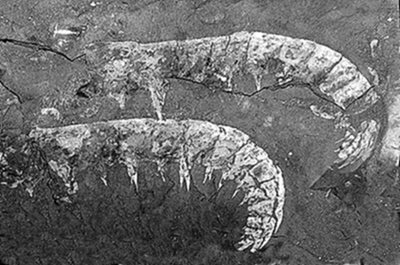 Above, 'named [Anomalocaris](https://www.trilobites.info/gallery.html) ("strange shrimp") by Walcott' The circular mouth part was thought to be a jellyfish as it showed the same radial symmetry 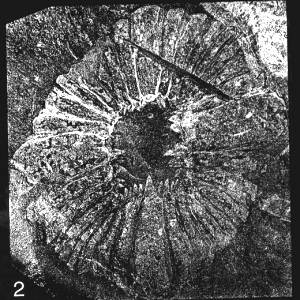 Above, 'circular fossil from the Burgess Shale formation was described and named [Peytoia](https://www.trilobites.info/gallery.html)' In 1966 a comprehensive revision of the Burgess Shale fossils began, along with additional misinterpretations which proposed that the feeding appendages were legs, and the mouth parts were part of a sponge... However, during the cleaning of one of the fossils a layer of stone was removed which linked the feeding appendages and the mouth parts as belonging to the same animal. Later specimens showed how the feeding appendages could be curled around prey and directed to the circular mouth part, as well as eyes on flexible stalks....It had taken over 100 years of misinterpretations to finally meet Anomalocaris 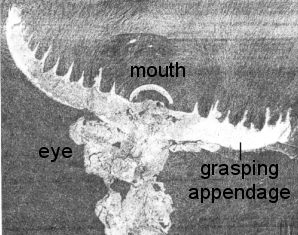 Above, previously thought as the 'body of a shrimp was one of a pair of spiny grasping arms..the rim of the mouth shows partially, as does one of the large eyes' [source](https://www.trilobites.info/gallery.html) 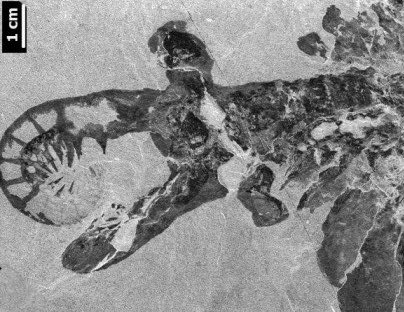 Above, 'appendages could curl, enfolding around prey, which was pinned by the arm spines. The captured prey was then placed into the mouth, which was under the head between the eyes. The eyes were at the ends of flexible stalks.' [source](https://www.trilobites.info/gallery.html) In 2021 the compound eyes made up of 16,000 lenses were discovered, proving that Anomalocaris was definitely an arthropod, and indicating that complex eyes has evolved before jointed legs or exoskeletons  Above photo by [John Paterson](https://www.nature.com/articles/nature.2011.9586), 'One of the stalked eyes of Anomalocaris from South Australia with arrows pointing to the boundary between the stalk and visual surface, plus the intricate lenses preserved' The Anomalocaris would have been huge for the Cambrian maybe up to 1 metre in length. It would have been able to swim through the water by undulating the flexible flaps on the sides of it's body chasing down prey. The compound eyes would have given it a 'high degree of visual acuity, and a well-developed brain to process that information' [source](https://www.nature.com/articles/nature.2011.9586)  Above, Anomalocaris size via [wikipedia](https://commons.wikimedia.org/wiki/File:Anomalocaris_canadensis_size_comparison.png) It's unusual mouth parts made of wrinkled structures and sharp teeth, plus grasping appendages would have been ideal to catch and eat soft bodied animals like worms or comb jellies  Above, Radiodonta oral cones [wikipedia](https://commons.wikimedia.org/wiki/File:20210520_Radiodonta_oral_cone.png)........looking rather like an anus with teeth, imo  Above image by [Junnn11](https://commons.wikimedia.org/wiki/Category:Anomalocaris_life_restorations#/media/File:2014_Anomalocaris_canadesis.png) Anomalocaris fossils have been discovered in Canada (Burgess Shale), Australia (Emu Bay Shale), China and the US and include species -A. canadensis Whiteaves, 1892 =A. whiteavesi Walcott, 1908 =A. gigantea Walcott, 1912 =A. cranbrookensis Resser, 1929 -A. daleyae Paterson, García-Bellidob & Edgecombe, 2023 [wikipedia](https://en.wikipedia.org/wiki/Anomalocaris#cite_note-Wu_2021-3) Plus 8 other species including - Anomalocaris saron, from the Chengjiang lagerstatten in China [source](https://www.trilobites.info/species.html) 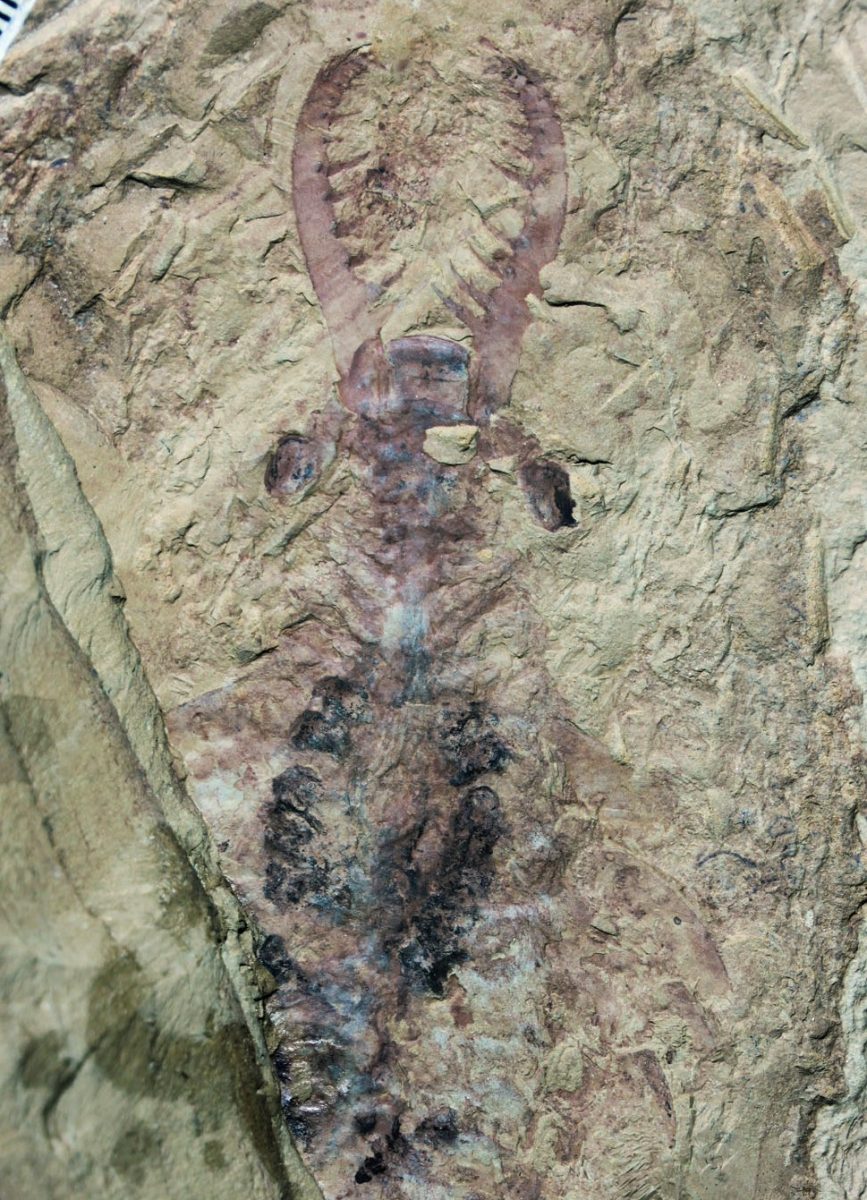 Above, [Anomalocaris saron, a Radiodonta from the Chengjiang Biota, China](https://wp.unil.ch/paleo/page-exemple/exceptional-preservation/) The Anomalocaris died off towards the end of the Cambrian, during the Great Permian Extiction along with up to 90% of all other life forms  Above image by [Dotted Yeti](https://a-z-animals.com/animals/anomalocaris/pictures/) All info from [wikipedia](https://en.wikipedia.org/wiki/Anomalocaris#cite_note-Wu_2021-3), and also [here](https://www.trilobites.info/background.html), [here](https://www.nationalgeographic.com/premium/article/was-this-prehistoric-killer-shrimp-as-fierce-as-it-looked) and [here](https://a-z-animals.com/animals/anomalocaris/) As always, I am not an expert, I just enjoy learning and sharing interesting things....Any mistakes- leave a comment and I'll edit my post
 quinacridone
5 months ago
•
100%
quinacridone
5 months ago
•
100%
[they] use the chloroplasts of the algae on which they feed, which they keep alive for hours to months after their ingestion...
Sacoglossans have been known to survive for months living solely on the photosynthetic products of their acquired plastids
Sacoglossans are able to choose which method of feeding they use. The switch from active feeding to photosynthesis in sacoglossans is triggered by the shortage of food resources, and typically not preferred
starvation periods (with photosynthesis and no active feeding) vary between species of sacoglossans from less than a week to over four months, and photosynthesis is used as a last-resort mechanism to avoid mortality
All from wikipedias page on sacoglassa...the whole process is fascinating and worthy of a post in itself, probably one for next week 👍
 quinacridone
5 months ago
•
100%
quinacridone
5 months ago
•
100%
Yep, it's probably why they were only discovered (relatively) recently and good photos are hard to find, unlike their bigger relations....Having said that I didn't realise they'd be that tiny!
 quinacridone
5 months ago
•
100%
quinacridone
5 months ago
•
100%
Cockchafer is a totally safe google, I don't know how it would show without 'safe' or 'moderate' though
Cockchafer.....

 quinacridone
5 months ago
•
100%
quinacridone
5 months ago
•
100%
They are excellent for that!
 quinacridone
5 months ago
•
100%
quinacridone
5 months ago
•
100%

This large, brown beetle can be seen swarming around streetlights in spring. They live underground as larvae for years and emerge as adults often in large numbers. Listen for their characteristic buzzing sound......
....nothing remotely rude, just the British way of naming things, like 'cunt gropers lane' 'cockermouth' 'wet wang' etc
 quinacridone
5 months ago
•
100%
quinacridone
5 months ago
•
100%
Some more photos.....
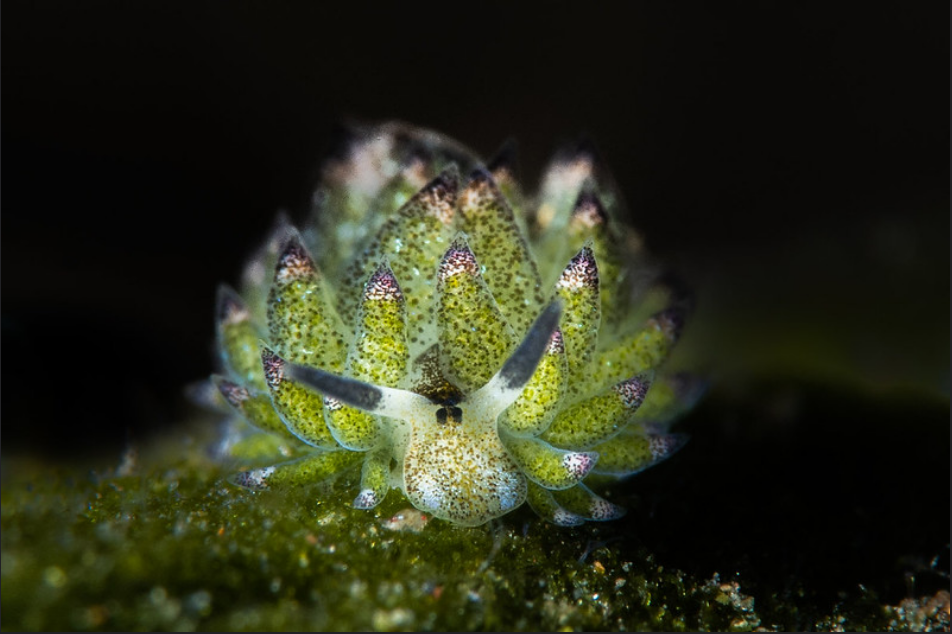
Costasiella kuroshimae by Michaels Bubbles
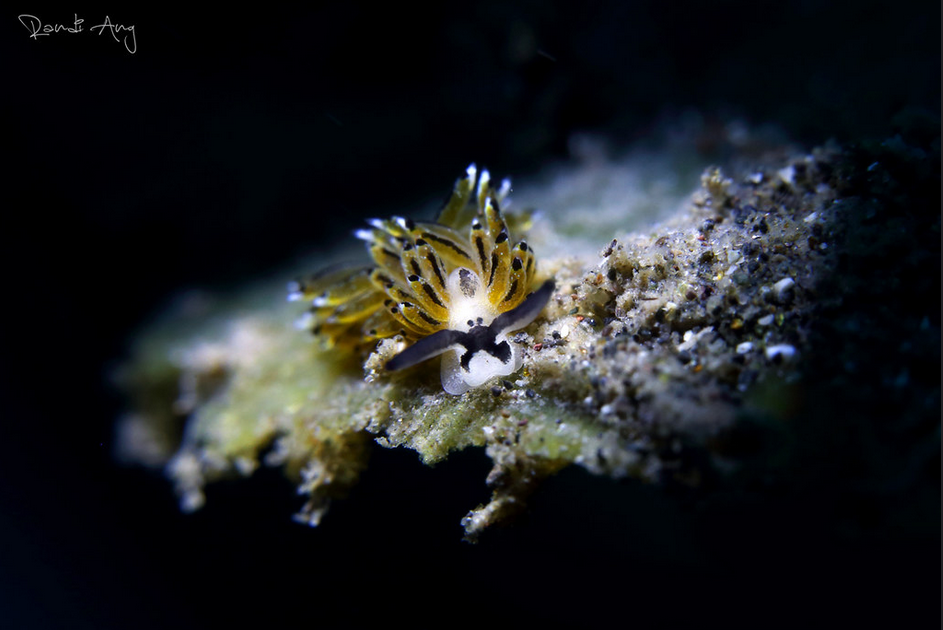
Costasiella sp.4 photo by Randi Ang
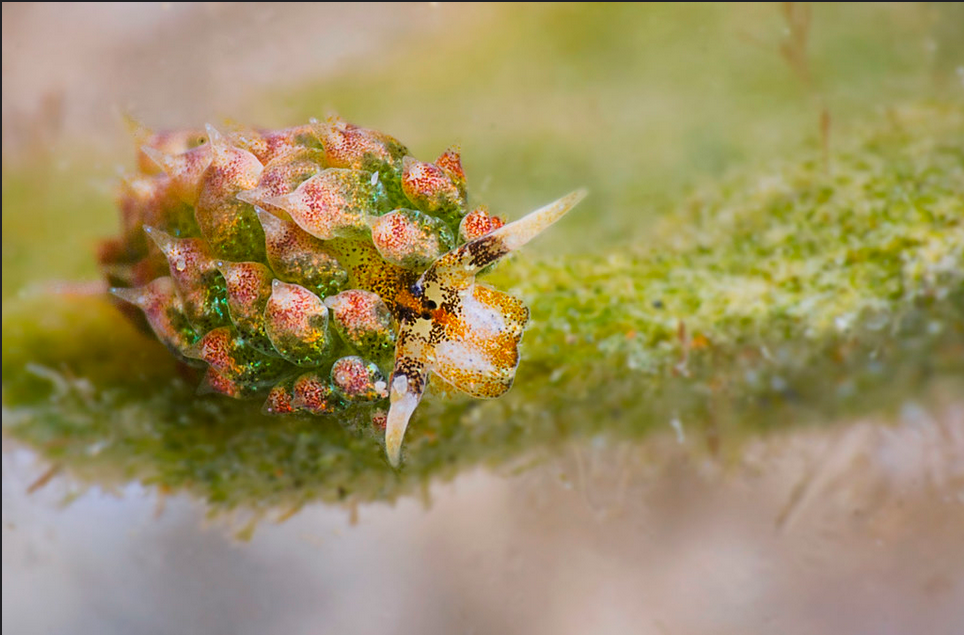
Costasiella sp. by Thomas Vignaud
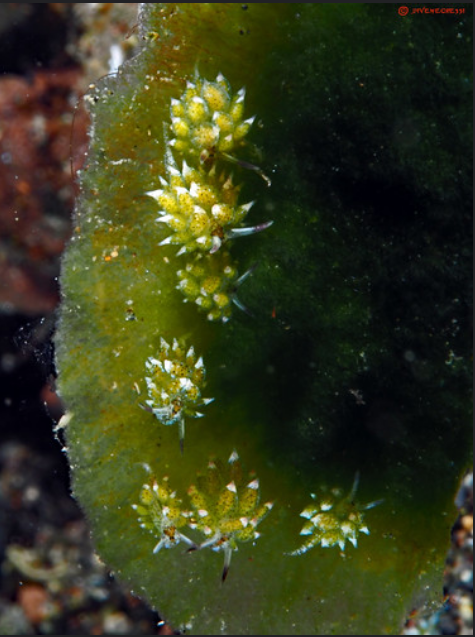
Group of Costasiella kuroshimae by divemecressi

Title photo sp. 7 by [Ludovic](https://www.flickr.com/photos/luko/36612192483/) Costasiella is a genus of sacoglossan sea slugs Sacoglossons are 'solar powered sea slugs' aka 'sap sucking sea slugs' which live by ingesting the cellular content of algae. Some will just digest this fluid, others will store the living chloroplasts in their own tissues, which continue to photosynthesize benefiting the sea slug! 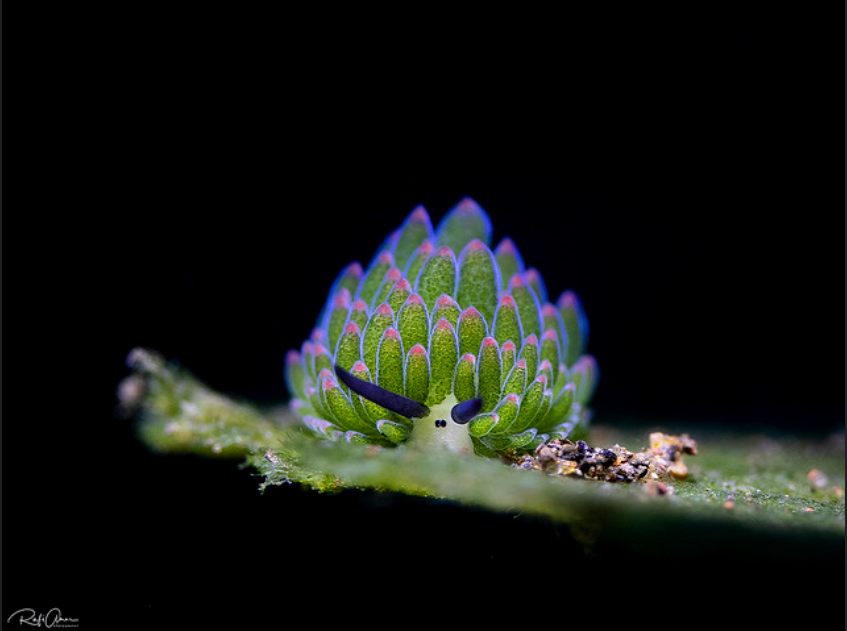 Above photo C. kuroshimae by [Michaels Bubbles](https://www.flickr.com/photos/eldiablo82/52938548924/) There are currently 17 different species in the genus, and they are *tiny* some are only 2mm! The largest can be up to 13mm! 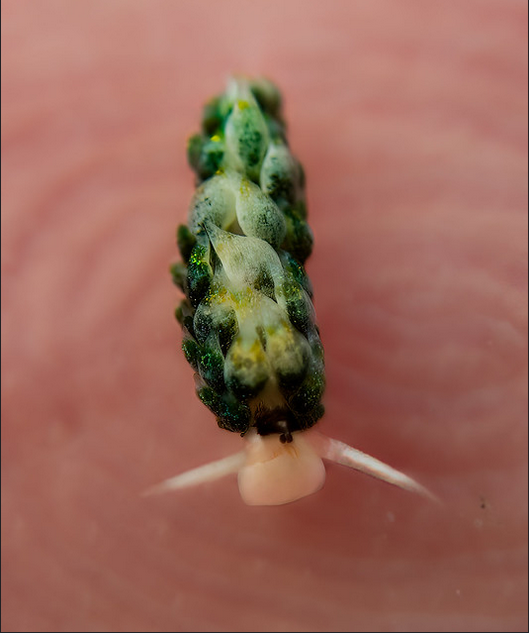 Above photo sp. 2 by [Jean-Marie GRADOT](https://www.flickr.com/photos/129108168@N08/52660709400/) Costasiella kuroshimae was discovered off the coast of the Japanese Island of Kuroshima, and later also found in the sea off Japan, The Philippines and Indonesia. They have 2 dark coloured eyes, and 2 rhinophores (club shaped structures) that look like sheep ears, these have given them the name of 'leaf sheep'  Above, C. kuroshimae by [Anilao~Critters](https://www.flickr.com/photos/74171608@N04/16420150506/) From the limited information that I could find, C. kuroshimae itself has 7 different types (numbered as sp 1-7) and within each sp there are subtle variations 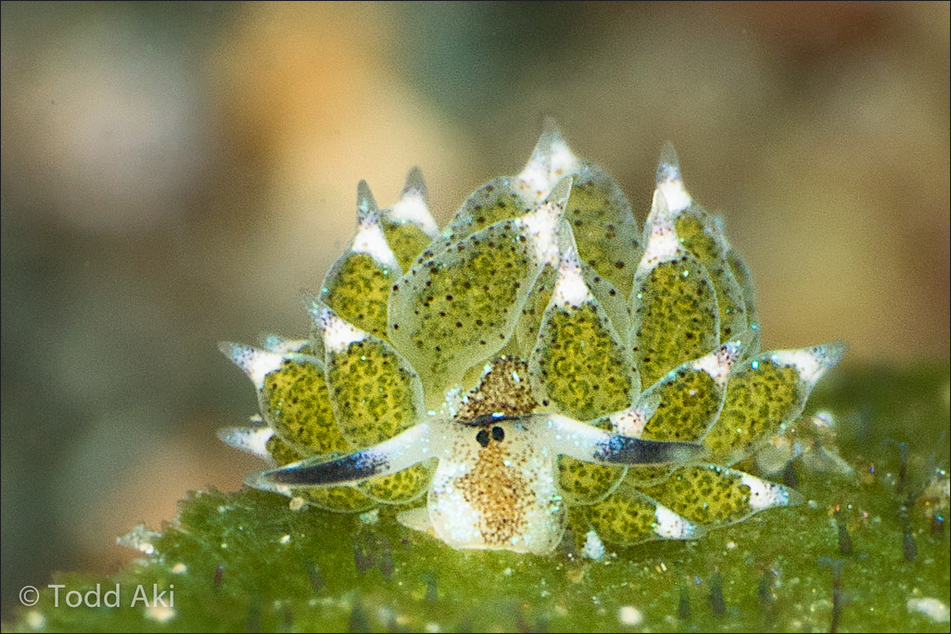 Above, C. kuroshimae by [Todd Aki](https://www.flickr.com/photos/90966819@N00/25142637364/) 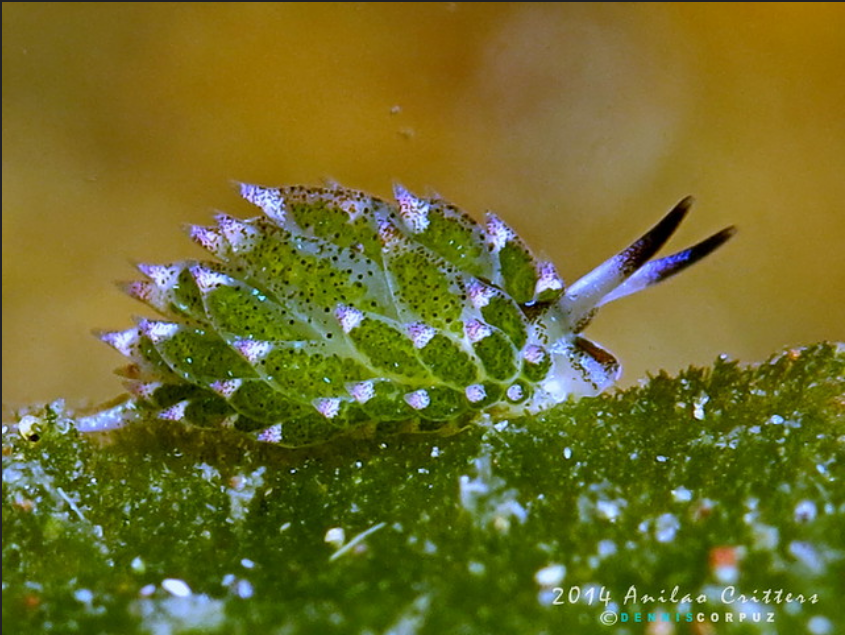 Above photo sp. 5 by [Anilao~Critters](https://www.flickr.com/photos/74171608@N04/16458606151/) 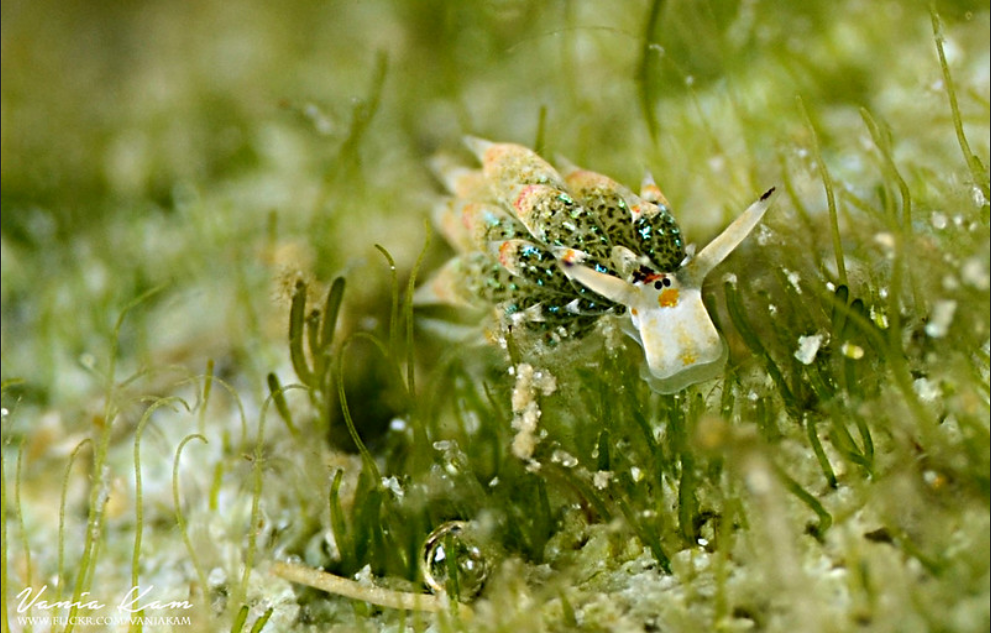 Above, C. kuroshimae by [Vania Kam](https://www.flickr.com/photos/vaniakam/16358579522/) 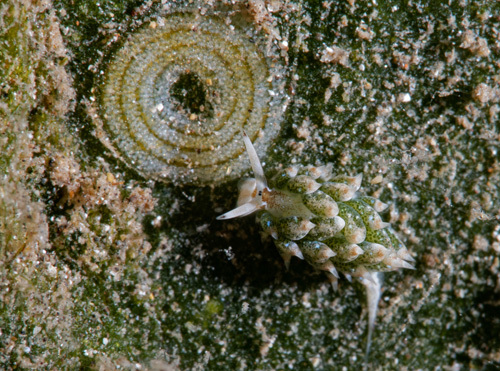 Above photo of C. kuroshimae with spiral shaped egg mass, by [Kelly McCaffrey](http://seaslugsofhawaii.com/species/Costasiella-kuroshimae-j.html)  Above 'family tree' of Costasiella, with the different types of C. kuroshimae sp 1-7 [source](https://academic.oup.com/mollus/article/80/5/562/2883217) Other species of Costasiella include C. Usagi.... 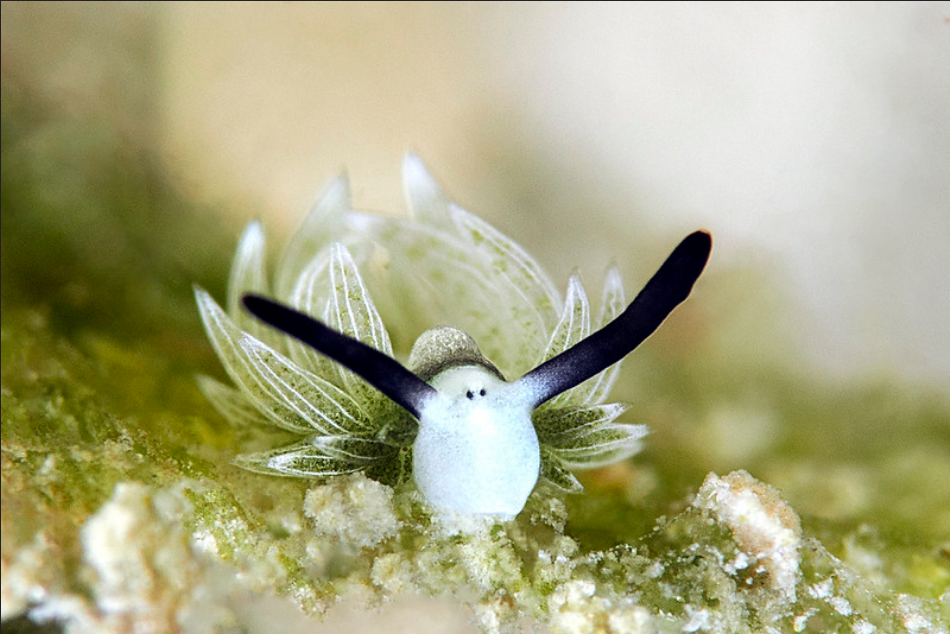 Above, photo by [Allen Lee](https://www.flickr.com/photos/houpc/34796224763/) 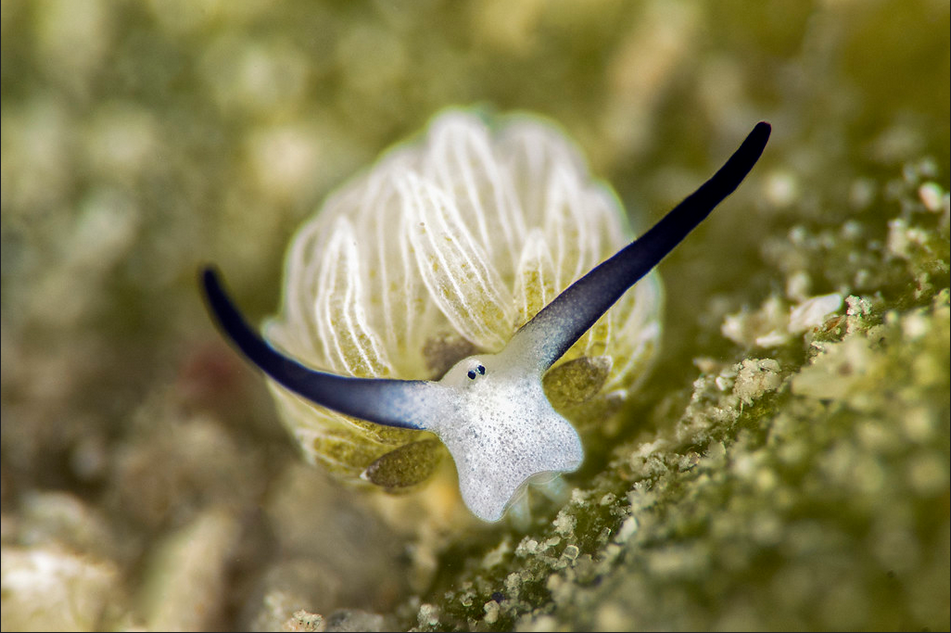 Above, photo by [Allen Lee](https://www.flickr.com/photos/houpc/35930169796/) Others within the genus... 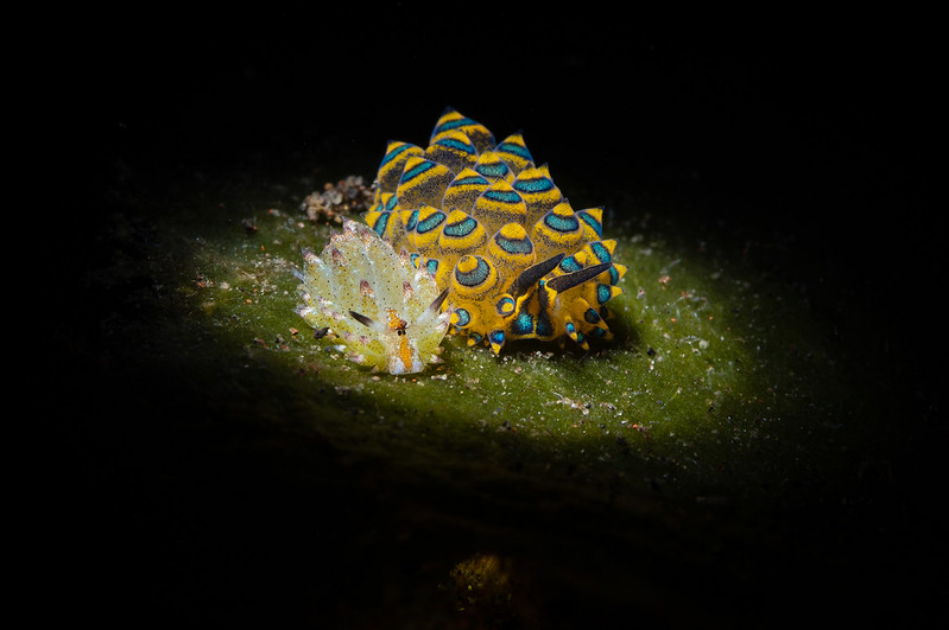 Above, photo by [Ludovic](https://www.flickr.com/photos/luko/52891909624/) 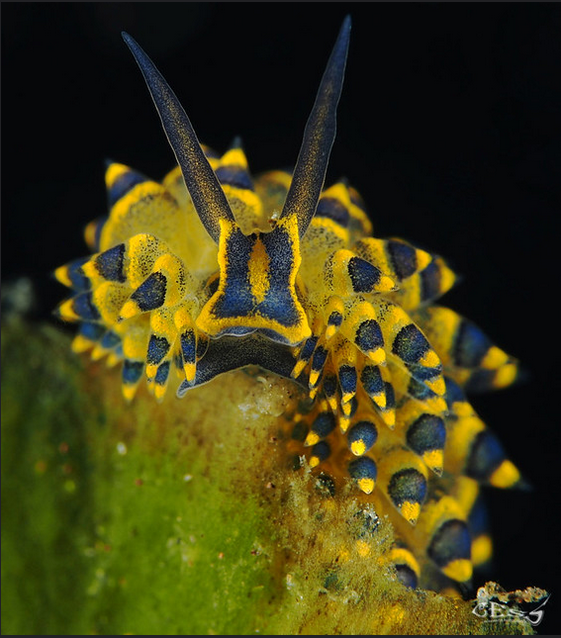 Above, photo by [Patrick Ess](https://www.flickr.com/photos/pdess/53591333000/) And finally, some more photos of the Leaf Sheep (C. kuroshimae).... 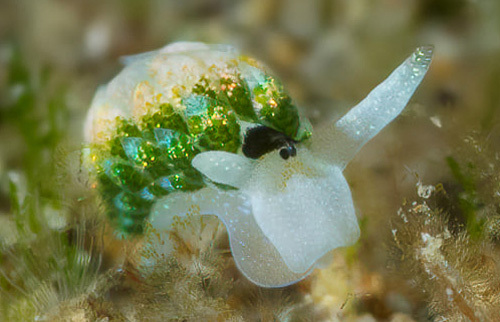 Above, Costasiella sp. #1 photo by [Jenna Szerlag](http://seaslugsofhawaii.com/species/Costasiella-sp1-h.html) .......weeeeeeeeeeeeeee!! 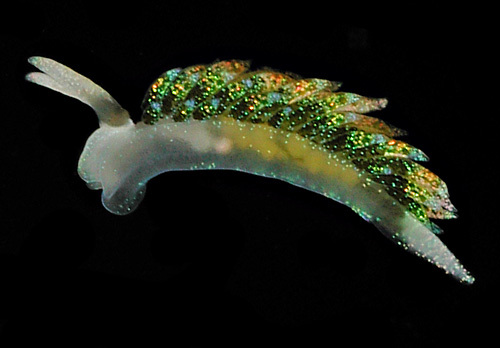 Above, Costasiella sp. #1 photo by [unknown](http://seaslugsofhawaii.com/species/Costasiella-sp1-e.html) Information via wikipedia- [Costasiella](https://en.wikipedia.org/wiki/Costasiella) and [C. kuroshimae](https://en.wikipedia.org/wiki/Costasiella_kuroshimae), also from [here](https://academic.oup.com/mollus/article/80/5/562/2883217#57287292) and [here](http://seaslugsofhawaii.com/general/limapontiidae.html) Apologies folks, if this post is a bit patchy and garbled, there really isn't a lot of information about these nudibranchs...but I thought the photos were really nice!
 quinacridone
5 months ago
•
100%
quinacridone
5 months ago
•
100%
Whoops! You're right, I'll edit it 👍
I like ball armadillo! I was quite amazed by the amount of different names they have when I was reading up
 quinacridone
5 months ago
•
100%
quinacridone
5 months ago
•
100%
Not edible crustaceans though, apparently they taste like urine, probably due to the fact that they release ammonia...One of their local names I heard in Wales is 'piss the bed' Also...
In the Netherlands, they’re called pissabeds source
But, despite all the piss they're great little critters 😀

Title photo by [Distinctly Average](https://www.flickr.com/photos/distinctly_average/48180252101/) Woodlice are crustaceans, and get their name from being found in wood, and 'louse' (a parasitic insect) however, they are neither insects or parasites! There are over 3500 species of woodlouse, and are found throughout the world except Antarctica  Above photo by [Nico Ardans](https://www.flickr.com/photos/nicoardans/1087627760/) Their ubiquity has resulted in many (up to 250) different local names for them including... - Boat-builder (Newfoundland, Canada) - Butcher boy or butchy boy (Australia, mostly around Melbourne) - Carpenter or cafner (Newfoundland and Labrador, Canada) - Cheeselog (Reading, England) - Cheesy bobs (Guildford, England) - Cheesy bug (North West Kent, Gravesend, England) - Chiggy pig (Devon, England) - Chisel pig - Chucky pig (Devon, Gloucestershire, Herefordshire, England) - Doodlebug (also used for the larva of an antlion and for the cockchafer) - Gramersow (Cornwall, United Kingdom) - Hog-louse - Millipedus - Mochyn coed ('tree pig'), pryf lludw ('ash bug'), granny grey in Wales - Pill bug (usually applied only to the genus Armadillidium) - Potato bug - Roll up bug - Roly-poly - Slater (Scotland, Ulster, New Zealand and Australia) - Sow bug - Woodbunter - Wood bug (British Columbia, Canada) - Wood pig (mochyn coed, Welsh) [source](https://en.wikipedia.org/wiki/Woodlouse#Classification)  Above photo by [mark faux](https://www.flickr.com/photos/69775178@N05/23102732371/) They have dark grey or black shells, with armour like exoskeletons made of 7 plates. Each plate has ~~2 pairs~~ one pair of legs attached, making 14 legs in total. They grow between 0.7mm to 18mm, and can live up to 2-3 years!  Above photo by [davholla2002](https://www.flickr.com/photos/14586608@N08/50936876047/) Their main defensive behaviour is to roll up into a ball, and they can also release an odourous chemical to deter predators. They will also 'ball up' in order to prevent dehydration, and moisture loss during dry periods!  Above photo by [Jim McLean](https://www.flickr.com/photos/jim-mclean/25048569252/) They are living fossils! Their aquatic ancestors lived in the oceans during the Silurian and Devonian periods. Later on, probably during the Carboniferous, they had evolved to live on land  Above photo by [Sam](https://www.flickr.com/photos/133414123@N05/26992433330/) During this aquatic to terrestrial transition they had to evolve a brood pouch (marsupium) to prevent their eggs and young from drying out (Their ancestors would have released eggs directly into the water). 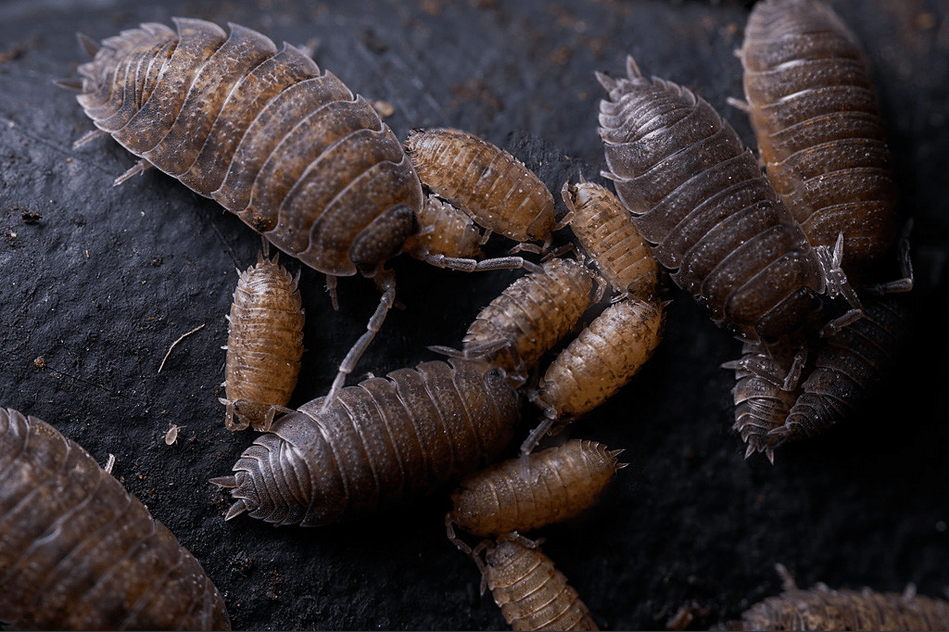 Above photo by [Brian Valentine](https://www.flickr.com/photos/lordv/52608389220/) Another adaptation is breathing via their gills which are located on their hind legs and are always covered with a thin layer of water. As a result they have to live in moist, damp environments. They also prefer to live in groups! 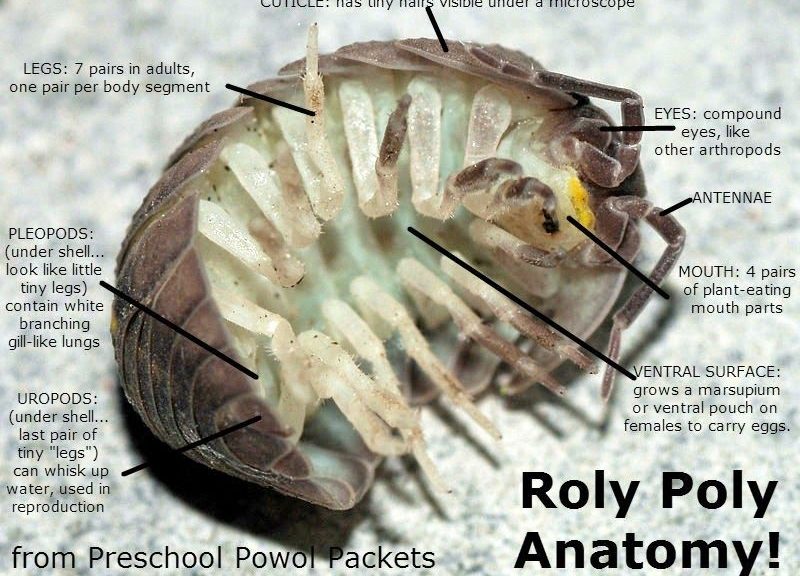 Image [source](https://www.parasuniversal.com/2020/05/interesting-facts-about-woodlice-slaters-pill-bugs-rollie-pollies-roly-polies/) They eat decaying leaves, fungus, mold, and even the droppings of other animals. They help to break down vegetation and organic matter and play an important role in the nutrient cycle! 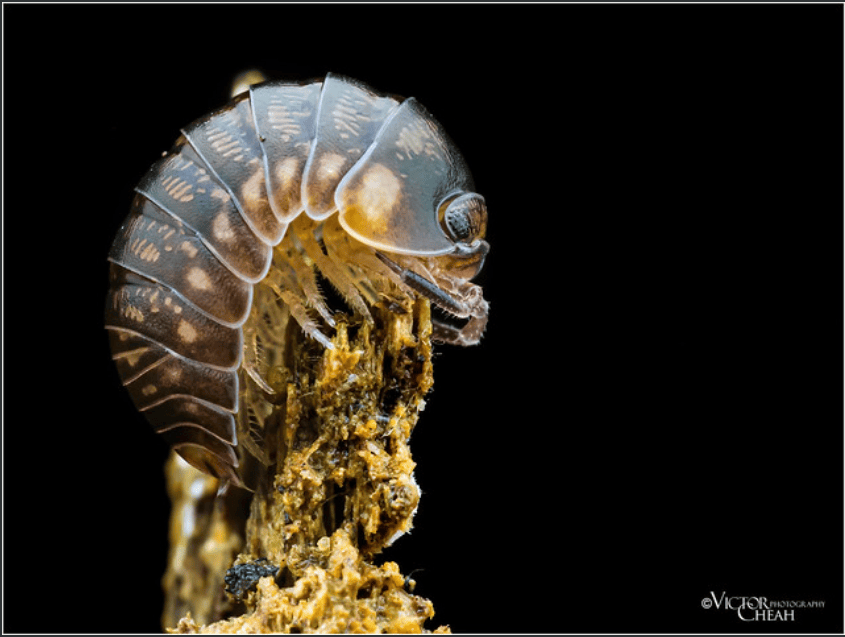 Above photo by [Siew Chuan Cheah](https://www.flickr.com/photos/cscvictor/51720973606/) They need to shed their exoskeleton as they grow, and this molt takes place in two stages. Firstly, the back half is lost, then about 2-3 days later, the front half sheds. Most other athropods shed their cuticles in one go  Above photo by [Max Thompson](https://www.flickr.com/photos/max-thompson/53358363887/) Woodlice can tolerate contaminated soil, unlike most other creatures! >....they can crystallise heavy metal ions midgut like copper, zinc, cadmium, arsenic and lead. This cleans up soil and purifies contaminated water. [source](https://www.parasuniversal.com/2020/05/interesting-facts-about-woodlice-slaters-pill-bugs-rollie-pollies-roly-polies/) Aren't they fab? 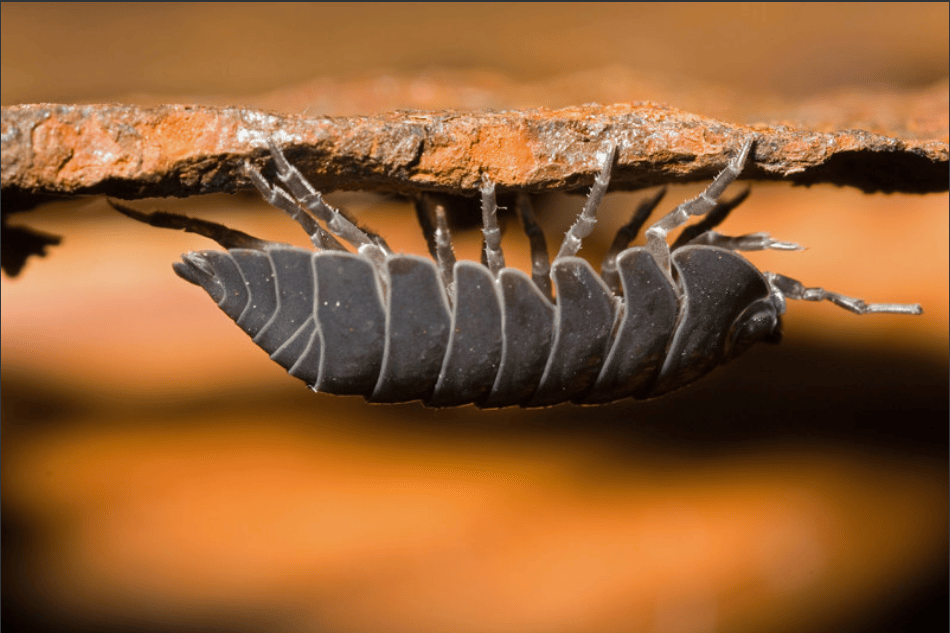 Above photo by [David Graham](https://www.flickr.com/photos/animal168/2775483587/) All information from [wikipedia](https://en.wikipedia.org/wiki/Woodlouse#) [here](https://factanimal.com/woodlouse/) and [here](https://a-z-animals.com/animals/woodlouse/#single-animal-text) unless stated otherwise As always, I'm not an expert, I just like sharing fun things....also this is my first post with my new mander account....woooo! edit- 'one pair of legs'